Honorees have a brick engraved with their name and placed around the flagpole of the entrance to the Montana DNRC Forestry Division Headquarters. Montana Forestry Pioneer Nomination Form
Forestry Pioneers
Forestry Pioneer
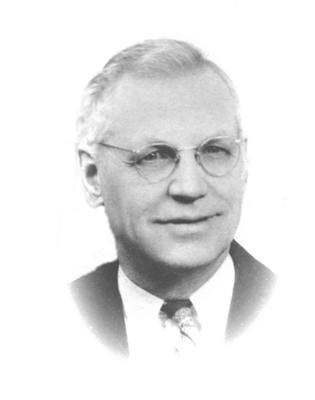
He was also a member of the Forest Products Research Society. He was a Mason, a past Commander in the American Legion, and a member of the Knights Templar. He had two daughters and two sons.
As one of the early employees of State Forestry, Anderson and Fred Metcalf were in the Army together, and both survived the torpedoing of troopship Tuscania off the coast of Ireland in 1918. Interestingly, they served in the 20th Engineers in France, the same outfit as Governor J. Hugo Aronson (they did not know him at the time, however).
While in France, he studied engineering at Toulouse University. He also had a B.S. in Chemistry, a B.S. in Civil Engineering, and was Phi Beta Kappa.
Forestry Pioneer
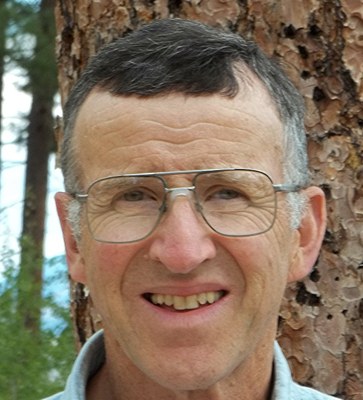 Stephen Arno was raised in a forest setting and according to his mother’s diary loved hiking and playing in the forest when he was two years old. He began supplying his mother’s favorite fuel for her kitchen stove at age five by hauling large chunks of thick coastal Douglas-fir bark up a long catwalk from their beach on shores of Puget Sound. By age 11 he was capturing logs that had escaped from log booms using the family’s 11-foot motorboat. He quickly sawed them with a 6-foot crosscut and split them into firewood on the beach to prevent the log patrol from towing them away and keeping the family in ample supply.
Stephen Arno was raised in a forest setting and according to his mother’s diary loved hiking and playing in the forest when he was two years old. He began supplying his mother’s favorite fuel for her kitchen stove at age five by hauling large chunks of thick coastal Douglas-fir bark up a long catwalk from their beach on shores of Puget Sound. By age 11 he was capturing logs that had escaped from log booms using the family’s 11-foot motorboat. He quickly sawed them with a 6-foot crosscut and split them into firewood on the beach to prevent the log patrol from towing them away and keeping the family in ample supply.
Steve has had a life-long love of forests and wise use of them. He earned a B.S. degree in Forestry from Washington State University then continued his education earning a M.S. and a PhD in Forestry and Plant Science with emphasis on forest ecology from the University of Montana in 1970. Steve worked for Bob Pfister helping to develop the forest habitat type classification system for Montana, then spent the next 26 years at the USDA Forest Services Fire Sciences Lab in Missoula. At the Fire Lab Steve studied forest and fire ecology of western forests. The focus of his work was how the natural role of fire shaped and sustained our original forests here in Montana and the inland west. Steve experimented on how to apply combinations of prescribed fire, thinning, and harvesting to promote sustainable forests with desirable attributes of the original forests including large old western larch and ponderosa pine.
Since retiring in 1999 he has written about the West’s native forests and the need for appropriate forest and fuel management. With the help of son’s Matthew and Nathan and his wife Bonnie, he has practiced restoration forestry on the family’s ponderosa pine forest for over 45 years.
Steve has authored more than a hundred of peer-reviewed articles and scientific publications including 11 full length books. Steve has received countless awards and acknowledgements from organizations such as the Montana Tree Farm Program, the Montana Wood Products Association, and the Society of American Foresters. All of this reflects his lifelong dedication, passion, and commitment to the forestry profession.
Forestry Pioneer
 Bob Arnold was born in 1919 in Beatrice, Nebraska. He attended the University of Montana, and earned a B. S. in Forest Management. From June 1, 1942 to December 31, 1945, he served in the U.S. Air Corps as a Flight Officer and Glider Pilot. He received the Air Medal, and participated in glider landings at Normandy and Holland.
Bob Arnold was born in 1919 in Beatrice, Nebraska. He attended the University of Montana, and earned a B. S. in Forest Management. From June 1, 1942 to December 31, 1945, he served in the U.S. Air Corps as a Flight Officer and Glider Pilot. He received the Air Medal, and participated in glider landings at Normandy and Holland.He began with State Forestry July 1, 1949. With the exception of a short stint with J. Neils Lumber Company, he worked continuously in State Forestry until 1977. During that time, he was a Slash Foreman and Scaler, Timber Sale Supervisor, CFM Supervisor, Chief of Timber Management, Chief of Operations, Assistant State Forester, and Deputy State Forester. Bob was an extremely competent forester, and served as a truly key man for many years. He died of heart failure at his home in Missoula, February 27, 1987.
Forestry Pioneer
 In May 2002, Don Artley completed a 27 year career with Montana state government, including 25 years with the Forestry Division. During his career, Don served in numerous positions, including Chief of the Planning Bureau and Deputy State Forester. He culminated his career by serving as State Forester from 1992-2002.
In May 2002, Don Artley completed a 27 year career with Montana state government, including 25 years with the Forestry Division. During his career, Don served in numerous positions, including Chief of the Planning Bureau and Deputy State Forester. He culminated his career by serving as State Forester from 1992-2002.
Don has served on many boards and committees including the NAF Forest Fire Protection Committee, the National Wildfire Coordinating Group, the National Multi- Agency Coordinating Group, and the National Fire & Aviation Executive Board. Don is a member of Xi Sigma Phi, the Society of American Foresters, and the International Association of Fire Chiefs. He was honored by being selected as distinguished alum of University of Montana's College of Forestry and Conservation in 2004. After his retirement, Don went on to serve as the National Fire Director for the National Association of State Foresters (NASF), retiring for a second time in 2007. He and his wife Susanne currently live in Florence, Montana and enjoy raising a small flock of rare breed sheep.
Forestry Pioneer
 Keith L. Beartusk is a proud member of the Northern Cheyenne Tribe and was born in Lame Deer, Montana. He was raised on the Northern Cheyenne Reservation in south-central Montana. Keith is a graduate of Colstrip High School, and received a B.S. Degree in Forestry from the University of Montana College of Forestry in 1971. Keith also completed the Continuing Education in Forest Ecology and Silviculture (CEFES) Program in 1982, attending graduate sessions at the University of Montana, and Washington State University.
Keith L. Beartusk is a proud member of the Northern Cheyenne Tribe and was born in Lame Deer, Montana. He was raised on the Northern Cheyenne Reservation in south-central Montana. Keith is a graduate of Colstrip High School, and received a B.S. Degree in Forestry from the University of Montana College of Forestry in 1971. Keith also completed the Continuing Education in Forest Ecology and Silviculture (CEFES) Program in 1982, attending graduate sessions at the University of Montana, and Washington State University.
Keith started working right out of high school as a summer station guard for the Custer National Forest, and then spent three summers as a Smokejumper in Missoula, Montana. During this time, Keith also fulfilled a six year commitment to the Montana National Guard. His initial Forester job was with the U.S. Forest Service at the Canoe Gulch Ranger District on the Kootenai National Forest. In 1972, Keith was hired as the Forest Manager on the Northern Cheyenne Agency, and later as Fire Management Officer for the Bureau of Indian Affairs for the Billings Area Office. In 1992, he served as the Regional Office Director of Trust Services, and then finished his 36 year forestry career as the Regional Director of the BIA Rocky Mountain Regional Office. Keith retired in 2006, and presently resides in Billings, Montana with his wife Debbie.
Keith continues to be an active tribal community member and citizen of Montana that is exemplified by his participation in University of Montana alumni activities (he is on the Alumni Wall of Fame), as a member and trail program field restoration participant with the National Smokejumper Association, serves as a member of the Natural Resource Board for the Northern Cheyenne Tribes, and also serves as a member of the local Conoco Phillips Citizens Advisory Council.
Keith has received recognition and awards for his fire and forest management work that includes: a 1988 Intertribal Timber Council “Earl Wilcox Award” for significant achievement on behalf of Indian people and their forests; a 1992 “secretary’s Stewardship Award for Native Americans” presented by the Secretary of Interior; and a 1996 Department of Interior/Agriculture Certificate of Appreciation for recognition of leadership and outstanding contributions to the 1995 Federal Wildland Fire Policy and Program Review. In 2010, Keith was awarded a “Distinguished Native American Alumni Award: by the University of Montana W.A. Franke College of Forestry and Conservation.
Keith provided leadership in building and maintaining comprehensive science-based forest and fire management programs for the Bureau of Indian Affairs and Tribal Forestry Programs in the Rocky Mountain Region. Keith is recognized as being the first tribal member from Montana or Wyoming to serve as a BIA Regional Director in the Rocky Mountain Regional Office. In his long tenure as the Regional Forestry and Fire Management Officer and Regional Director, he provided leadership for tribal and inter-agency environmental protection, Tribal cultural forest use stewardship, forest resource planning, application of silviculture practices, training and education, wildland fire suppression, and prescribed fire use. Keith also encouraged strong engagement for inter-agency cooperation with fire suppression training, multi-jurisdictional large fire management, support of inter-agency fire dispatching, and full tribal agency personnel participation on Northern Rockies Incident Management Teams activities. Keith provided long lasting leadership in building and maintaining highly professional natural and cultural resource stewardship programs on Tribal agencies across the state of Montana.
Forestry Pioneer
William Beaufait - Biologist/Forester, 1927—2016 (Deceased)
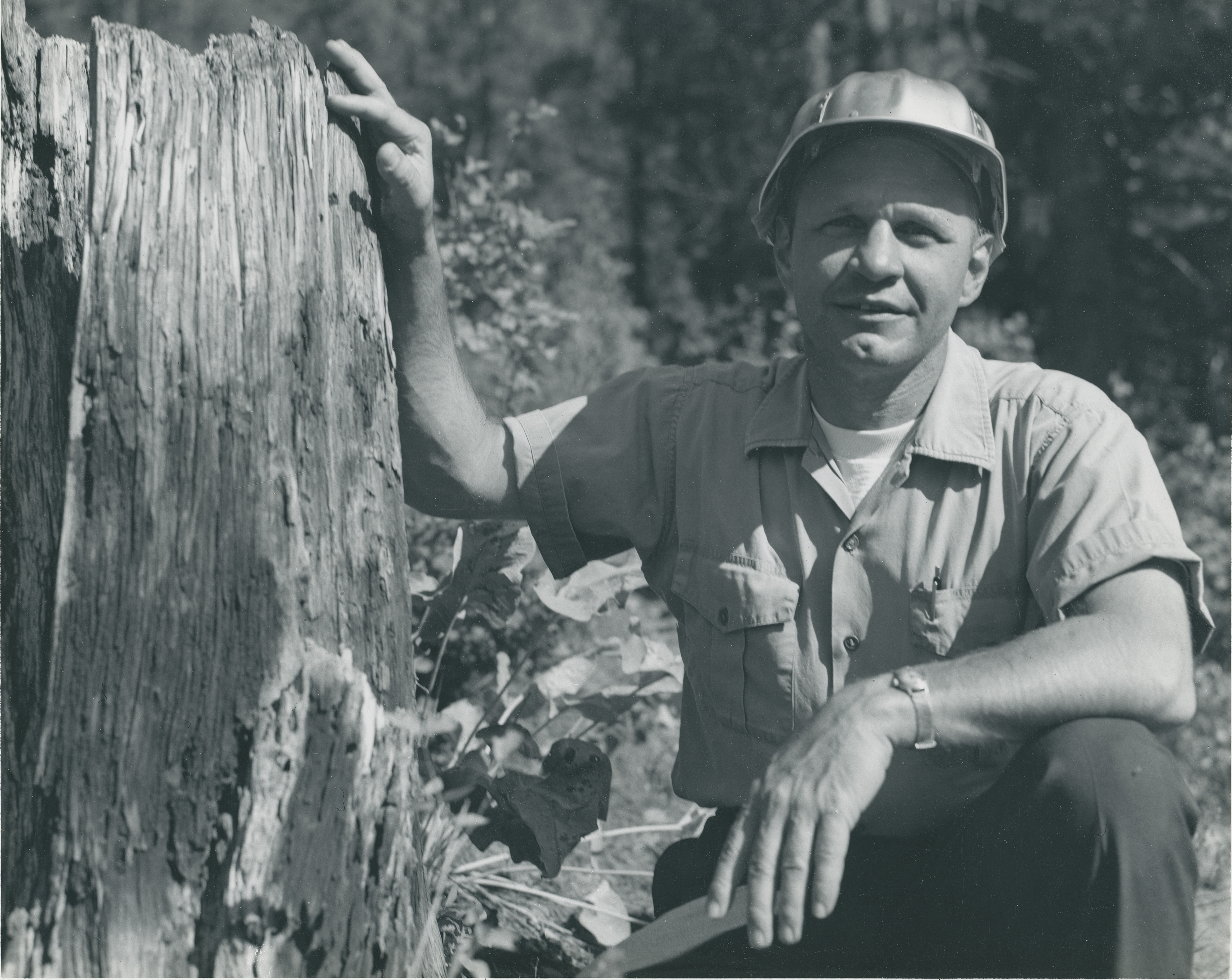 William (Bill) Richard Beaufait passed away October 6, 2016, in Tucson, Arizona. Bill was born to Ilona and Clarence Beaufait on July 25, 1927. With his sister Beverly Beaufait Gillece, Bill spent much of his early childhood traveling during the Great Depression, as his father Clarence, an electrician and later an electrical superintendent moved between many places of available employment during Bill’s youth.
William (Bill) Richard Beaufait passed away October 6, 2016, in Tucson, Arizona. Bill was born to Ilona and Clarence Beaufait on July 25, 1927. With his sister Beverly Beaufait Gillece, Bill spent much of his early childhood traveling during the Great Depression, as his father Clarence, an electrician and later an electrical superintendent moved between many places of available employment during Bill’s youth.
Bill was an Eagle Boy Scout and served as a waterfront director at scout and summer camps on the Great Lakes. He joined the United States Coast Guard in 1945 and was in Times Square on V-J Day. He was discharged when the United States armed services downsized immediately after conclusion of World War II.
Bill attended what is now Wayne State University and obtained a B.S. in Psychology. He then transferred to the University of Minnesota and began studying Forestry. Bill often referred to himself as a “biologist”, graduating with a B.S. in Forest Management in 1952. Bill married Phyllis Hunt Beaufait in 1952. Bill did forest inventory work and other forestry related project work throughout the Southeastern United States through 1956. He returned to the north to pursue his doctorate degree in Forestry at the University of Michigan. Bill earned his Ph.D. in 1960. His dissertation was the “Studies of Fire and Other Factors Related to Jack Pine Regeneration in Northern Lower Michigan”.
After a year of post-graduate work at L’Anse, Michigan, Bill obtained a prescribed fire research position at the Intermountain Forest and Range Experiment Station, Northern Region Fire Laboratory, in Missoula, Montana, in 1961. His research work involved the study of fire behavior under different fuel loadings, fuel moistures, weather conditions, and many other forest environmental factors, with an eye towards increasing site productivity, forest regeneration and improved forest health, through “prescribed fire” use. The research work results specified certain burning conditions and methodologies available to foresters to achieve desired silviculture results in logged areas, for future stand regeneration. Bill studied and promoted controlled burning as a useful forest management tool, which was good for forests and forest health. By 1971, Bill was in line to receive a “Silver Smokey” award from the United States Forest Service for his distinguished work of using “prescribed fire” as a good and useful tool in forest management and silviculture. The National Forest Service award was withdrawn after Bill made public comments about the beneficial use of “prescribed fire” in good forest management, which were contrary to the doctrinal public image and one-dimensional message of “Smokey the Bear” and preventing forest fires by the Forest Service. Bill’s message on the use of “prescribed fire” in silviculture and good forest management was misconstrued by many at the time. Bill continued to promote fire prevention as a necessary part of good forest management, but felt strongly that “prescribed fire” applied appropriately and correctly in forest silviculture, was a good silvicultural tool for a professional forester’s use. “Prescribed fire” was good for forest fuel reduction, site preparation, site productivity and the re-establishment of healthy and productive forest timber stands for the future. Bill did not say that “Smokey the Bear”, a forester, was dead. “Smokey” was still a very important part of the national forest land management’s fire protection program. Bill did promote that “prescribed fire” was a very good silviculture tool for professional foresters in the practice of forest management. At the time, the use of “prescribed fire” for fuel reduction, forest stand regeneration, site preparation and enhancement of site productivity was a new concept for forest land managers. Forest fire protection and the proposed use of fire in forest silviculture can be a very confusing message for the general public, who have been told to prevent all forest fires. Over time Bill and others research proved that “prescribed fire” did have a place and role to play in forest land management of the United States forests. This is still true today.
In 1972, Bill transferred to the position of Region #1 Silviculturist for the Northern Region of the Forest Service in Missoula Montana. Bill would say he was a staff team member of the Regional Forester, helping to “grow trees” on federal timberlands. One of the key challenges of the regional staff team at this point in time was a big push to create a “Continuing Education” program that would reinforce the basic principals of forest silviculture and other scientific disciplines that were not taught or emphasized, by all forestry school curriculums in the early years of forestry education. The forestry profession’s education and teaching requirements needed to be reviewed and evaluated to include current scientific information and technology innovations through a continuing education format. The continuing education format was to be designed for mid-career foresters and resource specialists in federal service. All in an effort to understand and meet today’s ever dynamic forest practice techniques, system ecology, environmental standards and the many changes in land management guidelines. Forest land management and its many associated scientific disciplines were currently all in a very dynamic environment, which was in constant change.
John Milodragovich, R-1 Timber Management Division Chief at the time, was selected by the Regional Forester to lead this important task due to his forestry experience, insight, and commitment in the establishment of a new continuing education program. The program would be initiated for seasoned and mid-career R-1 USFS timber management forester and other related resource management specialists. John asked Bill to lead the effort of developing this new “green start” continuing education program, which he agreed to do. Bill was very interested in the review of the Forest Service’s current continuing education programs, the goals and objectives of a new education program, the new program’s concept and design, and establishment of this new revised and innovative continuing forestry education program for R-1’s resource management personnel. Bill and many others made the selection of faculty members for this continuing educational program and the university locations where classroom and field instruction would be held. The new continuing education program became known as the “Continuing Education in Forestry, Ecology, and Silviculture”, with the acronym “CEFES” (pronounced “see-fus”). Following Bill’s strong belief in the value of education and continuing education, the CEFES program provided an opportunity for Forest Service resource managers and scientific specialists to be exposed and taught current silvicultural and ecology science training, in an academic format and setting. The CEFES program’s classroom and field training was provided through three very intensive month-long on-site rotational training sessions at three Intermountain/Inland regional universities, which had strong forestry and ecology disciplines: the University of Montana, Washington State University, and the University of Idaho. The CEFES program’s first class was initiated in 1973, with graduation and certification completed in late 1974. Many CEFES classes were graduated and certified over the next 20 to 25 years from this wonderful education science program. It was a truly innovative, progressive, and productive educational format for a very successful continuing education program.
In 1981, Bill transferred to California’s USFS Region #5, as the R-5 Regional Silviculturist in Vallejo, California. Bill initiated a very similar and successful CEFES continuing education program in R-5 during his tenure there.
The success of the CEFES program was due to Bill’s leadership and dedication to the educational program. The CEFES program developed into the USFS Certification of Silviculturists, a nationwide effort to promote professional forestry excellence within the resource land management system.
After a very progressive and distinguished USFS forestry career, Bill retired in 1983. He and his second wife Joanne retired in Tucson, AZ. Both are now deceased. Bill is survived by his sister Beverly, four adult children, two adult stepchildren, six grandchildren, and one great granddaughter.
Forestry Pioneer
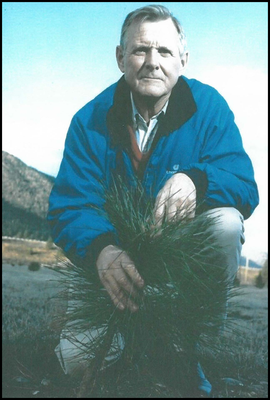
Blaine was born on a dairy farm in Minnesota, where he grew up learning what it meant to work long hours and be dependable. He attended a one room elementary school and graduated from the area high school. At the age of 17, Blaine enlisted in the US Navy. In 1948, Blaine found a summer job at the USFS in Troy, Montana. His plan was to only stay three months and return in the fall to attend the University of Minnesota. But Blaine ended up staying in Montana for the next 67 years. (The most compelling reason was meeting a young lady named Ellen, with whom he just celebrated his 65th wedding anniversary.) Blaine began a gratifying career in Montana in the forest industry, where he worked for 45 years with J. Neils Lumber, which merged into St. Regis Paper Company, and sold to Champion International.
Blaine attributes his success in the timber industry to Mark Schoknecht and George Heils, both excellent coaches and mentors. Blaine was the director and past president of the Inland Empire Logging Conference, a member of the Kootenai Forest Advisory Board, Chairman of the Inland Empire Logging Forest Resource Council Roads Committee, and a member of the Inland Forest Resource Contractor Committee. He also served on the National Forest Products Association Roads and Timber Purchaser’s Committee, he was Chairman of the Northern Montana Fire Protection Association, and served on various western wood products and NFPA committees. Blaine passed away on July 5th, 2023 at the age of 95.
 Forestry Pioneer
Forestry Pioneer
Nearly everyone who spends their career in natural resource management knows about the work of Arnold Bolle. His contributions to the U.S. Forest Service, the Soil Conservation Service, and the University of Montana College of Forestry and Conservation are well documented.
A former Dean of the School of Forestry and Director of the Montana Forest and Conservation Experiment Station, Dr. Bolle was a pioneer in his work related to the integration of public administration and natural resource management.
He was a life-long conservationist and passed away in 1994.
 Forestry Pioneer
Forestry Pioneer
Maurice was born in December of 1907 in Kalispell. He served for many, many years at the head of the Northern Montana Forestry Association, and retired in 1972.
He is remembered as a tremendous influence to good forestry in Montana, and a good friend of Montana State Forestry. Maurice died in Kalispell on April 2, 1978.
Forestry Pioneer
Dale Bosworth was raised in northern California, the son of a Forest Service employee. He graduated from the University of Idaho in 1966 with a degree in Forestry and immediately joined the U. S. Forest Service.
Dale served in a variety of positions in Idaho, eastern Washington and Montana, including District Ranger of the Powell Ranger District near Lolo Pass. In 1986 he became Forest Supervisor of the Wasatch-Cache National Forest in Utah.
Dale later served in Washington DC and California and in 1994 became Regional Forester of the Intermountain Region of the Forest Service headquartered in Ogden, Utah. In 1997 Dale became Regional Forester for the Northern Region in Missoula. He was named Chief of the Forest Service in 2001 where he served until he retired in 2007 after 41 years with the agency.
Since retirement he does volunteer work for the Forest Service’s International Programs. Dale resides in Missoula with his wife Carma.
Forestry Pioneer
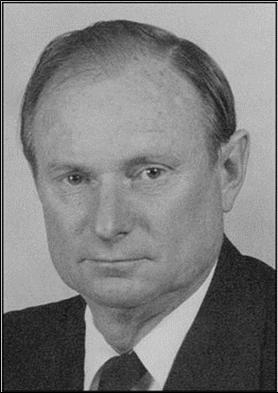
Gary Brown was born on July 10, 1933 at Hays Springs, Nebraska. He served in the United States Air Force from 1951 to 1955. He started his 31-year professional forestry career with Montana State Forestry in 1960, after several seasonal positions with the organization while attending the University of Montana Forestry School, where he earned a B. S. in Forestry. Gary served as Assistant Supervisor of the Swan River State Forest, Timber Management Assistant in Kalispell, Supervisor of the Swan River State Forest, Forest Management Assistant, Management Forester in Missoula, District Forester in Helena, Area Forester in Helena, Forest Use Supervisor in Missoula, Cooperative Projects Bureau Chief, and Assistant State Forester.
Gary received many professional honors from the Society of American Foresters, University of Montana Forestry School, U.S. Forest Service, and the National Museum of Forest Service History. He was chairman of many forestry committees and associations, including the School of Forestry's Dean's Advisory Committee, SAF, National Association of State Foresters, Montana Woodland Council, and the Montana State Rural Areas Development Committee. Gary died of lung cancer in March of 2010.
Forestry Pioneer
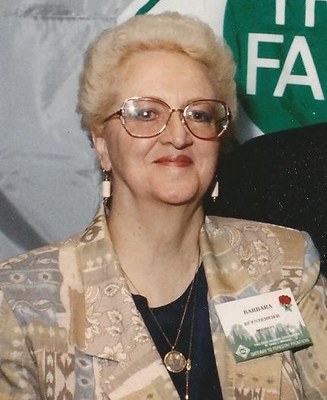 Barbara has been one of the most influential women in the Forest Products Industry for Montana and across the Western United States for that matter. Barbara arrived in Montana in 1946 as a young girl and her parents settled in Columbia Falls, Montana. Out of high school she married into a logging family and spent her early years cooking for her husband’s logging crew in the North Fork of the Flathead River near Coal Creek. She kept the books for their logging operation and road construction company and raised 2 children while juggling 4-H Clubs and various other jobs.
Barbara has been one of the most influential women in the Forest Products Industry for Montana and across the Western United States for that matter. Barbara arrived in Montana in 1946 as a young girl and her parents settled in Columbia Falls, Montana. Out of high school she married into a logging family and spent her early years cooking for her husband’s logging crew in the North Fork of the Flathead River near Coal Creek. She kept the books for their logging operation and road construction company and raised 2 children while juggling 4-H Clubs and various other jobs.
In 1975, she was remarried to Ronald Buentemeier, forester for F.H. Stoltze Land and Lumber Company. At this point, Barbara became a very active advocate for the timber products industry and she was the first President of the Montana Women in Timber Chapter which she helped start in 1979. She went on to serve as President of the Federated Women in Timber which included 12 Western States and thousands of active women at the time. Her work took her to Washington D.C. where she and other Federated Women in Timber were lobbyists helping inform legislators of the importance of forest management.
The Montana Logging Association honored Barbara in 1985 as the “Woman of the Year” for her efforts and hard work to promote education regarding forestry, forest products, and benefits of forest management to local Montana communities and schools. She enjoyed setting up education projects, fair displays and working on annual funding for Women in Timber as well as Family Forestry Expo. Barbara was a very creative and organized individual and blessed the Women in Timber group with many innovative ideas and talents. She was a great example of making sure people received a positive message about the Timber Industry and emphasized how important it is to the health of our families, our communities, our forests and our country!
Barbara Buentemeier was born April 15th, 1932, and passed away December 19th, 2011.
Forestry Pioneer
 Ron was born in Deer River, Minnesota, October 9, 1941 and his family moved to the Flathead Valley in 1945. He attended school in Columbia Falls, graduating in 1959. He attended the University of Montana in Missoula, majoring in Forest Engineering. Ron worked for the Flathead National Forest as an Engineering Technician in the summers while attending college. He graduated from the University of Montana in 1963 and was a graduate assistant in 1964. Ron began working for the Anaconda Company (ACM) in the Pleasant Valley area of Northwest Montana in 1963 as an Engineer Forester. He then went to work for F. H. Stoltze Land & Lumber Co. in Columbia Falls in 1964 as a Forest Engineer. He was promoted to General Manager/Vice President in 2002. He retired in 2007 after 43 years.
Ron was born in Deer River, Minnesota, October 9, 1941 and his family moved to the Flathead Valley in 1945. He attended school in Columbia Falls, graduating in 1959. He attended the University of Montana in Missoula, majoring in Forest Engineering. Ron worked for the Flathead National Forest as an Engineering Technician in the summers while attending college. He graduated from the University of Montana in 1963 and was a graduate assistant in 1964. Ron began working for the Anaconda Company (ACM) in the Pleasant Valley area of Northwest Montana in 1963 as an Engineer Forester. He then went to work for F. H. Stoltze Land & Lumber Co. in Columbia Falls in 1964 as a Forest Engineer. He was promoted to General Manager/Vice President in 2002. He retired in 2007 after 43 years.
Ron's been very active in the Society of American Foresters since joining in 1964. He's been Vice Chair and Secretary for Flathead Chapter and Secretary for Montana SAF. He was one of the first certified foresters in Montana; nationally he's number twenty. His abilities have resulted in receiving the Flathead Forester of the Year, the Employer Recognition award, National SAF Fellow award in 1994, Flathead Chapter Field Forester and National Presidential Field Forester awards. He's been very active in the Montana Tree Farm Program since 1975 and served as President for four years. He was one of the original instructors and was a certified advisor of the Montana Forest Stewardship Program. He's received many awards, including recognition from the American Forest Foundation, the Montana Wood Products Association, Timber Processing Magazine, and the Intermountain Logging Conference.
To remain current with field forestry applications, he is currently a Supervisor with the Flathead Conservation District, and he's a member of the Flathead County Natural Resource Committee and the Forest Service Resource Advisory Council. He's been helping the MT Forest Products family manage their land. Ron's been working on his tree farm, cutting some down and building fence. He's been pounding out bullet holes, beating out dents, and painting a 45 foot lookout tower that was recently lifted into place across the driveway from his house.
Forestry Pioneer
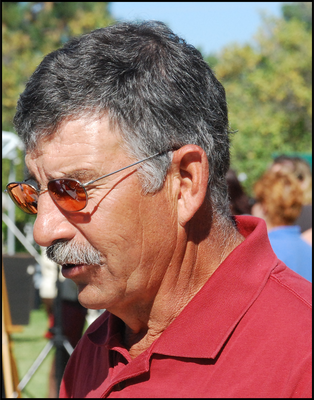 Mr. Burger grew up in Missoula, where he attended grade school, high school, and the University of Montana. He married Diane Casto in January 1967, and they now have three grown children with spouses and six grandchildren. After 38 years he retired as LTC from the Montana Army National Guard with Army Master Aviator Wings and several commendations. He retired a second time with over thirty years of service as DNRC's chief pilot.
Mr. Burger grew up in Missoula, where he attended grade school, high school, and the University of Montana. He married Diane Casto in January 1967, and they now have three grown children with spouses and six grandchildren. After 38 years he retired as LTC from the Montana Army National Guard with Army Master Aviator Wings and several commendations. He retired a second time with over thirty years of service as DNRC's chief pilot.
Rick completed the Federal Aviation Administration commercial and instructor flight course at Ag Aviation Academy in 1967, and then Army Aviation Flight training at Fort Rucker Alabama in 1970. He was privileged to receive mountain flight training and multi-engine rating training from Jack Hughes of Johnson Flying Service (the pioneers in fire flying and mountain flying) in Missoula, MT in 1970.
Rick began flying in October 1967, and was employed by Executive Aviation in Missoula from 1968-1971. He worked for Montana DNRC from 1971 until 2001. He accumulated over 14,000 hours in all aspects of natural resource aviation.
In his retirement, he is still flying and is instructing mountain flying and mountain search pilot clinics for the state. His greatest joy is flying his grandchildren in his antique airplane. He and his wife Diane bought a fifth wheel RV and when they're not at home working on their ten acres they are traveling.
Forestry Pioneer
 Pat Connell was born and raised in Santa Monica, California. He currently lives in Hamilton Montana with his wife Patricia. Pat and Patricia have two grown sons and three grandchildren. Pat earned an AS in Electronic Technology at Southwestern College in 1969. He then came to the University of Montana and completed his degree there with a B.S. in Resource Conservation in 1973.
Pat Connell was born and raised in Santa Monica, California. He currently lives in Hamilton Montana with his wife Patricia. Pat and Patricia have two grown sons and three grandchildren. Pat earned an AS in Electronic Technology at Southwestern College in 1969. He then came to the University of Montana and completed his degree there with a B.S. in Resource Conservation in 1973.
Pat worked as a Log Buyer / Forester at American Timber Company in Olney Montana. He next went to work for St. Regis Paper Company in Libby Montana. His career included stints with Idaho Pole Co, Brand S Corp, and resident manager for New Homestead Log Co at Payette Idaho. He then accepted the position of Resource Manager for Rocky Mountain Log Homes in Hamilton Montana, and eventually became their Vice President of Resource Operations. Pat bought timber for Rocky Mountain’s Hamilton operations from throughout the western United States and the Canadian provinces. Pat left his position with Rocky Mountain in 2009 after nearly 22 years and founded his own forestry consulting business, Timberland Forestry Services in Hamilton Montana.
Pat became active on the Montana political stage in the Bitterroot Valley as a Precinct Captain in the Ravalli Republican Central Committee. From here he went on to represent Ravalli County in the Montana State Legislature for nearly 10 years, first as a House Representative for District #87 for two terms, and then as a Senator for two terms for Senate District #43. During his legislative tenure, Pat was on or chaired key legislative committees in both the House and the Senate, such as: Business, Labor and Economics, Energy and Technology, Natural Resources, Water Policy, and other legislative assignments.
Pat was instrumental in passing the following key legislative items—the bill sponsorship and passage of HB #354, which a was to establish a permanent State Wildfire Suppression Fund (2013). This bill stated that any General Fire Funds appropriated, but not spent for Fire Suppression in a biennium, as well as a percentage of any unobligated General Funds would be considered for Wildland Fire Suppression activities, and to prevent future fire risk projects around the State. The cap for the Wildland Fire Suppression Account could not exceed $100 million dollars. This funding would allow for ongoing and proactive fire protection activities to be planned, prioritized and funded for future fire prevention benefits. The permanent establishment of this fund has prevented any need for a special legislative session to pay for wildfire suppression costs. Other programs Pat worked on and was a leader in were required BMP/SMZ protection legislation and updates, Streamside Protection legislation, and numerous other Resource legislation, Forestland Taxation, Trucking and Truck Weight legislation, Wood Product use legislation for “Montana Made Products” in state highway construction projects, as well as many other key forestry and forest product bills.
Pat received the Montana Wood Products Association “Timberman of the Year” Award, and the “Stewardship Partner” Award from the Rocky Mountain Elk Foundation.
Pat has been active and a member of the Society of American Foresters, and as an SAF CFE certified forester, an Associate member of Montana Wood Products, a member of the Rocky Mountain Elk Foundation, Ducks Unlimited, NRA Life member, trustee of the Corvallis Rural Fire Department, member of the Ravalli County Resource Advisory Committee for the USDA, and numerous other civic, community, and church leadership positions in the Bitterroot Valley.
Forestry Pioneer
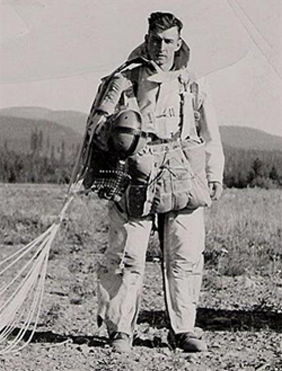 Earl started Forestry School at the University of Montana in 1937, and worked for the Forest Service during summers as a fire guard. In 1940 an Experimental Smokejumping Project was started in Region 1 and Region 6. Earl and Rufus Robinson made the first fire jumps on Martin Creek on the Nez Perce Forest.
Earl started Forestry School at the University of Montana in 1937, and worked for the Forest Service during summers as a fire guard. In 1940 an Experimental Smokejumping Project was started in Region 1 and Region 6. Earl and Rufus Robinson made the first fire jumps on Martin Creek on the Nez Perce Forest.
Earl graduated from U of M Forestry School in 1941. in 1942, he was given an occupational deferment to continue fighting forest fires. By the spring of 1943 there was a man power shortage to fight forest fires so volunteers were solicited from the Civilian Public Service Program. Earl trained conscientious objectors to become squad leaders and riggers for all the regions. One of the greatest tragedies of his life was on August 5, 1949. Earl was the spotter on the Mann Gulch fire.
In fall and winter of 1944 he served briefly on the Kootenai Forest in Libby, MT and then worked out of Missoula until 1950 when he became the District Ranger of the Red River District on the Nez Perce National Forest in Idaho. In 1955 he became the ranger of the Noxon Ranger District that included the Cabinet Wilderness. In 1958 Earl returned to Missoula as the Smokejumper Base Superintendent. In 1971 he wasn't quite ready to retire from the forest service so he became a Regional Equipment Specialist. He was quite proud of some of his inventions including a portable toilet and a tanker capable of applying 1000 gallons of retardant rather than the previous 300 gallon capacity. He retired from the Forest Service in 1975.
After the forest service Earl started his own business, Cooley Realty and sold real estate into the 1990's. In 1984 he completed his memoirs in a book entitled, "Trimotor and Trail". He also served as the first President of the National Smokejumper Association from 1993-1995.
Earl spent his last years at home under the care of his daughters and wife Irene and Hospice. He passed away November 9, 2009 at 98 years of age.
Forestry Pioneer
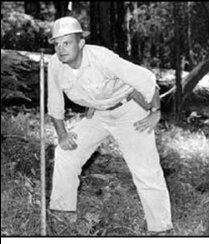 Ernie attended universities in West Virginia, Colorado and Montana, earning two bachelor's degrees in Biology and a B.S. in Forestry. He worked for the Forest Service in the summer of 1939 as a CCC member and returned in the summers of 1941 and 1942.
Ernie attended universities in West Virginia, Colorado and Montana, earning two bachelor's degrees in Biology and a B.S. in Forestry. He worked for the Forest Service in the summer of 1939 as a CCC member and returned in the summers of 1941 and 1942.
After college he worked for J. Neils, Anaconda Company and Champion International Timberlands, where he was West Coast Vice President when he retired in 1989. He was a member of the Society of American Forestry from 1950 until his death in 2006, and was president of the Missoula Chapter in the 1960s.
The Society of American Foresters named him a fellow in 1979 and he was president of Western Forestry the same year. He was an active member of the Montana Logging Association, and a board member of the Forest History Society, the Forest History Museum and the Blackfoot Forest Protective Association Suppression Board. He has received awards from the University of Montana including a Pantzer Award, Distinguished Alumni, a 1995 President's Day award, and recognition from the Forestry School for Outstanding Contributions to Forestry.
In his retirement, Ernie continued to serve his community as a Meals-On-Wheels volunteer, the St. Patrick Hospital Advisory Board, the Forest History Society, the University of Montana Excellence Fund, and the YMCA Board.
Ernie passed away May 2, 2006 at the age of 85.
Forestry Pioneer
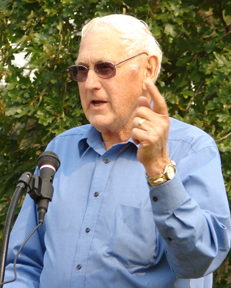 Bill Crismore was born and raised in Hot Springs, Montana and graduated from high school in 1952. In 1954, Bill moved to Libby where he worked at logging jobs and for the Montana Highway Dept. for several years. In 1972 Bill and his wife Carol started Crismore Logging. They brought Forest Service and Montana state timber sales and sold the logs to area mills. Bill loved working in the woods and liked and respected the people he worked with. When logging slowed down they expanded the business to include road building and maintenance.
Bill Crismore was born and raised in Hot Springs, Montana and graduated from high school in 1952. In 1954, Bill moved to Libby where he worked at logging jobs and for the Montana Highway Dept. for several years. In 1972 Bill and his wife Carol started Crismore Logging. They brought Forest Service and Montana state timber sales and sold the logs to area mills. Bill loved working in the woods and liked and respected the people he worked with. When logging slowed down they expanded the business to include road building and maintenance.
Bill has always been a supporter of his community. For many years he and his crew donated work, logs, equipment and money to support Libby Logger Days. He is a past board member of the Montana Wood Products Association, the Libby Area Chamber of Commerce and St. John's Lutheran Hospital. Bill was president of the Montana Logging Association from 1989 until 1991. He was elected to the Montana State Senate in 1995 and served until term limits sent him home.
Bill and Carol have 7 children, 19 grandchildren and are now enjoying their great grandchildren.
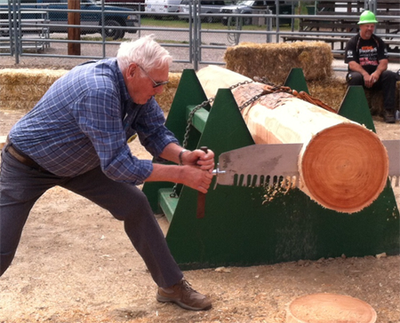
Forestry Pioneer
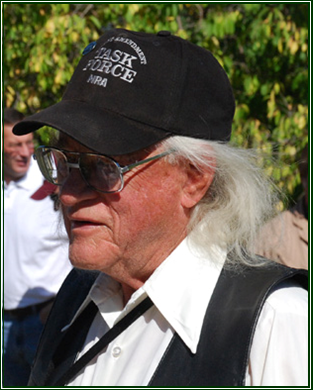 Bob was a paratrooper during World War II, and made numerous jumps in combat situations. He jumped behind enemy lines during the D-Day invasion at Normandy Beach. He later jumped into Holland. He then jumped into the Battle of Bastogne, where he and his fellow soldiers were surrounded by German forces. They were rescued by General Patton, and spent the rest of the war fighting under his command.
Bob was a paratrooper during World War II, and made numerous jumps in combat situations. He jumped behind enemy lines during the D-Day invasion at Normandy Beach. He later jumped into Holland. He then jumped into the Battle of Bastogne, where he and his fellow soldiers were surrounded by German forces. They were rescued by General Patton, and spent the rest of the war fighting under his command.
After the military, Bob went on to earn his bachelor's degree in Forestry from Penn State College in 1951. He road his motorcycle back and forth across the upper U.
S. to Missoula to spend his summer months between school semesters as a smokejumper. He served as a smokejumper with the U.S. Forest Service until 1949. Bob knew many of the smokejumpers killed in the 1949 Mann Gulch Fire north of Helena. He worked for Missoula White Pine Sash Company for many years before coming to work for Montana State Forestry about 1972 as a Forest Marketing Specialist. In this capacity, he also was involved with the management of the Conservation Seedling Nursery and Ponderosa Pine Seed Orchard.
Bob left State Forestry to sell insurance for New York Life. He was a Scout Commissioner for many years with the Mullan Trail District. He volunteered for many years at the State Veterans Home in Miles City.
Bob passed away on July 29, 2017.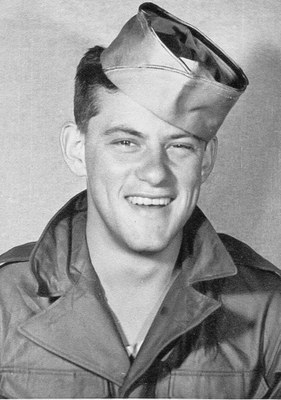
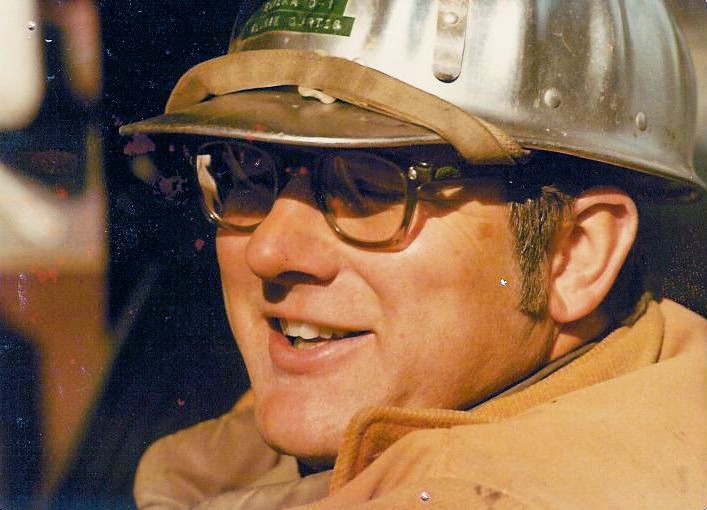 George Curtis graduated from the University of Minnesota in 1958 with a B.S. in Forest Management. He joined the Forest Service, U.S. Department of Agriculture, Kootenai National Forest, Troy Ranger District in 1958. In 1962, he moved to the Eureka Ranger District where he worked as the Fire Management Office until he retired in 1994.
George Curtis graduated from the University of Minnesota in 1958 with a B.S. in Forest Management. He joined the Forest Service, U.S. Department of Agriculture, Kootenai National Forest, Troy Ranger District in 1958. In 1962, he moved to the Eureka Ranger District where he worked as the Fire Management Office until he retired in 1994.
While at the Eureka Ranger District in the mid-1970’s, George Curtis established an aggressive forest health restoration effort using prescribed burning and timber harvest. By 1997, George's Eureka Ranger District had burned more than 95,000 acres for ecosystem restoration, wildland-urban interface, and hazardous fuels reduction. George is credited with burning 55,000 of those acres as the Fire Management Officer. Consequently, in 1997, George and his prescribed fire crew on the Eureka Ranger District received the National Prescribed Fire Award from the U.S. Forest Service and National Interagency Fire Center (3 years after he retired). This award is bestowed in recognition of extraordinary contributions to the advancement of using prescribed fire for ecosystem health. Because of his expertise, George also worked with the Fire Lab in Missoula where among other things he co-authored the “Guide to Understory Burning in Ponderosa Pine-Larch-Fir Forests in the Inter-mountain West” that earned him national recognition, a trip to Washington DC and receipt of a national award from Al Gore.
George’s prescribed fire program in Eureka was the impetus that started the Rocky Mountain Trench Prescribed Fire Council. This council had federal entities from both sides of the border with one of its purposes to coordinate cross-border smoke issues associated with prescribed burning.
For many years, George served as an instructor at the Prescribed Fire Management and Fire Effects Course conducted in Missoula for all agencies and the private sector. George had a unique ability to both practice his profession, and teach his profession. George is unique in that he became an expert practitioner of prescribed burning in forest types that not normally included prescribed burning as a management practice. He then mentored others and trained several foresters and fire managers to master prescribed burning. This included foresters and fire managers from other agencies and the private sector. George was always willing to help anyone become a better burn boss. He also worked with academia and research professionals in developing common-sense guidelines to assist all agencies in and out of Montana with prescribed burning.
George is nationally recognized as a pioneer in the field of prescribed burning by “Fire Management Today Journal” in 2023, and federal agencies.
Forestry Pioneer
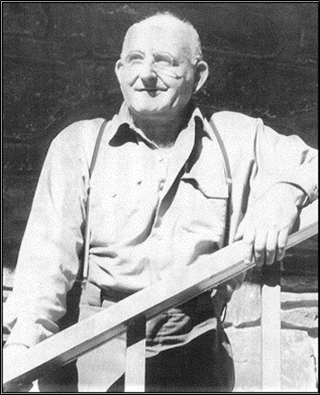 Maurice Cusick was born in 1909 in Vermillion South Dakota. He started with State Forestry on April 15, 1928, and retired on April 24, 1975. He moved from laborer to packer to brush foreman to CCC enrollee to CCC foreman.
Maurice Cusick was born in 1909 in Vermillion South Dakota. He started with State Forestry on April 15, 1928, and retired on April 24, 1975. He moved from laborer to packer to brush foreman to CCC enrollee to CCC foreman.
In 1931, a forest fire struck his family homestead and destroyed it. "Our house burned, the posts and fence around the yard burned, and there weren't even any ashes left from the post hole. You could see the prints of the knots right in the clay where they had burned out just red like a brick. My mother did manage to get all the clothes and bedding out of the house, and she threw them in the well and covered the well with boards. The well was dry and the clothes and all the bedding burned up. When I cleaned the well I suppose I took a bushel basketful of nothing ubt buttons out of there."
This event may have influenced Cusick's career choice as he was named Firewarden in the Stillwater State Forest in April of 1936, a job he held until 1952. After a short stint with the Diamond Match Company, he was again named Forest Firewarden in December 1954, and served in that capacity until 1967, when he was named Supervisor at the Swan River State Forest in charge of the Swan River Youth camp operations from 1968 to 1975. He was married and had two children.
Forestry Pioneer
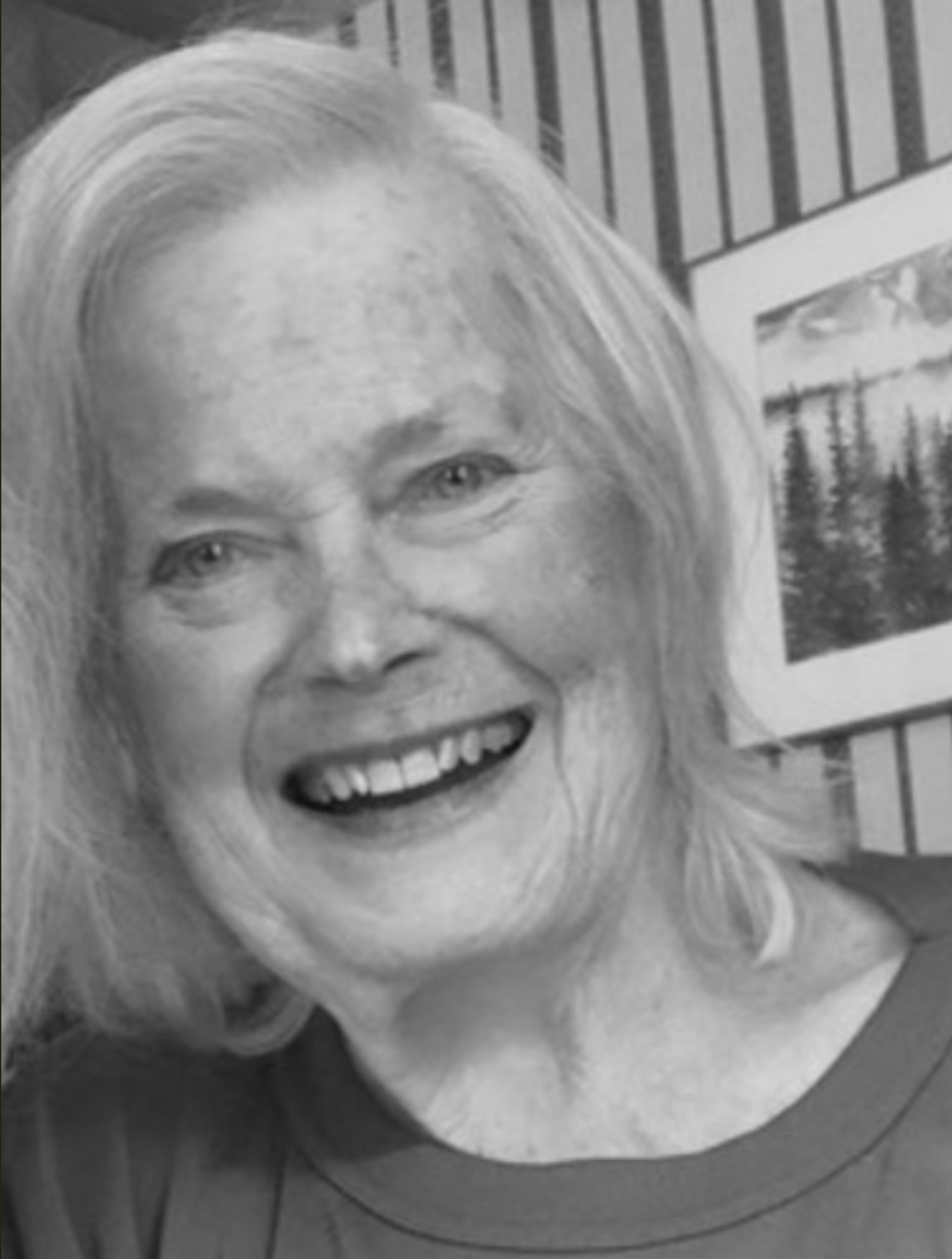 Carol Daly made significant contributions to Montana forestry beginning in the early 1990’s as director of the Sustainable Forests Task Force, funded by the healthy forest products economy and healthy environment in the Flathead Valley. Carol’s tireless efforts and leadership for over a four-year period paved the way for a pilot project which led to the first “stewardship” timber sale in the nation on the Flathead National Forest in the Cedar Flats area near Columbia Falls Montana, where the federal government could exchange goods (timber value) for services. This garnered so much attention that the Undersecretary of Agriculture and a Montana Congressional Delegation conducted a site visit to the project area. This first of its kind stewardship timber sale laid the foundation for stewardship timber contracting across the United States by federal, state, and local governments. Thanks to Carol’s early work, the Flathead National Forest still has an active stewardship timber sale program.
Carol Daly made significant contributions to Montana forestry beginning in the early 1990’s as director of the Sustainable Forests Task Force, funded by the healthy forest products economy and healthy environment in the Flathead Valley. Carol’s tireless efforts and leadership for over a four-year period paved the way for a pilot project which led to the first “stewardship” timber sale in the nation on the Flathead National Forest in the Cedar Flats area near Columbia Falls Montana, where the federal government could exchange goods (timber value) for services. This garnered so much attention that the Undersecretary of Agriculture and a Montana Congressional Delegation conducted a site visit to the project area. This first of its kind stewardship timber sale laid the foundation for stewardship timber contracting across the United States by federal, state, and local governments. Thanks to Carol’s early work, the Flathead National Forest still has an active stewardship timber sale program.
Carol was also a member of the Communities Committee and Western Governors Association where she was instrumental in writing the Healthy Forest Restoration Act (HFRA) and Community Wildfire Protection Plan guidelines. She was selected by her Society of American Foresters and Communities Committee peers to testify to the United States Congress. From Carol Daly’s testimony: “While the issue on which I am to testify about today is focused around community planning and collaboration, it has far reaching forest management implications. Thus, I am representing not only the Communities Committee but am also representing the views of the Society of American Foresters, professional foresters who have a deep commitment to stewardship of our forest resources.”
Carol founded the Flathead Economic Policy Center in 1995, with her Western Governor Association connections and passion for assisting communities. The forest products industry developed the framework for receiving grant funding from the federal government and State of Montana to financially assist private landowners in the implementation of forest improvement projects for forest health and fuels reduction. Carol was a leader in developing programs that would move forward and be modeled across the nation. This program assisted communities in Flathead, Lake, Lincoln, and Sanders Counties for close to three decades improving forests and reducing fuel loading on at least 5,000 acres of private lands, many of which were small parcels that would not have been economically feasible without the 3 million dollars plus, in financial assistance. Carol was a visionary in developing Fire Safe Councils across the State of Montana which are still active today, including Fire Safe Montana, Fire Safe Flathead, and Lincoln County Fire Safe Council. This laid the foundation and model for many fire safe councils across the state of Montana. She wrote the initial community wildfire protection plans (CWPP) for Flathead County, Whitefish, North Fork, and assisted with Lake and Lincoln counties CWPP’s.
Carol was a visionary in developing Fire Safe Councils across the State of Montana which are still active today, including Fire Safe Montana, Fire Safe Flathead, and Lincoln County Fire Safe Council. This laid the foundation and model for many fire safe councils across the state of Montana. She wrote the initial community wildfire protection plans (CWPP) for Flathead County, Whitefish, North Fork, and assisted with Lake and Lincoln counties CWPP’s.
Carol donated approximately $100,000 to different organizations she was passionate about, after her passing, one of which was the North Fork Firewise Committee (Polebridge, MT). Carol never paid herself a dime for all the work she did with Flathead Economic Policy Center. She wanted to ensure that she made the greatest impact, which shows just how humble and selfless she was, and how much she cared. We are very fortunate Carol was passionate about forestry and wildfire issues, and that she helped lay a robust foundation for us to build on.
Several of Carol’s peers and friends have been honored as Montana Forestry Pioneers. The FireSafe Flathead group thought it would be fitting for her to be recognized and honored with them.
Forestry Pioneer
 Orville has been an important voice in Montana forestry for well over 30 years. He began his Montana service as the Supervisor of the Bitterroot National Forest. He then moved to Missoula as the Supervisor of the Lolo National Forest where he stayed for over 20 years until his retirement in 1996. Throughout his tenure as Forest supervisor Orville was known for his willingness to speak out on important forestry issues, even when he disagreed with national Forest Service direction or policy.
Orville has been an important voice in Montana forestry for well over 30 years. He began his Montana service as the Supervisor of the Bitterroot National Forest. He then moved to Missoula as the Supervisor of the Lolo National Forest where he stayed for over 20 years until his retirement in 1996. Throughout his tenure as Forest supervisor Orville was known for his willingness to speak out on important forestry issues, even when he disagreed with national Forest Service direction or policy.
Orville spent his entire forestry career with the U.S. Forest Service. He retired in 1996 and is a member of the Society of American Foresters.
Forestry Pioneer
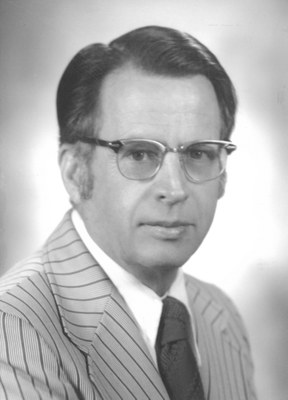 Don was born in 1914 in Arizona. He graduated in Forestry from Utah State University and earned a Masters Degree at Louisiana. He was an instructor at Arkansas Poly-Tech and served in the U.S. Air Corps in World War II. He began with State Forestry in 1955 ultimately serving as Assistant State Forester and Deputy State Forester, and retired in 1974. Don was an extremely gifted artist, and his original oil paintings grace State Forestry offices, as well as the homes of his close friends. He died on September 24, 1975.
Don was born in 1914 in Arizona. He graduated in Forestry from Utah State University and earned a Masters Degree at Louisiana. He was an instructor at Arkansas Poly-Tech and served in the U.S. Air Corps in World War II. He began with State Forestry in 1955 ultimately serving as Assistant State Forester and Deputy State Forester, and retired in 1974. Don was an extremely gifted artist, and his original oil paintings grace State Forestry offices, as well as the homes of his close friends. He died on September 24, 1975.
Forestry Pioneer
The late D.C. Dunham was founder of Plum Creek Lumber Company. DeWitt Clinton Dunham was born in 1895 at Anoka, Minnesota. When he was 13 years old, he went west to Tacoma, Washington, where he worked for Pacific National Lumber Company. He returned to Minneapolis as a salesman for Weyerhauser, and in 1922 was married to Gladys Oakins who died in 1947. In 1957 he married Bernice Fitzgerald Kossoff of Kalispell and Creston.
In Bemidji, Minnesota, D.C. Dunham bought the Bemidji Woods Products Company, a box factory, and this became the D.C. Dunham Lumber Company. World War II was in progress and there was a tremendous market for boxes and lumber. It was in 1944 that Plum Creek Logging Company was incorporated as part of his Minnesota operation. Construction of the Plum Creek Lumber Company mill at Columbia Falls, Montana began in 1945. Depletion of Minnesota’s forest lands, and a location on the Great Northern Mainline were factors in Plum Creek coming to the Flathead Valley. The population in Columbia Falls at the time approached 700.
It took men with imagination and enterprise to build the industry which makes employment and industry possible. No other one citizen created more jobs in the Flathead Valley. Dunham died in 1966, at age 71.
Forestry Pioneer
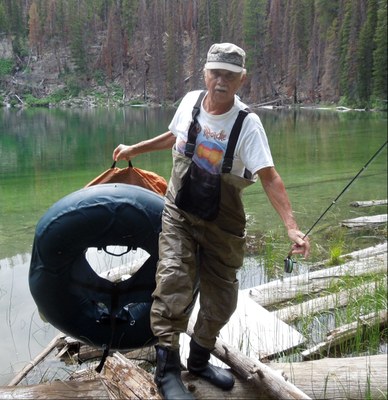 Kenneth is a member of the Confederated Salish and Kootenai Tribes and was born and raised on the Flathead Indian Reservation. He is a graduate of Dixon High School and received a B.S. Degree from the University of Montana School of Forestry in the 1957. Ken spent 36 years working for the Bureau of Indian Affairs as a Forester at Flathead, Yakima and Fort Apache Indian Reservations. He was selected as the Forest Manager for the Flathead Indian Agency in 1977. He led the forest management program until his retirement in 1994. He presently resides in Polson, Montana. He has been awarded a number of awards including the Intertribal Timber Council, 1991 ‘Earl Wilcox Award’ for significant achievement on behalf of Indian people and their forests.
Kenneth is a member of the Confederated Salish and Kootenai Tribes and was born and raised on the Flathead Indian Reservation. He is a graduate of Dixon High School and received a B.S. Degree from the University of Montana School of Forestry in the 1957. Ken spent 36 years working for the Bureau of Indian Affairs as a Forester at Flathead, Yakima and Fort Apache Indian Reservations. He was selected as the Forest Manager for the Flathead Indian Agency in 1977. He led the forest management program until his retirement in 1994. He presently resides in Polson, Montana. He has been awarded a number of awards including the Intertribal Timber Council, 1991 ‘Earl Wilcox Award’ for significant achievement on behalf of Indian people and their forests.
Kenneth provided leadership in building a comprehensive, science-based forest and fire management program for the Confederated Salish and Kootenai Tribes at Flathead Agency. He increased the forestry budget and instilled a high-level of professional standards for a state-of-the art program in natural and cultural resource stewardship that is recognized as a model in ‘Indian Country’ and the State of Montana. He provided leadership for environmental protection, forest planning, application of silviculture practices, training and education, forest research, wildland fire suppression and prescribed fire use. A significant achievement was the development and maintenance of interagency cooperation with neighboring agencies as demonstrated by full partnership with the Montana Department of Natural Resources and Conservation land management of School Trust Lands and the creation and administration of the 1981 BIA/CSKT/State of Montana Fire Protection Agreement on the Flathead Indian Reservation. Ken also instilled a keen sense of interagency cooperation with interagency fire suppression training, multi-jurisdictional large-fire management, and full personnel participation on Northern Rockies Incident Management Teams.
Forestry Pioneer
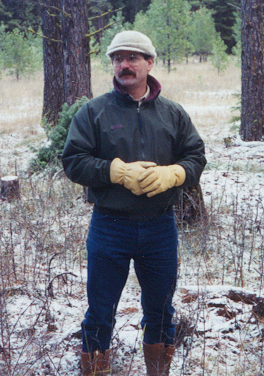 Vic Dupuis was a member of the Confederated Salish and Kootenai Tribes, and was born in 1949 in Seattle Washington, and raised in west-central Montana on the Flathead Indian Reservation in Polson, and in the Missoula area. He was a 1967 graduate of Hellgate High School, and received a B.S. Degree in Forestry from the University of Montana College of Forestry and Conservation in 1976. Vic also completed advanced forestry training in the Continuing Education in Forest Ecology and Silviculture (CEFES) Program in the early 1980’s, attending graduate sessions at the University of Montana and Washington State University.
Vic Dupuis was a member of the Confederated Salish and Kootenai Tribes, and was born in 1949 in Seattle Washington, and raised in west-central Montana on the Flathead Indian Reservation in Polson, and in the Missoula area. He was a 1967 graduate of Hellgate High School, and received a B.S. Degree in Forestry from the University of Montana College of Forestry and Conservation in 1976. Vic also completed advanced forestry training in the Continuing Education in Forest Ecology and Silviculture (CEFES) Program in the early 1980’s, attending graduate sessions at the University of Montana and Washington State University.
Vic was a proud veteran from his service in the United States Navy as a Petty Officer 2nd Class from July 1969 until June 1973 He was an electronics specialist stationed at Whidbey Island, Washington and was deployed twice to the 7th Fleet (USS Kitty Hawk) to waters off Vietnam. In 1975 and 1976 he was a seasonal helitack firefighter crew with the USFS Lolo National Forest. Later in 1976, Vic started his Forester / Silviculturist / Forest Manager career with the Bureau of Indian Affairs, Confederated Salish and Kootenai Tribes on the Flathead Indian Agency in Pablo, Montana.
Vic was the Silviculturist on the USFS Lolo National Forest, Missoula District from 1987 until his untimely death in 1998. Vic is survived by his wife Wendy and their children Ana and Lucas.
Vic was very personable and passionate about his work, and caring for the land. He was an outstanding professional who was highly regarded by his peers and others who worked with him. He provided leadership in applying comprehensive state-of-the-art silviculture treatments for the Tribes and USFS National Forests of western Montana. He was highly a highly skilled and respected silviculturist with an outstanding ability to communicate with Montana interagency land management agencies, professional natural resource organizations, fellow employees, and the public about the biological basis and the ecological need for science-based forest treatment prescriptions. He mentored many young silviculturists and other resource professionals. Having an excellent grasp of forest ecology and physical and biological processes, his prescribed treatments were effective and designed to mimic natural processes. Vic was one of the early implementers of Ecosystem Management in the Northern Rockies Region.
Vic established close working relationships with University of Montana professors and interagency researchers on proposed study areas and research publications. Vic was acknowledged as a valued interagency partner and contributor to local research studies, establishment of forest plot study areas, and ecology and forest treatment publications. He participated in consulting practices that produced visionary methods for establishment of complex silviculture and fuel reduction treatment objectives, data collection procedures, and insightful ideas on monitoring protocols and input on management treatment of current and historical University of Montana Study Plots. Vic’s contributions to insightful and leading-edge silvicultural practices and methods are enduring for State of Montana forest management.
Forestry Pioneer
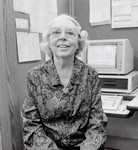 Irene Evers served as the much-loved forestry librarian at The University of Montana from 1959-1997. She began her library career with the School of Forestry in 1959. When Ms. Evers and the school's collection moved to the Maureen and Mike Mansfield Library in 1976, she was named Assistant Science Librarian. Ms. Evers' love for students and faculty kept her working long past the age that most have stopped. Upon her retirement in 1997, she held the distinction of being the University's longest-serving staff employee. Cards and letters poured in from across the country celebrating her contributions to the University community. For nearly two years following her retirement, she continued to volunteer her time doing what she loved best -- helping others.
Irene Evers served as the much-loved forestry librarian at The University of Montana from 1959-1997. She began her library career with the School of Forestry in 1959. When Ms. Evers and the school's collection moved to the Maureen and Mike Mansfield Library in 1976, she was named Assistant Science Librarian. Ms. Evers' love for students and faculty kept her working long past the age that most have stopped. Upon her retirement in 1997, she held the distinction of being the University's longest-serving staff employee. Cards and letters poured in from across the country celebrating her contributions to the University community. For nearly two years following her retirement, she continued to volunteer her time doing what she loved best -- helping others.
During her life, two honors were created at UM in Evers' name: the library's Irene Evers Award for Outstanding Staff Member, in 1993; and the Irene Evers Endowment for Forestry, established on her 80th birthday in 1995. The endowment was started with the contributions of faculty, staff and former students.
"Her guide in life was caring for her patrons," remembers Karen Hatcher, retired dean of library services. "Not all patrons come to the library knowing exactly what they are looking for. Her skill was in eliciting what a person really wanted. People wrote to her from all over the country with reference questions." Evers' colleagues at the library honored her diligence and persistence when they made her the first recipient of the annual Irene Evers Award for Outstanding Staff Member in 1993.
Two years later the Irene Evers Endowment for Forestry was established by the library, forestry school and friends of Irene Evers to celebrate her 80th birthday. It began with contributions from the faculty, staff and alumni who had known her best. One couple who had sought Evers' help as undergraduates in the 1970s wrote, "Your librarianship was not your greatest gift. Your honest regard for each of your students is what we remember." A graduate from the 1960s wrote, "Happy birthday and congratulations to a guiding light that enabled us to do our best."
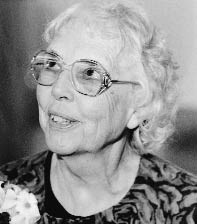 Many of the older faculty and alumni speak warmly of Irene Evers, whom they knew personally and was the woman who served as the forestry librarian for 38 years. She devoted her life to helping forestry students and faculty find answers to their questions. She was the longest serving faculty member retiring at age 81 in 1997. Once, asked by her friends why she did not retire and do what she liked to do, she responded, “Well, this is what I like to do.” Mrs. Evers was described as a “walking inventory of forestry-related material,” who always found reference questions an enjoyable challenge. “I really don’t like not being able to find the answers. It can be frustrating, because you know it’s out there. And if you don’t find the answer, you’re apt to get the question again.” Before the library moved in 1976, it held 6,000 books, 33,000 bulletins, and 312 journal subscriptions, with a world-wide weekly coverage of forestry literature prepared on cards by Oxford University. It was open 71 hours a week. The Forestry Library was significantly different from other collections in the Mansfield Library as it contained thousands of unbound pamphlets catalogued in the Oxford System. In 1957, the library was reorganized as a cooperative effort under the Montana Forest and Conservation Experiment Station and grew to include the library of Region 1 of the USFS, and could be used by their employees as well as the Forestry Division of the Montana Department of Natural Resources.
Many of the older faculty and alumni speak warmly of Irene Evers, whom they knew personally and was the woman who served as the forestry librarian for 38 years. She devoted her life to helping forestry students and faculty find answers to their questions. She was the longest serving faculty member retiring at age 81 in 1997. Once, asked by her friends why she did not retire and do what she liked to do, she responded, “Well, this is what I like to do.” Mrs. Evers was described as a “walking inventory of forestry-related material,” who always found reference questions an enjoyable challenge. “I really don’t like not being able to find the answers. It can be frustrating, because you know it’s out there. And if you don’t find the answer, you’re apt to get the question again.” Before the library moved in 1976, it held 6,000 books, 33,000 bulletins, and 312 journal subscriptions, with a world-wide weekly coverage of forestry literature prepared on cards by Oxford University. It was open 71 hours a week. The Forestry Library was significantly different from other collections in the Mansfield Library as it contained thousands of unbound pamphlets catalogued in the Oxford System. In 1957, the library was reorganized as a cooperative effort under the Montana Forest and Conservation Experiment Station and grew to include the library of Region 1 of the USFS, and could be used by their employees as well as the Forestry Division of the Montana Department of Natural Resources.
Irene Evers died in 1999 leaving a large bequest to the Mansfield Library and the College of Forestry and Conservation to increase the Evers Library Endowment for Forestry, which enables the Mansfield Library to subscribe to journals, to purchase books and to acquire other priority resources needed by natural resource students and scholars. Undergraduate research scholarships were also established in her name by the College of Forestry and Conservation.
Forestry Pioneer
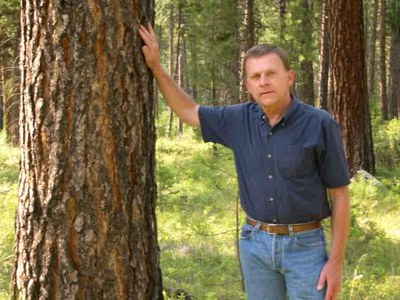
Carl Fiedler grew up “out in the sticks” of rural northern Wisconsin, where he decided in third grade that he wanted to be a forester. He later moved west and earned B.S. and M.S. degrees in forestry at UM.
After a two-year stint in the U.S. Army, he earned his Ph.D. at the University of Minnesota. Carl started his career in 1980 as a research forester with the USFS Rocky Mountain Research Station. In 1982, he took a position as Research Professor of Forest Management at the UM School of Forestry.
Carl installed a selection cutting/prescribed burning experiment on the Bitterroot National Forest in conjunction with the Missoula Fire Lab. He was also the academic member of the national external review team that evaluated research at the Tall Timbers Research Station. He authored a publication with the USFWS listing biologist that proposed active forest management within suitable habitat for the threatened southwestern spotted owl, an approach that also retained the owl’s habitat needs.
Carl worked with Bob Pfister and Jack Ward Thomas to develop old-growth guidelines for managing State Trust Lands. He worked with Charles Keegan modeling and testing (“computer logging”) alternative treatments to reduce wildfire hazard on Montana’s 5 million acres of high-hazard forests.
Carl provided interviews to the BBC, Arizona Republic, Los Angeles Times, Portland Oregonian, Wall Street Journal, and numerous local outlets about options to reduce wildfire hazard in the western U.S.
He was the site leader for a six-year, national Joint Fire Science Program experiment to evaluate wildfire hazard reduction treatments at an operational scale. Carl testified to Congress on the need for active management to reduce wildfire hazard. He also presented professional short courses in numerous western states on thinning, fuel sampling, designing and implementing selection cutting, hazard reduction, and forest restoration treatments.
Carl retired in 2007. He was then invited to present western U.S. approaches to restoration at Sweden’s first-ever conference on forest restoration. He also served as coordinator for the 2010 High-Five Symposium, an international meeting focused on the ecology, management, and sustainability of the world’s five-needle pines.
Carl co-authored a publication that proposed different restoration approaches to sustain viable whitebark pine populations in the Greater Yellowstone Ecosystem vs the Northern Divide (Glacier-Flathead) Ecosystem. He co-authored two books with Steve Arno “Mimicking Nature’s Fire” and “Ponderosa,” and is currently finishing a third.
Carl served as Chair of the Inland Empire Reforestation Council from 1991-92; and Chair of the State of Montana Arboretum from 1993-2006. He received the USFS Sustainable Forestry Award in 1993; and SAF Fellow in 2006.
Forestry Pioneer
 The son of a seasonal ranger, Steve Frye spent his boyhood summers exploring Glacier National Park’s forests and peaks. In 1970, on his first park job, he sat in the Swiftcurrent Lookout Tower watching for fires out across the Continental Divide. Frye continued his park service career from 1971 to 1977, working seasonally in Glacier at Kintla, Bowman, Logging, and Polebridge Ranger Stations, and in the Lake McDonald backcountry. In 1978, Steve was appointed to a permanent park ranger position in Glacier NP. As the Lake McDonald Area Ranger, Steve was responsible for the supervision of the West Lakes district seasonal bear management, backcountry and forestry technicians.
The son of a seasonal ranger, Steve Frye spent his boyhood summers exploring Glacier National Park’s forests and peaks. In 1970, on his first park job, he sat in the Swiftcurrent Lookout Tower watching for fires out across the Continental Divide. Frye continued his park service career from 1971 to 1977, working seasonally in Glacier at Kintla, Bowman, Logging, and Polebridge Ranger Stations, and in the Lake McDonald backcountry. In 1978, Steve was appointed to a permanent park ranger position in Glacier NP. As the Lake McDonald Area Ranger, Steve was responsible for the supervision of the West Lakes district seasonal bear management, backcountry and forestry technicians.
In 1982, Steve transferred to North Cascades National Park in Washington State as the Ross Lake Sub-District Ranger. Steve was immediately responsible for all visitor protection and resource management activities, interpretive programs, and routine maintenance operations in the Ross Lake Area of North Cascades National Park Complex.
In 1985, Steve transferred to the Old Faithful District in Yellowstone National Park as the West District Ranger. Here, he was responsible for the management and supervision of all visitor protection and resource management programs in the 646,000 acre West District of Yellowstone. The West District was comprised of four sub-districts including Old Faithful, one of the busiest sub-districts in the National Park Service. Significant workload factors include over 2.5 million visitors to the Old Faithful area annually, operation of the West Entrance Station (over $1.6 million in fees collected annually), extensive year round concessions operations at Old Faithful, and the corporate headquarters of Hamilton Stores located in the West Entrance administrative area. Responsibilities included extensive public relations contacts with the town of West Yellowstone, Montana, and the representatives of the two National Forests and three states that border the park.
In April 1991, Steve was promoted to Assistant Chief Ranger for Operations in Yellowstone. In this position, Steve was responsible for managing one of the largest, most complex and diverse visitor protection programs in the NPS, and for assuring field implementation of the park’s Resource Management Program.
In June of 1992, Steve transferred to Glacier National Park as Chief Park Ranger, Resource Management and Visitor Protection. In this position, Steve provided leadership, program management, and direction for Glacier’s Division of Resource and Visitor Protection. At over 1 million acres, Glacier National Park is an area of exclusive federal jurisdiction, the world’s first International Peace Park, a World Heritage Site, and an International Biosphere Reserve.
In July 2004, Steve transferred to Katmai National Park and Preserve/Aniakchak National Preserve, Alaska as Superintendent. Here, he managed 4.1 million acres of forest, coastal areas, lakes, and Aniakchak’s 600,000 acre coastal and mountain habitats.
In April 2006, Steve transferred to the Montana Department of Natural Resources as the Area Operations Manager. In January 2012, Steve was promoted to the DNRC Northwestern Land Office Area Manager position until his retirement in 2017.
In 1984, the state of Montana decided to adopt the Incident Command System developed in California to manage wildland fires. This new system prompted fire-management agencies in Montana to change from individual fire management teams to inter-agency fire management teams. Steve was a pioneer in the development and training of Type 1 and Area Command Teams managing large fires in Montana and the United States by serving on the National Steering Committee, developing national fire suppression curriculum, and instructing at national courses for 22 years.
Steve was a Type 1 Incident commander for the Northern Rockies National Interagency Incident Management team for 9 years. Type 1 Incident Management Teams are called on to manage the most complex operational, logistical, fiscal, planning, and safety issues encountered in the full spectrum of emergency incident management. Steve mentored new regional and national incident commanders for over a decade and was revered by any team member who trained or served under his command.
He is widely viewed by multiple agencies as a national expert in large fire management and for more than a decade was called to aid line officers across the state of Montana and the region. His pioneering efforts improved relations between state and federal agencies and local governments in Montana involved in large fire management. Steve was also a liaison for Glacier National Park and Interagency Incident Management teams in 2018. Steve has received many awards in the area of Forestry and Fire.
Forestry Pioneer
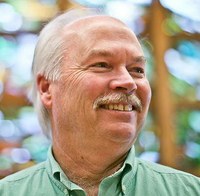 As the Forest Management Bureau Chief for the Forestry Division, Pat led the interdisciplinary team that developed the first ever ‘Statewide Forest Management Plan’ and Programmatic Environmental Impact Statement. This innovative approach to planning has allowed field foresters to plan individual projects, such as timber sales, and evaluate the environmental effects without having to complete full environmental impact statements on each one. Instead, each individual forest management project can now be tied to the statewide EIS, allowing for a more focused and efficient environmental assessment. The statewide plan has resulted in considerable savings of time, effort, and money within the Forest Management Plan.
As the Forest Management Bureau Chief for the Forestry Division, Pat led the interdisciplinary team that developed the first ever ‘Statewide Forest Management Plan’ and Programmatic Environmental Impact Statement. This innovative approach to planning has allowed field foresters to plan individual projects, such as timber sales, and evaluate the environmental effects without having to complete full environmental impact statements on each one. Instead, each individual forest management project can now be tied to the statewide EIS, allowing for a more focused and efficient environmental assessment. The statewide plan has resulted in considerable savings of time, effort, and money within the Forest Management Plan.
In addition, Pat’s overall leadership of the Forest Management Program was instrumental in building positive relationships with outside organizations and with other agencies. He built a level of trust and confidence in the program that extends to the present. Pat was an extraordinarily effective manager and leader in Montana forestry.
Pat received his Bachelor’s degree in Forestry from the University of Montana (UM) in 1978, and then completed a Master’s degree in Forest Economics at UM in 1981. Prior to his hiring at the DNRC Forestry Division, Pat held a research position with the USFS in California. Pat started with the Forestry Division on the forest inventory crew after graduation in 1978. He re-joined the Forestry Division as the division’s first Forest Economist in 1983. His next step in the organization was a promotion to supervisor of the State Land Management Section of the Forest Management Bureau. Later, in 1993, Pat was promoted to the position of Bureau Chief of Forest Management. Pat subsequently left the DNRC in 1999 to join Montana FWP as the Region 3 Supervisor, headquartered in Bozeman, where he remained until his retirement in 2014.
Forestry Pioneer
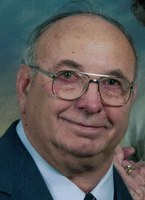 Joe had several years experience working for the USFS on Forest Management Projects. He also worked for 26 years as a volunteer and paid fireman (six years as the fire chief) of the Missoula Rural Fire District. He has a B.S. in Forestry from the University of Montana.
Joe had several years experience working for the USFS on Forest Management Projects. He also worked for 26 years as a volunteer and paid fireman (six years as the fire chief) of the Missoula Rural Fire District. He has a B.S. in Forestry from the University of Montana.
While with Montana State Forestry he was the Supervisor of the Development and Support Section. In this capacity, he worked with six full time mechanics, two warehouse men, and one full time truck driver. The work involved designing and building wildland firefighting equipment, procuring and purchasing using excess military supplies and equipment. The fire equipment developed under Joe's supervision was and continues to be used by the state and county fire agencies for wildland fire suppression. Joe worked for DNRC for 23 years before retiring and another 7 years during fire seasons.
Forestry Pioneer
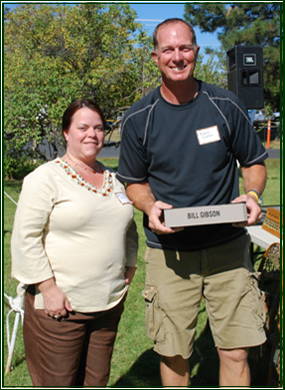 It seems that from the beginning, William K. "Bill" Gibson was born to be a forester. He was born in Ketchikan, Alaska and loved to do everything "outdoors" as a young man. When Bill was a teenager, he and his family moved to Montana. During the summers of his junior and senior years at Missoula County High School (now Missoula Hellgate) he worked for the USFS. The combination of working in the forest and a teacher's advice "not to pursue college" is probably what pushed Bill to not only pursue a career in forestry but as a forestry educator. He didn't let Gertie Clark's comment go lightly, and in fact, that teacher inspired a determination to not only pursue higher education to the PhD level but also to become an educator that encouraged others.
It seems that from the beginning, William K. "Bill" Gibson was born to be a forester. He was born in Ketchikan, Alaska and loved to do everything "outdoors" as a young man. When Bill was a teenager, he and his family moved to Montana. During the summers of his junior and senior years at Missoula County High School (now Missoula Hellgate) he worked for the USFS. The combination of working in the forest and a teacher's advice "not to pursue college" is probably what pushed Bill to not only pursue a career in forestry but as a forestry educator. He didn't let Gertie Clark's comment go lightly, and in fact, that teacher inspired a determination to not only pursue higher education to the PhD level but also to become an educator that encouraged others.
Bill worked for the USFS on a trail crew at Placid Lake the summer of his junior year in high school and also the summer after high school graduation, before enlisting and serving in the Navy for two years. In 1948, he was discharged and attended the University of Montana on the GI Gill, earning his Bachelor of Science in Forestry in 1952. While attending the University of Montana, he was a member of the Druids (Forestry Service Club) and enjoyed recreating with friends and introducing them to some of his favorite spots in Glacier National Park and the Bitterroot National Forest. After graduation he became a member of The Society of American Foresters and worked for The BLM in Oregon and Montana. In 1959 Bill had the opportunity to be one of the first researchers on the scene after the earthquake at Hebgen Lake near West Yellowstone because state land was involved. His photographs taken the morning after the quake show a massively changed landscape, and though it was a disaster, the geographical changes and recovery of the area were of great interest to him.
Bill pursued his Masters of Forestry degree from the University of Michigan, which he earned in 1962 saying, "I wish I could tell Gertie Clark!" He returned to Montana and became a professor at the University of Montana Forestry School. His published papers and research are still available and include topics still important to forestry today. Some of those items are; Erosion and Stream Health, Forest Land Fire Protection, Timber Resources and the Montana Forest Products Industry, to name a few. Bill Gibson had completed his PhD work (From the University of Michigan) and was teaching at the University of Montana Forestry School in Missoula when he died suddenly on October 25, 1970.
Forestry Pioneer
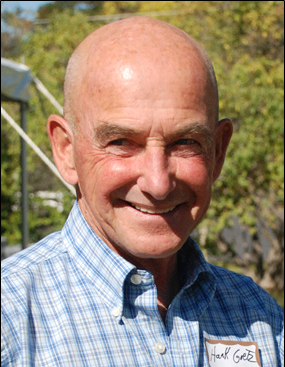 Born in Wisconsin, Hank graduated from the University of Montana in 1963 with a B.S. in Forestry. After three years in the Army, including a year as an infantry office in Vietnam, he worked for the Northern Pacific Railway Company as a forester in Seeley Lake Montana.
Born in Wisconsin, Hank graduated from the University of Montana in 1963 with a B.S. in Forestry. After three years in the Army, including a year as an infantry office in Vietnam, he worked for the Northern Pacific Railway Company as a forester in Seeley Lake Montana.
In 1969 Hank became the first Resident Manager of the University of Montana's Lubrecht Experimental Forest, a 21,000 acre research and demonstration forest located 30 miles east of Missoula in the Blackfoot Valley. In 1989 when the School of Forestry acquired the Bandy Ranch in Ovando Hank was responsible for the operation of both facilities. He retired from the day-to-day operations at Lubrecht and Bandy in June of 2005. During his tenure with the University, Hank was involved in numerous cooperative natural resource projects in the Blackfoot including the Blackfoot River Project, walk-in hunting areas, conservation easements, cross-country ski and snowmobile trails, and recreation planning along the entire Blackfoot River. Since June 2003, Hank has worked part-time as the Lands Director for the Blackfoot Challenge, leading that organization's efforts in the Blackfoot Community Project.
Forestry Pioneer
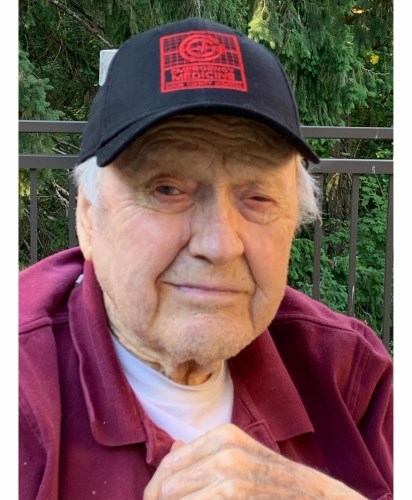 Bob Gorsuch attended the University of Idaho and received a bachelors degree in Forestry. He was a smokejumper from 1947 through 1952. In 1951, he opened the smokejumper base at West Yellowstone, Montana. As a permanent employee of the National Park Service, he was a crew leader with four jumpers.
Bob Gorsuch attended the University of Idaho and received a bachelors degree in Forestry. He was a smokejumper from 1947 through 1952. In 1951, he opened the smokejumper base at West Yellowstone, Montana. As a permanent employee of the National Park Service, he was a crew leader with four jumpers.
Bob retired from the US Forest Service in 1983 after a thirty-five year career. He then worked part-time for the Federal Emergency Management Agency assisting on more than fifty disasters int he US and US territories of Guam, Puerto Rico, and the US Virgin Islands. He fully retired in 2012 at the age of 85.
In his book, "The History of Montana State Forestry," Gary Moon named Bob Gorsuch as one of the most outstanding federal foresters who assisted State Forestry during his tenure. Through State and Private Forestry programs, the Forest Service and the DNRC partner together to deliver a myriad of programs, from urban forestry to fire and forest health. Bob's service to the Northern Region in State and Private Forestry was a great benefit to the Forestry Division.
Forestry Pioneer
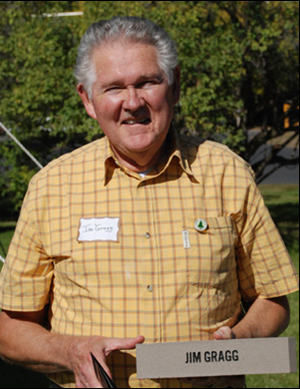 James attended the University of Southern California for one year and Oceanside-Carlsbad Junior College for one year, but finally found his calling at the University of Montana School of Forestry. While a student there he served as head of the Decorations Committee for the "Foresters Ball," joined the SAF, and earned a B.S. in Forest Engineering in 1959. During school he worked part-time at the State Forest Tree Nursery and the State Forester's Office. In the summer of 1957 James toiled as the Stillwater State Forest Headquarters Guard and in the summer of 1958 he and Gary Brown worked with the State Forest Inventory program.
James attended the University of Southern California for one year and Oceanside-Carlsbad Junior College for one year, but finally found his calling at the University of Montana School of Forestry. While a student there he served as head of the Decorations Committee for the "Foresters Ball," joined the SAF, and earned a B.S. in Forest Engineering in 1959. During school he worked part-time at the State Forest Tree Nursery and the State Forester's Office. In the summer of 1957 James toiled as the Stillwater State Forest Headquarters Guard and in the summer of 1958 he and Gary Brown worked with the State Forest Inventory program.
Jim's first and only permanent employment began with the State Forester's Office in 1959. The first position was as a forester on the Stillwater State Forest. Later he became the Swan District Forester, the Kalispell Service Forester, the Anaconda District Forester, the Kalispell District Forester, the Northwest Area Forester and lastly as the Area Manager of the Northwestern Land Office.
In 1992 he retired to his home in Kalispell. His son Ken helped him build a nice woodworking shop, where he's made many things for many people. His wife, Marilee, retired from Obstetric Nursing in 2000 and they've been "just kicking back" ever since. They have six children, nine living grandchildren and seven great-grandchildren.
Forestry Pioneer
 Grif was born in Northern Illinois in July of 1929 and came to Missoula to study forestry at the University of Montana. He worked seasonally on road location and design projects with the USFS and J Neils Lumber. He graduated from the university in the class of 1952 with a B.S. in Forestry. Grif joined the U.S. Army after graduation for two years of active duty in Korea as a civil engineer. He continued to serve as an army reservist for 16 years in various engineer units attaining the rank of Captain.
Grif was born in Northern Illinois in July of 1929 and came to Missoula to study forestry at the University of Montana. He worked seasonally on road location and design projects with the USFS and J Neils Lumber. He graduated from the university in the class of 1952 with a B.S. in Forestry. Grif joined the U.S. Army after graduation for two years of active duty in Korea as a civil engineer. He continued to serve as an army reservist for 16 years in various engineer units attaining the rank of Captain.
He returned to Montana to work for the Anaconda Copper Mining Co. In 1955 he became the logging engineer for the Yellowstone Pine Co. in Belgrade.
Grif was hired by the Office of State Forester (now the DNRC) in 1957, and moved to Kalispell. Assigned to timber management he located several roads and drafted a Road annual, and then was assigned to timber inventory. He was the Chief Inventory Forester during the time when the legislature directed the counties to reclassify all private lands for tax assessment purposes. He developed the forest classification manual and administered the work done by the Office of State Forester for the various counties. Grif developed the first two valuation schedules which were adopted by the State Board of Equalization. After several reorganizations, he was assigned as Chief of the Operations Bureau which consisted of the various Land Offices providing forestry services across the State. He became Deputy State Forester in October 1981 and retired in 1986.
In his retirement Grif built a cabin and moved to the Double Arrow Ranch near Seeley Lake with his wife Patti, managing several acres of forest land until mountain pine beetle took over. He was active in several community associations and enjoyed traveling. His travels included Germany, France, New Zealand, Australia, England, Wales, Ireland and much of the US including the Inland Passage to Alaska. Bob passed away May 21st, 2017.
Forestry Pioneer
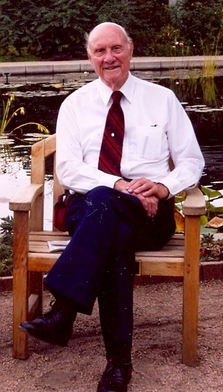 Dick Griffith was born in 1916 on a ranch near Custer, Montana. He graduated from the University of Montana with a degree in Forestry in 1939 and received a Masters in Forestry from Yale the following year. Dick's first job out of college was with J. Neils Lumber Company (which later merged with the St. Regis Paper Company) in Libby. He continued to work for St. Regis for 43 years.
Dick Griffith was born in 1916 on a ranch near Custer, Montana. He graduated from the University of Montana with a degree in Forestry in 1939 and received a Masters in Forestry from Yale the following year. Dick's first job out of college was with J. Neils Lumber Company (which later merged with the St. Regis Paper Company) in Libby. He continued to work for St. Regis for 43 years.
Dick was a true pioneer in forestry in northwestern Montana and active in the Society of American Foresters. Beyond his profession, he was known for his community service and volunteer work for a variety of organizations, particularly Habitat for Humanity. Dick passed away in 2010 at the age of 93.
Forestry Pioneer
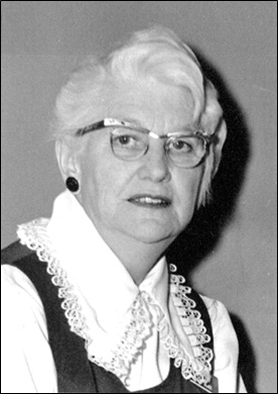 Ruth was born in North Dakota and went to the Kalispell General College. She started with State Forestry in 1956 and served until 1977. Maurice Cusick remembered her this way: "Ruth Guinard and I worked together for many years. We had a close personal cooperation between us. I couldn't even explain it. My wife, Evelyn, used to say that we could carry on a conversation and knew what each other meant, and no one else could even understand what we were talking about. Ruth could carry on a conversation over the radio and no one could tell what we were talking about but us." The employees of the Kalispell office said Ruth had a firm, but gentle hand and they loved her.
Ruth was born in North Dakota and went to the Kalispell General College. She started with State Forestry in 1956 and served until 1977. Maurice Cusick remembered her this way: "Ruth Guinard and I worked together for many years. We had a close personal cooperation between us. I couldn't even explain it. My wife, Evelyn, used to say that we could carry on a conversation and knew what each other meant, and no one else could even understand what we were talking about. Ruth could carry on a conversation over the radio and no one could tell what we were talking about but us." The employees of the Kalispell office said Ruth had a firm, but gentle hand and they loved her.
Forestry Pioneer
 John is a graduate of the University of Montana, with a degree in Forest Resource Management. During and after graduating, John worked for South Dakota State Forestry in the Black Hills, the U.S. Forest Service in Montrose, Colorado, and Champion International in Missoula and Libby, Montana.
John is a graduate of the University of Montana, with a degree in Forest Resource Management. During and after graduating, John worked for South Dakota State Forestry in the Black Hills, the U.S. Forest Service in Montrose, Colorado, and Champion International in Missoula and Libby, Montana.
In 1989, John was hired by the Montana Logging Association as a Field Safety Representative. At the time, safety in the logging industry was in its infancy. John, along with his work partner, Paul Uken, were tasked with bringing logging safety to the forefront in order to reduce accidents, injuries and Workers’ Compensation rates. This was accomplished through on-site job visitations, consultations, and training workshops.
Along with John’s duties in logging safety, he has served on the Air Ambulance (ALERT) Advisory Board for 24 years, is past Chairman of the Natural Resource Committee (Kalispell Chamber of Commerce), past President of Northwest Hoo-Hoo 187, and has served on numerous Forest Collaboration projects in NW Montana.
John retired from the MLA after 29 years, but remained involved in the logging and Forest Products industries. He passed away July 14, 2019.
Forestry Pioneer
Ralph was born in Coeur d'Alene Idaho in 1911. He received a degree in Forestry from the University of Montana in Missoula and served in Europe in combat infantry during World War II. He served as Assistant Firewarden for the Blackfoot Forest Protection Association from 1954 to 1965 and as Chief Firewarden from 1965 to 1971.
After joining Montana State Forestry he served in various fire control posts until his retirement in 1976. He received an appreciation plaque for superior work during the fire season of 1973. Hanson is well known throughout Montana and the western United States for his fire-fighting knowledge and abilities.
Forestry Pioneer
 Tony Harwood is a proud member of the Blackfeet Tribes and was raised in north-central Montana. Tony is a 1970 graduate of Valier High School, and received an Associates of Arts degree in Business from Flathead Valley Community College in 1972, and a Bachelor of Arts Degree in Journalism from the University of Montana in 1975. He was employed as a summer and extended seasonal employee with the USFS, Lolo National Forest from 1973 to 1978. In 1979 he was hired as a Bureau of Indian Affairs (BIA) Timber Sales Officer at Flathead Agency Montana, and later moved in to the Salish & Kootenai Tribes Division of Fire as the Wildland Fuels Specialist from 1990 to 2001. Then he became the Fire Program Manager from 2001 to 2007, and later worked as the Forest and Inventory Manager from 2008 to 2016. Tony was an Operations Section Chief and Fire Behavior Analyst on a Northern Rockies Type 2 Incident Management Team from 1989 through 2001.
Tony Harwood is a proud member of the Blackfeet Tribes and was raised in north-central Montana. Tony is a 1970 graduate of Valier High School, and received an Associates of Arts degree in Business from Flathead Valley Community College in 1972, and a Bachelor of Arts Degree in Journalism from the University of Montana in 1975. He was employed as a summer and extended seasonal employee with the USFS, Lolo National Forest from 1973 to 1978. In 1979 he was hired as a Bureau of Indian Affairs (BIA) Timber Sales Officer at Flathead Agency Montana, and later moved in to the Salish & Kootenai Tribes Division of Fire as the Wildland Fuels Specialist from 1990 to 2001. Then he became the Fire Program Manager from 2001 to 2007, and later worked as the Forest and Inventory Manager from 2008 to 2016. Tony was an Operations Section Chief and Fire Behavior Analyst on a Northern Rockies Type 2 Incident Management Team from 1989 through 2001.
Tony was also the Inter-tribal Timber Council representative to the Wildland Fire Leadership Council from 2009 to 2015 in the primary development of the 2012 National Wildland Fire Cohesive Management Strategies, and also as a co-chairman of the West Region of the Cohesive Strategy. Tony is presently the President of the FireSafe Montana non-profit organization.
For his work in BIA and Tribal Forestry, and fire management, Tony was awarded the 1999 Intertribal Timber Council “Earl Wilcox Award” for significant achievement on behalf of Indian people and their forests. Tony also received national recognition as the fire science advisor for the interactive “Fire on the Land” website about traditional fire use practices, and the associated award-winning “Beaver Steals Fire” children’s storybook based on tribal lore.
Tony recently retired from a 37-year career in Forest and Fire Management with the Confederated Salish and Kootenai Tribes. Tony presently works as a Land Resource Consultant in Polson and continues to work on forest and fire management planning projects. He also assists the Flathead Agency in wildland firefighting, wilderness fire program management, fire suppression decision support, and educational presentations on fire ecology , and traditional fire use practices.
Tony has provided leadership in building a comprehensive, science-based prescribed fire use program for the Confederated Salish and Kootenai Tribes at Flathead Agency. He instilled a high-level of professional state-of-the-art fire use program to restore a natural role of fire (with management of a tribal wilderness fire program) and cultural resource stewardship that is recognized as a model in “Indian Country”, and the state of Montana. A significant achievement was the development and maintenance of interagency cooperation with neighboring agencies as demonstrated by full partnership with the Montana Department of Natural Resources and Conservation land and fire management programs in the administration and implementation of the 1981 BIA/CSKT/State of Montana Fire Protection Agreement on the Flathead Indian Reservation. Tony worked with DNRC Land Offices in creating various Community Wildfire Protection Plans (CWPPs), especially the Lake County Plan that resulted in the creation of a very successful county/tribal/DNRC fuel mitigation program. Tony demonstrated a full career of interagency cooperation and collaboration with Montana DNRC fire suppression training, development of multi-jurisdictional large fire management decisions, fire suppression and fire use education and awareness presentations, and full interagency efforts on Northern Rockies Incident Management Teams.
Forestry Pioneer
Nathan was born in Viroque Wisconsin in 1887 and joined State Forestry in 1926. He worked in the Blackfoot area until 1957. He and his wife Mary were favorites of the folks in State Forestry for their wholesome manner. He was one of the genuine old-timers of State Forestry and kept a detailed journal of his daily work activities for many years, which is archived at the Southwestern Land Office.
Forestry Pioneer
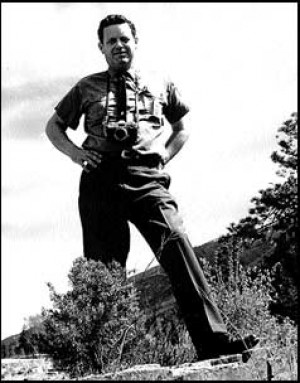 Born in Thompson Falls Montana Lorin's work with the USFS began in 1944 when he was 16. His first summer with the Forest Service was spent on a lookout west of Thompson Falls, where he was up 62 days and got down once. He spent the summer of 1944 doing trail maintenance, telephone line maintenance and fighting fires. He worked for the Forest Service every summer from 1946-1953.
Born in Thompson Falls Montana Lorin's work with the USFS began in 1944 when he was 16. His first summer with the Forest Service was spent on a lookout west of Thompson Falls, where he was up 62 days and got down once. He spent the summer of 1944 doing trail maintenance, telephone line maintenance and fighting fires. He worked for the Forest Service every summer from 1946-1953.
In 1949 he married Ina McCann. Together they had four children, and now have 3 grandsons.
Lorin earned a student pilot's license while in high school, then put this to use when he enlisted in the U.S. Army Corps in 1944. After the war, he went to the University of Montana and graduated in 1953 with a degree in Forest Management. His education also took him to North Carolina, Michigan, Oregon, Washington and Idaho where he took advanced forestry and wood utilization courses. After graduation, Lorin was appointed as Assistant Ranger at Plains and then was transferred to the Gallatin Forest and the Squaw Creek Ranger Station south of Bozeman as Assistant Ranger.
In late 1956 Lorin was offered a job with a lumber company in Plains as a forester. His main job was to examine timber sales but he also helped out wherever needed including working in the sawmill and working in the woods. After the war, Lorin had gotten his private pilot's license and the lumber company had a Super Cub which he flew whenever needed looking at timber sales, going for machine parts in Missoula, Kalispell or Spokane, or taking men from one job to another.
Because the company was a family affair, there were few opportunities for advancement so in the spring of 1959 Lorin went back to work for the Forest Service. His first job was titled "Regional Check Scaler" and he checked the Forest Service log scalers and timber cruisers in Montana, North Idaho and Northeastern Washington for accuracy in determining sale area timber volumes and harvested log volumes.
In January 1961 he was transferred to St. Maries Idaho as Ranger on the St. Joe National Forest and then later was transferred back to the Missoula Regional Office.
After retiring from the Forest Service in 1982 he did consulting work in Montana, Wisconsin, Wyoming and Minnesota. Lorin and Ina did quite a bit of traveling and in June of 2007 before his death they celebrated their 58th anniversary. Lorin passed away in August 2007 in Missoula.
Forestry Pioneer
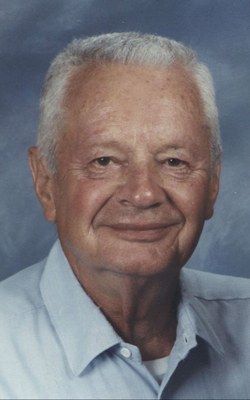 Edward George Heilman was born on March 25, 1929, in Butte, Montana. When he turned 16, he was able to get a job as a crewman on the Big Bend Ranger District of the Lake Tahoe National Forest. He was assigned to work at Donner Pass in California. So began his life-long affair with the U.S. Forest Service.
Edward George Heilman was born on March 25, 1929, in Butte, Montana. When he turned 16, he was able to get a job as a crewman on the Big Bend Ranger District of the Lake Tahoe National Forest. He was assigned to work at Donner Pass in California. So began his life-long affair with the U.S. Forest Service.
After graduating from UM with a degree in Forestry in 1950, Ed returned to California and was posted to the Downieville Ranger District of the Tahoe National Forest. There, he met Donna Dever, a young schoolteacher. They became engages six weeks later.
When the United States became involved in the Korean War, Ed learned that he had been classified A1 by his draft board. In addition to his degree in Forestry, Ed had also successfully completed four years of ROTC training at UM and traveled to the Hamilton Air Force Base to determine if he was qualified to serve as a commissioned officer. He was granted a commission and soon afterward he and Donna were married. Two weeks later Ed reported for active duty in Texas. There he was assigned to Communications School at Scott Air Force Base in Illinois. Upon completion of his communications training, Ed was assigned to Taegu Air Force Base in southern Korea where he served as the Base Director of Communications. Shortly after the truce was signed in 1953, Ed returned to Donna, their one year old daughter and employment with the Forest Service.
During the following years, Ed had a number of assignments throughout California including both Assistant Ranger and District Ranger in Descanso on the Cleveland National Forest in southern California. This was followed by a stint as Director of Fire Management for the Shasta-Trinity National Forest in Redding, California.
In 1967 Ed was transferred to Tuscon, Arizona, where he was the first Director of the National Fire Training School at Marana, Arizona, which provided training for students from throughout the United States, Canada, Australia, India and the Philippines, as well as other foreign countries.
In 1970 Ed was transferred to Milwaukee, Wisconsin, as Director of Aviation and Fire Management for Region 9 of the Forest Service which included the twenty northeastern states. In 1974 he was delighted to receive a similar position in Region 1 of the Forest Service Headquarters in Missoula, where he serviced until his retirement in 1984. In that position, he worked closely with state fire managers on fire management. His professional contributions to the agency - and to the benefit of DNRC - are many.
Upon retirement, Ed and Donna moved into the house that they had designed for themselves with sweeping views of the surrounding mountains and the city of Missoula. Ed expanded his many volunteer activities. He was president of the Friends of the Historical Museum at Fort Missoula, served on the Missoula County Park Board, was active in the Society of American Foresters, volunteered at the Forestry Exhibit at Fort Missoula, helped with the establishment of the National Forest Service Museum, and was part of the group that brought about the establishment of the Veterans Cemetery in Missoula.
Ed received a great deal of recognition for his service and achievement. In 1973 he was made a member of the California Board of Forestry. In 1984 he was made an Honorary Fire Warden for the State of Montana. In 1987 Ed was recognized by the Society of American Foresters for his outstanding performance in the field of forestry. In 1989 he was elected National Fellow by the Society of American Foresters. In 1990 he was awarded the Distinguished Alumni Award for the University of Montana Forestry School for Outstanding Service. In 2010 Ed was named Forestry Pioneer by the Montana Department of Natural Resources and Conservation, Forestry Division.
Forestry Pioneer
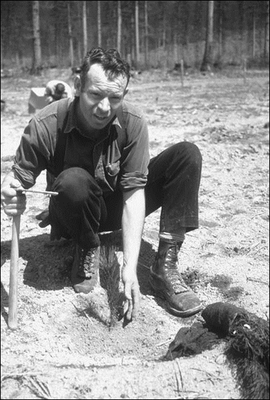 He was born in 1932 in Glendale, California. He earned an A. A. degree in Forestry from John Muir College in 1951: a B. S. degree in Forest Management from Utah State Agricultural College in 1954; M. F. Degree from the University of Idaho in 1957. Russell served in the U.S. Army Corp of Engineers from 1954-1956 in Bordeaux France. From 1957-1990 he was employed by the J. Neils Lumber Co., St. Regis Paper Co., and Champion International Corp., all at Libby Montana, rising from a Forestry trainee to Manager of Forestry and finally as Libby Area Timberlands Operations Manager for Champion International. During this 33 year period, Russell helped to bring a large tract of forest property from a new wild state to intensive management using "State-of-the-Art" forest management techniques. Russell retired from Champion in 1990.
He was born in 1932 in Glendale, California. He earned an A. A. degree in Forestry from John Muir College in 1951: a B. S. degree in Forest Management from Utah State Agricultural College in 1954; M. F. Degree from the University of Idaho in 1957. Russell served in the U.S. Army Corp of Engineers from 1954-1956 in Bordeaux France. From 1957-1990 he was employed by the J. Neils Lumber Co., St. Regis Paper Co., and Champion International Corp., all at Libby Montana, rising from a Forestry trainee to Manager of Forestry and finally as Libby Area Timberlands Operations Manager for Champion International. During this 33 year period, Russell helped to bring a large tract of forest property from a new wild state to intensive management using "State-of-the-Art" forest management techniques. Russell retired from Champion in 1990.
Russell has been a member of the Society of American Foresters since 1954, and was elected a Fellow of SAF in 1989. He was chairman of the Inland Empire Tree Improvement Co-op 1968-1989; President of Western Forestry and Conservation Association in 1985 and a Trustee from 1975-1985. In 1981 he co-authored the publication Interior Ponderosa Pine - section of "Choices in Silviculture for American Forests" (Schubert, Wellner, Hudson and Barrett) by SAF. He was a Lincoln Conservation District Supervisor from 1975-1985.
Russell served as a Forestry Best Management Practice audit team member for the Montana Department of State Lands from 1990-1996 and team leader from 1998-2002. Russ was instrumental in the successful development and implementation of forestry BMP's in the state. He has operated a family-owned tree seed processing/forestry consulting business since 1971 and currently works part-time as a forestry consultant.
He served for 10 years on the advisory board to the President of the University of Montana. From 1995-2004, he served on the Board of Environmental Review for the Department of Environmental Quality. He was the coordinator for the "Kootenai Forest Roundtable" as part of the Seventh American Forest Congress. He received the following awards: Inland Empire Tree Improvement Cooperative for 20 years of outstanding leadership (1989), Western Forestry Award for Current Achievement (1990), Conservationist of the Year award from the Lincoln Conservation District (1992) and Montana Tree Farmer of the Year for 2005. In 2009, he had a newly established Forest Tree Gene Archive named in his honor for effort dedicated to the IETIC, located on the University of Idaho's School Forest east of Moscow Idaho.
Russ currently lives with his wife Kay in Ajo Arizona.
Forestry Pioneer
 Jim Hurst was born in August 1918 in Galata, MT to James and Clara Hurst. Jim grew up on the family homestead near Rexford, where hunting and fishing were not only recreation but also a means of survival. As a result, he became an excellent woodsman and hunter. Home was a two-room log cabin which he shared with his parents and five sisters with the closest neighbor being two miles away.
Jim Hurst was born in August 1918 in Galata, MT to James and Clara Hurst. Jim grew up on the family homestead near Rexford, where hunting and fishing were not only recreation but also a means of survival. As a result, he became an excellent woodsman and hunter. Home was a two-room log cabin which he shared with his parents and five sisters with the closest neighbor being two miles away.
Jim attended high school during the Great Depression in Eureka. During this time, he spent a year working on the National Bison Range for the Civilian Conservation Corps. He often started school a month late, as summers were spent manning lookouts for the US Forest Service, which required him to stay until fire season was over.
Jim answered the call of duty by enlisting in Army Air Corps in 1941 and attained the rank of First Lieutenant. He flew 28 bombing missions over Germany and France as a navigator on a B-17 and was awarded the Distinguished Flying Cross and the Air Medal for his service in World War II.
Jim married Glenna Olson of Eureka in 1943 while he was stationed in San Antonio, Texas. He mustered out in 1945 and bought a portable sawmill and a team of horses for skidding logs to the mill in Eureka. This was the beginning of a successful career in the lumber industry which culminated in 1971 when he sold his business, Ksanka Lumber Company, to Plum Creek Lumber Company.
During his retirement, Jim took up golf, seeking out the warmth of Palm Desert, California in the winter, and spending summers in Kalispell. He was a member of the LaQuinta Country Club and Buffalo Hills Country Club and was instrumental in the construction of the Championship 18 at Buffalo Hills. He will be remembered for his generous spirit, hard work, and good mind at both clubs.
In addition, he was involved in a number of community activities during his time in the Tobacco Valley. Jim was a school board member, a founding member of the Eureka VFW, and was instrumental in moving the Fowkes Store from old Rexford to the Historical Village, where it resides today.
Jim passed away in Palm Desert, California in September 2016. He will be remembered as an individual who epitomized the virtues of the Greatest Generation: hard work, honesty, self-discipline, generosity, and service to country.
Forestry Pioneer
 Jim Hurst, Jr. was born in Whitefish Montana, and raised in Eureka to an established logging sawmill family, who had roots in the area. He was involved in the logging and sawmill business in the Eureka area most of his life. After his father sold the Ksanka Lumber Company, at Fortune Montana to Plum Creek Lumber, Jim tried his hand at working for a large corporation. However, this was short-lived, and he returned to logging and managing timberlands.
Jim Hurst, Jr. was born in Whitefish Montana, and raised in Eureka to an established logging sawmill family, who had roots in the area. He was involved in the logging and sawmill business in the Eureka area most of his life. After his father sold the Ksanka Lumber Company, at Fortune Montana to Plum Creek Lumber, Jim tried his hand at working for a large corporation. However, this was short-lived, and he returned to logging and managing timberlands.
In 1980, Jim formed a business partnership with Lum Owens, after a poker game at a local Hoo Hoo Club meeting. This led to the purchase of a small mill in Eureka, and “Owens & Hurst Lumber” was a new startup sawmilling business in northwest Montana, and north Lincoln County. Mill reconstruction started quickly with major improvements at the mill to utilize smaller logs and improve sawmill efficiencies to become a more efficient operation. The mill was rebuilt and expanded several times in the proceeding years to make it even more efficient and the ability to utilize smaller logs and improve lumber recover. Jim was very active in encouraging the management of private, state, and federal timberlands. He actively managed timberlands that his grandparents owned, as well as lands the business partnership owned.
Jim spend many hours encouraging active management of private, state, and federal forest lands over the years. With the purchase of the Eureka based mill, he became active in many projects to improve the active management of our forests and the good utilization of the forest resources produced by these lands. Some of the creative business ideas, endeavors, and political/civic involvement by Jim and “Owens & Hurst Lumber” were:- 09-15-82 Began purchasing logs from Canada to keep the Eureka mill running.
- 04-28-88 Involved with “People for an Economically Sound Montana”.
- 05-14-88 Great Northern Log Haul of 220 truckloads of sawlogs (Approx. 1.0 MMBF) to Darby MT
- 05-19-91 Chosen Montana “Small Business Person of the Year”.
- 08-10-96 Started Lone Pine Lumber in Eureka, adjacent to O&H Lumber mill to better utilize small logs and manufacture construction lumber.
- 12-23-97 Part of the Flathead Basin Economic Study Commission.
- 01-28-00 Supporter of “Shovels for Solidarity” in Jarbridge, NV. Helped gather 10,000 shovels and deliver them to Jarbridge, NV to show support for rural communities and “Communities Against Federal Roadless Area Expansion”.
- 09-09-00 “Timberman of the Year” from Montana Wood Products Association.
- 10-05-00 “Lumberman of the Year” from the Hoo Hoo Club of NW Montana.
- 05-18-01 8-Foot Log Haul to Owens & Hurst’s Mill in Eureka, to show good utilization standards and the need for sawlogs at NW Montana area sawmills.
- 06-01-01 Participated in U.S. Senate Field Hearings on Canadian Lumber Imports and Economic Impacts on U.S. Lumber Procedures.
- 04-15-02 Received “Forest Activist Award” in Charlotte, NC from the Forest Resource Association.
- 12-12-02 Awarded “Montana Voice for Forest Products Industry”.
- 01-08-03 Member of the Lincoln County Leaders to visit the Ecology Center in Missoula MT, to try to resolve federal land management issues and litigation.
- 09-11-05 Jim and Carol were given the “Presidents Award” by the Montana Wood Products Association for all of their efforts over the last 25 years in support of rural communities, and the forest products industry.
- Owens & Hurst/Lone Pine Lumber built a small mill that utilized 8-foot logs to a 4 1/2” top size.
- Sponsored a Montana Wood Products Association field trip to review harvesting on his grandparents’ original homestead above Rexford, Montana.
- Sponsored a USFS Regional Office staff tour of his milling operations at Eureka, and his new cut- to-length logging operations being used in northwest Montana.
- Worked collaboratively with the Yaak River Forestry Council to find common ground for good forest management and the salvage harvesting of lodgepole pine in bark beetle infested forests.
- With the devastation of the lodgepole forests of NW Montana by the mountain pine beetle in the late 1970’s and 1980’s, Owens & Hurst was a major player in the salvage logging and timber utilization on the several thousand acres of dead and “blued” lodgepole pine on the Kootenai and Flathead National Forests. They developed and promoted a market for this dead and “blue” stained lumber.
Jim was very active in supporting the local community and the many events that occurred. A brief count reveals that Jim has purchased at least 44 animals at the annual Lincoln County Fair over the years. At one event, he purchased a peach pie for $100.
Today, Jim spends his time managing his timberlands, playing golf, and watching his grandchildren play basketball. Jim’s ability to “think outside the box”, his great sense of humor and tact, mingled with his sound work ethic, code of honor, loyalty, and real love for the forest and timber industry, negotiating skills and commitment to his community and employees, were all important factors in his business and personal success. Jim’s wife Carol has been a partner throughout all of his life’s adventures.
Forestry Pioneer
Dick’s father, Otha, was honored last year with a pioneer award. Like last year, Dick’s son Jack will accept the Pioneer Award. Dick served in the Navy in WWII, and started with state forester as a seasonal worker in 1942. He enjoyed several careers in DNRC: Forester, Timber Management Assistant, and Administrative Assistant on Northwest Land Office, before moving to Helena to serve as a fiscal resource.Forestry Pioneer
 Otha was born in Memphis Missouri in 1896 and moved to Flathead Valley as a young boy. He served proudly in the Army during World War I. After his discharge, Otha worked for the Isaacs family logging and sawmill business until a fire destroyed the business in the late 20's or early 30's. He then received a business degree and went to work for the State of Montana in 1933 and retired in 1961.
Otha was born in Memphis Missouri in 1896 and moved to Flathead Valley as a young boy. He served proudly in the Army during World War I. After his discharge, Otha worked for the Isaacs family logging and sawmill business until a fire destroyed the business in the late 20's or early 30's. He then received a business degree and went to work for the State of Montana in 1933 and retired in 1961.
Otha moved up the ranks from being a log scaler in Olney Montana at the Stillwater State Forest to be the Assistant State Forester in Missoula. He was an honorary member of the SSF and also a member of the school of hard knocks. One of his most outstanding talents were his carpentry skills. Otha died in Kalispell in 1989.
Forestry Pioneer
 Jeff Jahnke is the State Forester and Director of the Colorado State Forest Service, an outreach agency in the Warner College of Natural Resources at Colorado State University. As State Forester Jeff leads programs in wildfire prevention and mitigation, forest management, community forestry and conservation education.
Jeff Jahnke is the State Forester and Director of the Colorado State Forest Service, an outreach agency in the Warner College of Natural Resources at Colorado State University. As State Forester Jeff leads programs in wildfire prevention and mitigation, forest management, community forestry and conservation education.
Prior to joining the Colorado State Forest Service in August 2005, Jeff served as the State Forester in Alaska where he was responsible for managing approximately 48 million acres of state owned forest land, provided leadership to 200-600 employees and managed an annual budget of over $30 million.
In addition Jeff has served as Southwest Area Manager, Deputy State Forester and Chief of the Forest Management Bureau for the Montana Department of Natural Resources. Jeff holds a Master of Science in Forest and Range Management from Washington State University and a Bachelor of Science in Forest Management from Michigan Technological University.
Forestry Pioneer
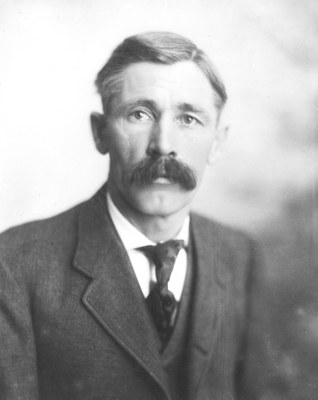 Charles was raised in Kalispell Montana and was the first State Forester of Montana. Charles was appointed by Governor Edwin L. Norris in June of 1910.
Charles was raised in Kalispell Montana and was the first State Forester of Montana. Charles was appointed by Governor Edwin L. Norris in June of 1910.
Mr. Jungberg was a practical woodsman and prior to his appointment was employed by a lumber company as a logging foreman. In the first and second biennial reports to the Governor, he made some very commendable recommendations, many of which since have been established by law. Fire protection and trespass timber cutting were among their most difficult problems. He managed to make an excellent start in securing an inventory. There is a story that he, prior to appointment, once engaged in a fist fight on the streets of Polson. He must have been feisty.
Forestry Pioneer
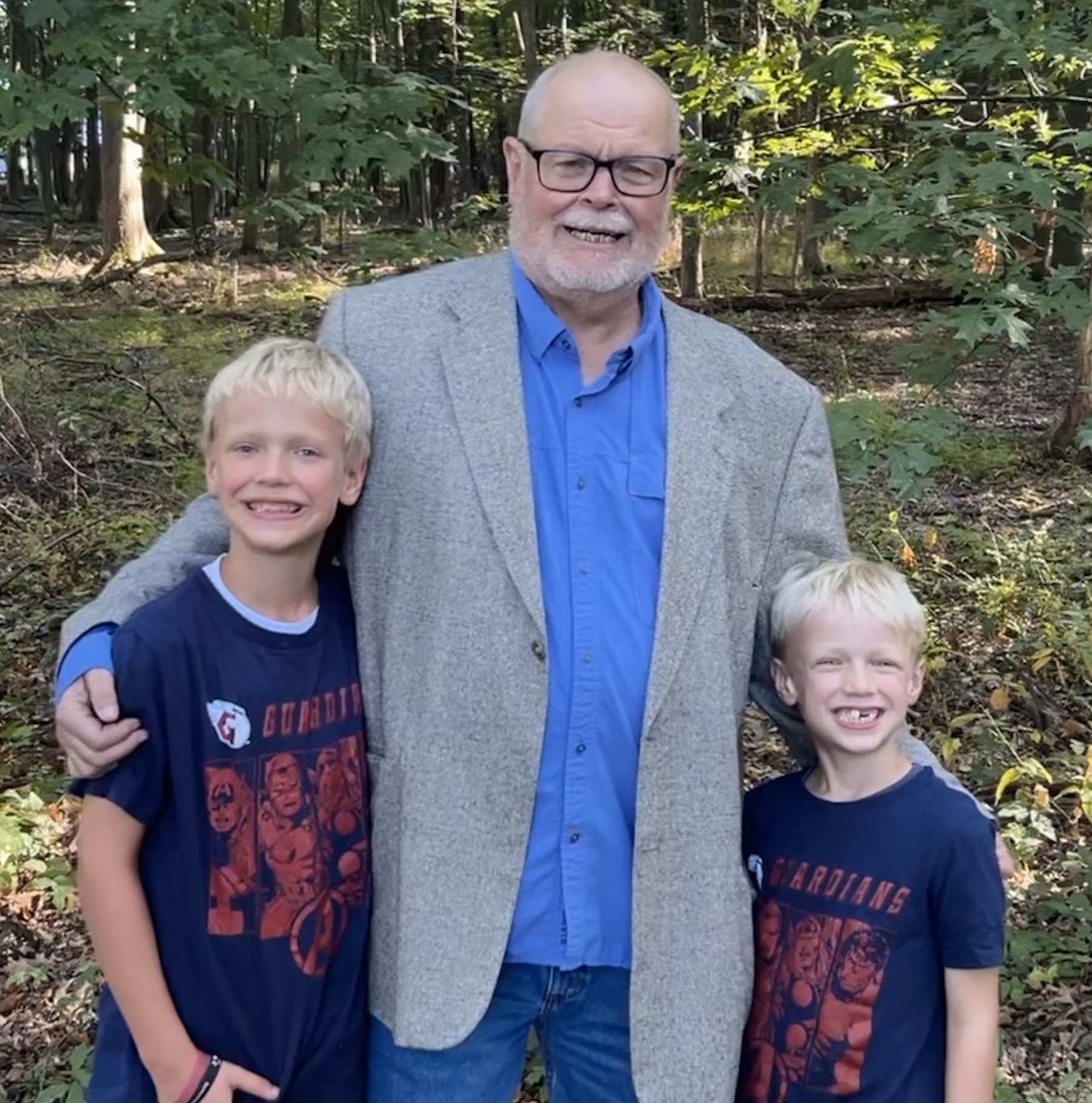 Charles (Chuck) Keegan became intrigued by forestry and forest products soon after he enrolled at the University of Montana, and realized that through appropriate / scientific forest management you could produce wood products while maintaining other attributes of forests that people greatly value.
Charles (Chuck) Keegan became intrigued by forestry and forest products soon after he enrolled at the University of Montana, and realized that through appropriate / scientific forest management you could produce wood products while maintaining other attributes of forests that people greatly value.
After earning his M.S. in Forestry from the University of Montana (1976), and B.S. in Business Administration from Georgetown University (1970), Chuck started his forestry career in 1977 as a Research Associate with the BBER (Bureau of Business and Economic Research). Chuck had a 40 year career at the University of Montana, where he served as Director of Forest Industry Research in the BBER, and Research Professor in the School of Business Administration.
His research emphasized the structure and operations of the forest products industry in Montana and other western states. Through cooperative research with the Interior West and Pacific Northwest Forest Inventory and Analysis Research Units, Chuck helped develop and implement a system to estimate removals of timber products from forest growing stock. Chuck “pioneered” a system to trace the flow of wood fiber in the harvest from the forest through the primary manufacturing processes, and then to attach key economic variables to that wood fiber, and to segments of the industry. Chuck has also evaluated the impact of reduced timber availability on Montana’s industry and the capability of the existing industry in the Western States to process timber of various sizes. When Chuck started at BBER he was the only research forester. When he retired there were five– much of that growth can be credited to his leadership.
In the last two decades of Chuck’s career he worked with Dr. Carl Fiedler of the College of Forestry and Conservation at the University of Montana, on the feasibility of implementing forest management regimes aimed at ecosystem restoration and fire hazard reduction. His work involved financial analysis, including treatment cost, timber product volume and value of potential alternative treatments.
Chuck has authored over 100 publications and reports, has made hundreds of presentations to the general public, at scientific and technical meetings. He has testified at numerous Congressional hearings on forestry and forest products issues. Chuck has served on the Board of Directors of the Forest Products Society, the Northwest Wood Products Clinic, and on the Board of Trustees of the Western Forestry and Conservation Association. He is past Chair of the Inland Empire Section of the Forest Products Society, and the Montana Society of American Foresters. He has received numerous awards including Fellow in the Society of American Foresters, Distinguished Alum of the University of Montana’s College of Forestry and Conservation, Woodpecker of the Year Hoo Hoo Chapter 187, Communicator of the Year Montana Wood Products Association, and USDA FIA Certificate of Appreciation.
When Chuck retired, he is quoted in the Missoulian as saying “It’s been a frustration of mine for quite a while, the issue of wood and the production of wood products not being viewed as an environmental desirable. You can produce a lot of timber and protect important resources. I just think the forest products industry has missed the boat on the message that wood is an environmentally desirable building material.” He predicted at the time that concerns over global climate change would spur some action. That has happened; wood products and good forest management are recognized as part of the solution today.
In 2022, Chuck moved to Avon Lake, Ohio where he is introducing his grandsons to the wonders of forests and forestry.
Forestry Pioneer
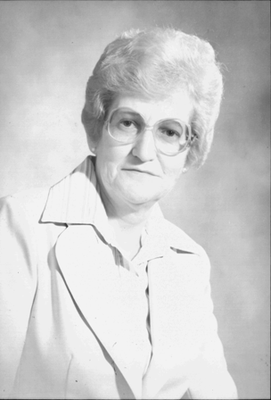 Maxine started work for Department of State Lands in the nursery, but her proficiency with the business side of things quickly landed her in the fiscal, records keeping area. Everyone who knew her said Maxine "ran a tight ship" and kept close attention to detail and accuracy in her work.
Maxine started work for Department of State Lands in the nursery, but her proficiency with the business side of things quickly landed her in the fiscal, records keeping area. Everyone who knew her said Maxine "ran a tight ship" and kept close attention to detail and accuracy in her work.
Maxine passed away in February of 2010. Her daughter, Bobbi, said her Mom spoke often about her time with state forestry.
Forestry Pioneer
 Rodney was born in Corvallis Montana and gave Montana State Forestry seventeen years of excellent, truly dedicated service. His forestry career started in 1923 with the U.S. Forest Service, where he served in a variety of tasks until 1944. He worked for the Anaconda Company for four years and came to State Forestry as a Slash Inspector in 1950. He then rose to the rank of Assistant State Forester in charge of Fire Control. He worked at a wide variety of tasks but is best remembered for his efforts in fire prevention and fire control.
Rodney was born in Corvallis Montana and gave Montana State Forestry seventeen years of excellent, truly dedicated service. His forestry career started in 1923 with the U.S. Forest Service, where he served in a variety of tasks until 1944. He worked for the Anaconda Company for four years and came to State Forestry as a Slash Inspector in 1950. He then rose to the rank of Assistant State Forester in charge of Fire Control. He worked at a wide variety of tasks but is best remembered for his efforts in fire prevention and fire control.
Rod was highly effective in all phases of fire, especially in getting other people and agencies to help. He was a very personable man and well liked by everyone in the organization. He retired in 1967.
Forestry Pioneer

Robert Lamley was born in Kenton, Ohio, on January 11, 1928. Bob graduated from Kenton High School in 1945. After graduation Bob attended Ohio State University for two years before enlisting in the US Navy. After his discharge from the Navy, Bob then utilized the GI Bill to continue his education and attend the University of Montana Forestry School, and play “Griz” football in Missoula. Bob graduated in 1952, with a degree in Forest Management.
Bob’s forestry career started with Anaconda Forest Products, then US Plywood working as a field forester in Missoula, the Blackfoot, Clearwater and Lolo management units. Bob went on to hold operational and managerial positions as district forester, area logging superintendent, Thompson River and Missoula Area Manager. Bob’s job responsibilities covered the Anaconda, US Plywood and Champion Timberlands, from Missoula to Potomac/Seeley Lake to Lincoln/Helena, Drummond to Powell, Id., Plains/Thompson Falls to Libby/Kalispell. Bob held many positions in his career, including that of the General Manager of Champion’s Montana Timberlands, which was the managerial position he held at retirement. The many corporate mergers were hard on Bob, as tough decisions about personnel were often needed and he was often in the managerial position to have to make those personnel decisions.
While with Anaconda, Bob was the Area Manager, in the Thompson River Management Unit. Bob’s vision of moving logs, without restrictions, lead he and a few others to establish the main Thompson River Haul Road, along the Thompson River, from Thompson Falls to Coniff Creek/Island Lake, in the upper Pleasant Valley River/Lost Prairie areas. This major road project’s needs included legal right-of-way easement work across multiple landowner ownerships, major project engineering and corporate finances. This 80-85 mile major unrestricted haul road allowed for off-highway log hauling to an established rail siding and log reload area of the Northern Pacific Railroad Mainline, east of Thompson Falls Montana at confluence of the Thompson and the Clark Fork Rivers. At this rail siding and log reload yard, sawlogs and peelers were loaded onto rail cars for transport to the Anaconda/Champion International sawmill and plywood plant complex at Bonner Montana, east of Missoula. This was truly a major road and transportation system feat! It is still in existence today.
While working in the Thompson River and Upper Pleasant Valley Management unit areas, Bob built an “office” on McGregor Lake where he worked and started his family of four girls. He then moved to Missoula and held managerial positions in logging, forestry, and with forest products manufacturing. Bob’s range of influence ran from forestry, logging and log accounting, to log utilization in the Champion mills of Montana.
During his career he was responsible for Forest Management on over 900,000 areas of fee timberlands, supplying logs to seven (7) mills located in western Montana and Idaho. Bob was instrumental in the transition and application of how loggers and mills addressed log delivery compensation, moving away from payment by MBF and conversion to Tons, which is still utilized by the forest products industry today. At the same time, Bob conceived, designed, developed, implemented and managed one of the best contractor log payment and administration systems of its time. Bob was active for many years in the Montana Wood Products Association and the Montana Trucker’s Associations holding many leadership roles. Bob was a strong “behind the scenes” advocate and member of the Society of American Foresters, the Governor’s Advisory Board, the Blackfoot Forest Protection Association, Intermountain Logging Conference, Thompson River Radio Association, U of M Alumni Association, Back Country Horsemen’s Association, Fort Missoula Forestry & Historical Museum, the Blackfoot Roundtable, and many other civic and professional organizations in NW Montana and the Inland Empire regions. Bob was an advocate of reaching across the organizational lines and working closely with his peers at the government, state and tribal agencies. When Bob retired, he continued to be very involved and supportive of public education, by playing a major role in the Bonner Milltown History Center & Museum which he is still active today.
Bob could be fairly blunt when talking with people, but he was a very fair man and a caring person who just didn’t want to waste time. Bob had a very open mind and people who worked for him were encouraged to be creative and find better ways to accomplish what they were doing in their business. Bob had high standards, and lofty goals, which helped every person around him to be their very best. He set a very high standard for those in his company, and on his team. Bob influenced many young foresters and loggers throughout his career. He was a team player and wonderful mentor. Bob supported Public Education, as it related to Forestry, and was a true believer in our renewable timberland resources. Bob promoted good forest management of these inland region forests to meet society’s needs and enjoyment now and for the future.
Bob retired in 1990, and passed away in 2023.
Forestry Pioneer
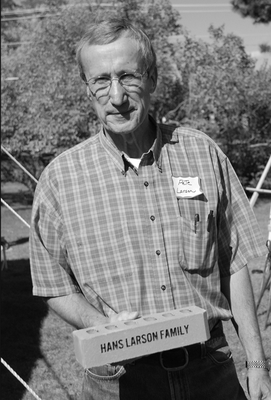 Hans Larson immigrated from Norway as a teenager in 1905 and settled in Little Fork Minnesota where he homesteaded for 15 years and learned to drive logs on the upper Mississippi River. In 1920 he came to the Flathead Valley where he became a pole expert and drove logs down the Middle Fork and the North Fork rivers to the Somers Lumber Company on Flathead Lake. in 1928 he formed American Timber Company and logged throughout the northwest Montana. During World War II the American Timber Company designed and built several portable "Tie Mills" under the supervision of Hans' son, Lawrence Larson.
Hans Larson immigrated from Norway as a teenager in 1905 and settled in Little Fork Minnesota where he homesteaded for 15 years and learned to drive logs on the upper Mississippi River. In 1920 he came to the Flathead Valley where he became a pole expert and drove logs down the Middle Fork and the North Fork rivers to the Somers Lumber Company on Flathead Lake. in 1928 he formed American Timber Company and logged throughout the northwest Montana. During World War II the American Timber Company designed and built several portable "Tie Mills" under the supervision of Hans' son, Lawrence Larson.
They also helped to clear the land to be flooded by Hungry Horse Dam in the years just after the war. In 1946 at the urging of Maurice Cusick of the DNRC, Lawrence built a stationary mill near Olney on the Lower Stillwater Lake. The initial purpose of this mill was to help harvest and process beetle infested engelman spruce in the area; later the mill was revamped to utilize lodgepole pine, which also experienced a beetle infestation.
The family sawmill business was a major employer in the area for 73 years and four of Hans Larson's grandsons were still involved in managing American Timber Company when it closed its doors in 2001. Both Hans and Lawrence have passed on.
Forestry Pioneer
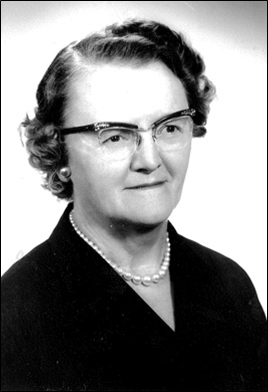 Serena was born in 1904 in North Dakota and then moved with her family to Bigfork in 1910. Upon graduation from the Flathead County High School, she worked at a Kalispell flour mill. After several other jobs she attended the Kalispell Business College and was hired by State Forestry in 1940. She was very capable serving in the Kalispell Office until 1961 when she transferred to the Missoula Office where she worked until her retirement in 1966.
Serena was born in 1904 in North Dakota and then moved with her family to Bigfork in 1910. Upon graduation from the Flathead County High School, she worked at a Kalispell flour mill. After several other jobs she attended the Kalispell Business College and was hired by State Forestry in 1940. She was very capable serving in the Kalispell Office until 1961 when she transferred to the Missoula Office where she worked until her retirement in 1966.
Serena passed away on February 20, 1985. She was an extremely gifted and dedicated clerk/secretary.
Forestry Pioneer
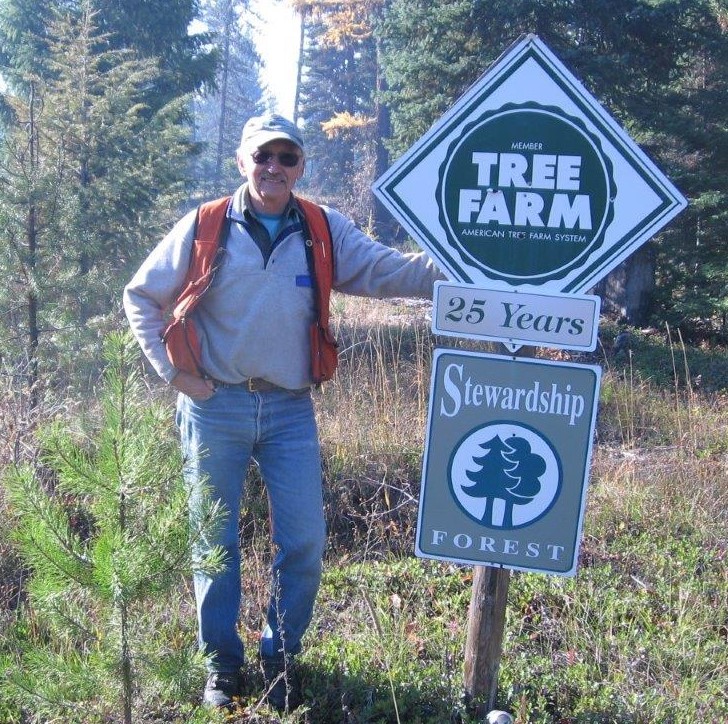 Ed graduated from Southern Illinois University in Carbondale, Illinois with a degree in Forest Management in 1963. Ed started his career on the Shawnee National Forest in Vienna, Illinois. He left after one year to successfully contract plant 875,000 loblolly and shortleaf pine. He then moved to Montana in 1965 and began working for the USFS on the Kootenai National Forest. Subsequent moves were to the Colville National Forest, and the Kaniksu National Forest (now the Idaho Panhandle National Forest), and then to Libby in 1975. Ed worked primarily in forest management and silviculture.
Ed graduated from Southern Illinois University in Carbondale, Illinois with a degree in Forest Management in 1963. Ed started his career on the Shawnee National Forest in Vienna, Illinois. He left after one year to successfully contract plant 875,000 loblolly and shortleaf pine. He then moved to Montana in 1965 and began working for the USFS on the Kootenai National Forest. Subsequent moves were to the Colville National Forest, and the Kaniksu National Forest (now the Idaho Panhandle National Forest), and then to Libby in 1975. Ed worked primarily in forest management and silviculture.
In 1981, he accepted the district ranger position at Wise River MT on the Beaverhead National Forest. A district with a balanced workload of timber, range, minerals and wilderness. His initial workload included the ongoing acquisition of 55,000 acres of the MT Haggin Ranch which had an existing timber sale with Louisiana Pacific (LP). The lawsuit of the U.S. Forest Service against LP was resolved, and Ed participated in the creation of a new contract.
The Beaverhead National Forest was one of three national forests in the U.S. that was involved with the Experimental Range Stewardship Program. Ed became very involved in some of the earliest collaborative efforts in the country working with the ranching community, Bureau of Land Management and conservation groups. Successful results were accomplished with many innovative range improvements made without regard to land ownership. Following these successes, Ed initiated collaborative efforts between a diverse group of stakeholders to resolve appeals and litigation of the district timber sales. These efforts led to years of successful timber sale projects that were not appealed or litigated. Although these 15 years at Wise River were not easy, his acceptance in the community and accomplishments spoke to a successful tenure.
Throughout his 32 year career he was active in fire and fuels management including numerous fire assignments across the nation. He spent his last three years as an operations section chief on an incident command team. He retired in 1996, and returns to Libby with his wife Teresa.
In 2003, Ed accepted a part-time job with Lincoln County as their county forester with a primary responsibility in wildfire preparedness. In this position he organized the Lincoln County FireSafe Council, presented educational classes, obtained fuel reduction grants and trained fire departments on firewise assessments. He was also able to encourage landowners to practice good forest management. He retired from this position in 2018.
In 1998, Ed began his long tenure as a forest stewardship workshop instructor for MSU Extension Forestry. He also served on the Montana Forest Steering Committee in review and guidance of the Stewardship Workshop Program and Forest Legacy Program. He was chair of the committee for three years. In 2002, Ed assumed the chairmanship of the Montana Forest Stewardship Foundation, and continues that role to the present. The Foundation’s mission is to provide resource information to forest landowners, resource professionals and the general public. Under Ed’s leadership, the Forest Stewards Journal is sent out bi-yearly to over 1200 recipients. Financial support has been given for stewardship workshops, grants secured for forest publications, and numerous forestry workshops provided. The Foundation has sponsored the Forest Landowner Conference in Helena for the past 14 years.
Ed has been an SAF member for over 50 years. He is an SAF Certified Forester (CFE). He has fulfilled the leadership roles in the SAF local and the Montana SAF. Ed has been active in the American Tree Farm Program at the Montana level for many years. He is currently a certified Tree Farm inspector and board member of the Montana State Tree Farm. He also manages his two certified Tree Farms in Lincoln and Flathead counties.
Ed is a charter member of the Kootenai Forest Stakeholder Collaborative, and is on the executive committee. The collaborative seeks to find agreement with a diverse group of members on Kootenai National Forest resource projects. He is also the Region One director for the Forest Service Museum in Missoula.
Ed is deserving of consideration for being an inductee into the Montana Forestry Pioneers for all of his professional expertise, professional outreach and involvement, and civic contributions to educate and promote good land management and fire prevention in Montana. He has dedicated his personal and professional life to helping in this endeavor and making it become a reality. He is truly a dedicated professional forester and active citizen of Montana. Ed lives in Libby with his wife Teresa, and they have six grown children between the two of them.
Forestry Pioneer
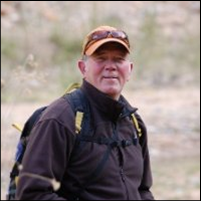
Brian graduated from Iowa State University with a Bachelor of Science degree in Forest Management, with a minor in Forest Products.
Initially, Brian worked for the USFS Intermountain Research Center doing forest inventory work in South Dakota, as well as for the USFS Intermountain Experiment Station, Forest Inventory and Analysis Work Unit in Ogden Utah. When Montana embarked on a cooperative state/federal forest inventory in the 1970’s, the Intermountain Research Station recommended Brian to oversee this operation. Brian worked for Montana DNRC from 1975 to 2014.
Brian played a dominant role in the development and implementation of the Montana state forest land inventory system, timer cruising programs and procedures, as well as the development of the State Forest Land Management Plan and the calculation of the annual sustained yield from forested state trust lands.
During his tenure, re-inventory efforts provided valuable information on growth responses to timber harvest as well as a statistical basis for estimating timber growth and yield. Brian initiated studies of wildfire mortality that have provided practical direction for foresters regarding the probability of tree survival from various fire intensities. This information has helped foresters better assess and prescribe treatments for timber salvage operations. These studies have also provided valuable information regarding the progression of recovery following fires including: susceptibility of weakened trees to insect mortality, the development and persistence of snags, and natural regeneration vegetative regrowth over time.
Brian’s work has been foundational to DNRC’s current and ongoing statewide forest management program. Foresters today utilize the data and methods developed early on, and with the improvements of technology, advance those methods with sound and fundamental practices to provide for a sustained income for the school trusts while maintaining healthy and well-managed stands of timber for the future.
Today, he is a forest consultant for BDL Forestry LLC. He and his wife Shirley have two children, Kari and Kurt.
Forestry Pioneer
 Tim served as District Ranger for the Seeley Lake Ranger District on the Lolo National Forest for nearly twenty years, retiring in 2014. Tim started with the USDA Forest Service in 1975 and served in a variety of capacities on the Custer, Lewis & Clark, and Lolo National Forests. He served in the US Air Force following high school, and then returned to his home in Missoula where he received a Bachelor’s Degree from the University of Montana in Forestry and Geography. He is a Certified Forester with the Society of American Foresters. Tim was one of the early implementers of the Forest Service stewardship contracting process, and produced one of the first demonstration projects in 2000. In 2013, he was honored by being named the Forest Service “Line Officer of the Year”.
Tim served as District Ranger for the Seeley Lake Ranger District on the Lolo National Forest for nearly twenty years, retiring in 2014. Tim started with the USDA Forest Service in 1975 and served in a variety of capacities on the Custer, Lewis & Clark, and Lolo National Forests. He served in the US Air Force following high school, and then returned to his home in Missoula where he received a Bachelor’s Degree from the University of Montana in Forestry and Geography. He is a Certified Forester with the Society of American Foresters. Tim was one of the early implementers of the Forest Service stewardship contracting process, and produced one of the first demonstration projects in 2000. In 2013, he was honored by being named the Forest Service “Line Officer of the Year”.
Tim remains active in forestry and has served on numerous community and non-profit Boards. He has held a number of leadership positions with the Society of American Foresters, including serving as the State Chair in 2006. He excels at leading collaborative projects and successfully completing them. He is respected for his integrity as a land manager by all interests, including local residents, environmental groups, the forest industry, and other government agencies. Examples of his ability to lead, and participate in successful partnerships include: “The Blackfoot Challenge” and the “Crown of the Continent” collaborative projects.
His wife Donna is author of children’s nature books. The couple has three grown children and two granddaughters.
Forestry Pioneer
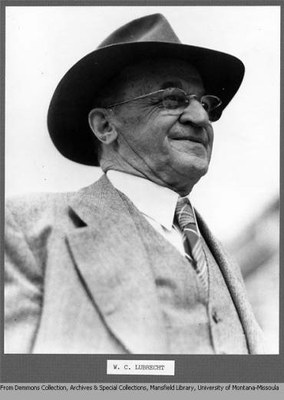
W.C. Lubrecht succeeded Kenneth Ross as general manager of the Bonner operation for the Anaconda Company in 1925. He had worked at the mill since 1896, and served for over 40 years.
In 1937, the School of Forestry received a donation of 19,058 acres of land from the Anaconda Company. The land was to be used as a research station and permanent location for the student camp. An additional 1,212 acres adjacent to the Anaconda Company land was donated by the Northern Pacific Railroad a year later. The combined donation was the work of School of Forestry Dean T.C. Spaulding and Anaconda Company Superintendent of Lumberman W.C. Lubrecht. The camp was named in honor of Lubrecht and today it is called the “Lubrecht Experimental Forest”. As part of the transfer, WC Lubrecht stated: “In addition to sound values from this property, in the future the School of Forestry will have an extensive area of diversified forest lands for practical study, experimentation and development, all of which should prove of future interest to the lumber industry and the State of Montana, particularly that section located west of the Continental Divide.”
According to newspaper reports at the time, the gift provided the school with “the most extensive holdings of any such school in the United States and compares favorably with the largest of such areas in the world.” The article continues, “In the United States only Yale University’s holdings can be compared with Montana’s as a result of the gift.” The deed interestingly spells out the advantages of the gift, not only to the School of Forestry, but also to the Anaconda Company. The Company clearly envisioned benefiting from the information collected in research done on the Forest and it also retained the mineral rights. In addition, it retained the right of first refusal to buy the timber offered at fair market value, a right passed on to its successors and assigns.
Forestry Pioneer
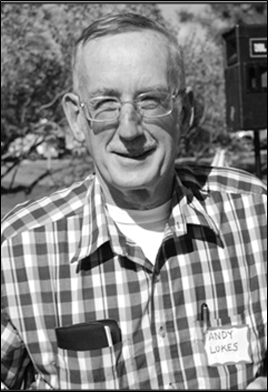
In 1965 Andy graduated from the University of Montana with a B.S. in Forest Management and then went on to receive a Masters degree in Silviculture. He was the CFM forester for Missoula, Mineral, Granite and Powell counties from 1970-1972. He was promoted to the Montana State Forestry Land Management Bureau and was named Division Environmental Coordinator, where he developed the Division's procedures to implement MEPA. Andy prepared eleven Draft and Final environmental statements that allowed the Division to implement its on the ground management programs.
Career highlights with State Forestry included staff work on Gary Moon's formal response on the Bolle Report, Secretary of the Governor's Forestry Practices Advisory committee, preparation of Forest Practice rules for Montana, member of the Governor's Natural Area Committee, and the opportunity to participate in aggressive fire control actions to support the Division.
In 1977 Andy accepted a job with Champion International as Planning manager for the Rocky Mountains Timberlands retiring from Stimson Lumber Company in 2005. He enjoys an active retirement with travel, finishing a lake home and helping his two sons with their building activities.
Forestry Pioneer
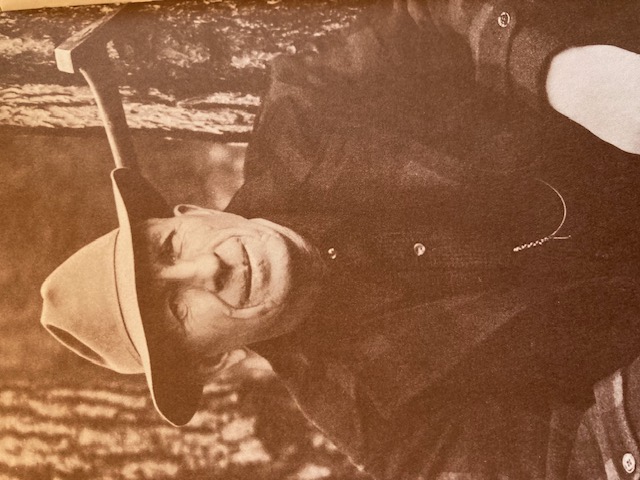 Donald G. MacKenzie was born April 11, 1887, in Dingwall, Scotland. Don’s father was a distinguished and well-known mechanical engineer there. Don left Scotland and immigrated to America in 1904 at the youthful age of 17, moved to Flagstaff, Arizona, where he worked for Michigan California Lumber Company, the Standard Lumber Company as an “axe man” with a Hispanic crew, and later in Quray, Colorado where he worked at the Camp Bird Mine running the tramway at the mine facility. Don eventually arrived in Missoula, Montana, to begin working for the Anaconda Company Mining (ACM) at Bonner, Montana in December 1909. His first job with the ACM was cook shack assistant chef, whose job was sacking potatoes at the root house for use in feeding the lumberjacks in the many remote logging camps in western Montana. Don advanced quickly within ACM. He was soon given an axe, and began working in the woods holding numerous positions in logging as a “swamper”, crosscut timber feller, horse team driver, top loader, log driver or “river pig”, woods/log yard scaler, and time keeper. By 1915, Don was promoted to Camp Foreman. Like many other young men in Montana, Don’s logging career was interrupted by World War I as he enlisted in the US Army, where he spent two years overseas with the 20th Engineers and achieved the rank of lieutenant.
Donald G. MacKenzie was born April 11, 1887, in Dingwall, Scotland. Don’s father was a distinguished and well-known mechanical engineer there. Don left Scotland and immigrated to America in 1904 at the youthful age of 17, moved to Flagstaff, Arizona, where he worked for Michigan California Lumber Company, the Standard Lumber Company as an “axe man” with a Hispanic crew, and later in Quray, Colorado where he worked at the Camp Bird Mine running the tramway at the mine facility. Don eventually arrived in Missoula, Montana, to begin working for the Anaconda Company Mining (ACM) at Bonner, Montana in December 1909. His first job with the ACM was cook shack assistant chef, whose job was sacking potatoes at the root house for use in feeding the lumberjacks in the many remote logging camps in western Montana. Don advanced quickly within ACM. He was soon given an axe, and began working in the woods holding numerous positions in logging as a “swamper”, crosscut timber feller, horse team driver, top loader, log driver or “river pig”, woods/log yard scaler, and time keeper. By 1915, Don was promoted to Camp Foreman. Like many other young men in Montana, Don’s logging career was interrupted by World War I as he enlisted in the US Army, where he spent two years overseas with the 20th Engineers and achieved the rank of lieutenant.
Upon returning to Missoula after the war, Don married his longtime sweetheart Grace, in Denver, Colorado. They had one daughter, Iva Rose.
Don continued his logging career with ACM. In 1923, he became Logging Manager/(Superintendent) at Bonner– a position he held until he retired in January 1957. During his logging tenure with ACM, Don introduced many innovative and more efficient harvesting systems, and needed changes in forestry practices in Montana and the Pacific NW logging and forest products industry. Some of those new log harvesting innovations from the 1920’s to the late 1950’s were: the introduction of the Holt 60 Gas Tractors, used for skidding and hauling logs, the “MacKenzie” log loader, which was used for loading logs onto “Shay” log hauling railcars, later powerful gas and diesel logging trucks, gas powered chainsaws, modernized diesel powered “skid cats” and arch skidding wenches, cable blade dozers, heel boom loaders, tong-line skidders, and Idaho “jammers” to name a few log production improvement innovations.
These innovations for forestry and logging allowed for large industrial private tree farms to be established. Major road construction expansion projects were started to retire railroad log hauling, and create haul road networks for logging truck hauling to area mills or railroad reload log yards from these tree farms. Tree farm management plans were designed and initiated to be sustainably managed for future log supplies for area mill facilities. All of these innovations and the planned landscape work allowed Don to harvest and deliver over 100 MBF of logs annually from a 135,000 acre ACM fee land tree farm in western Montana.
Don was also proactive in the development of smaller log utilization and log recovery in both logging and manufacturing. Don was very proactive and participatory for improved and progressive logging safety and overall protections for loggers.
Don helped form the Intermountain Logging Conference, a geographic branch of the Pacific Logging Congress in 1939, and served as its first ILC President from 1939 to 1940. Don was also on the Pacific Logging Congress Board of Directors for many years.
The ILC has the established honorary “Donald G. MacKenzie Award”, which is an outstanding recognition award that is dedicated to Donald G. MacKenzie for his true dedication and life-long contributions to “Logging and Forestry”. The honorary award is presented to members of the Logging, Forestry and Forest Products industry, in the Inland Empire Region. Award recipients, who like Don, are recognized by their peers and professional organizations for their outstanding contributions and dedication to their profession of Logging, Forestry and Forest Products Manufacturing. This is quite an honor to Donald G. MacKenzie and all of the dedicated award recipients who follow. The “Donald G. MacKenzie Award” is awarded by the ILC at the annual spring ILC Conference.
Don was preceded in death by his wife Grace, and he died in Missoula in 1986, at the age of 99.
Forestry Pioneer
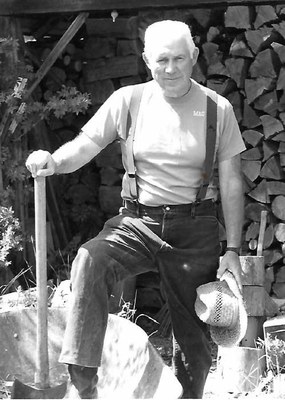
John K. McBride was born on January 30th, 1928, at Fort Totten, New York. John served in the Army Artillery Infantry and was honorably discharged in 1948 as a Corporal. He graduated from the University of Maine in 1952 and received a Bachelor of Science Forest Management degree. He spent the balance of his professional forestry career in Montana, working in private industry with J. Neils Lumber Company, St. Regis Paper Company, and Champion International. When St. Regis sold to Champion, John became the Kootenai Block Forest Manager.
John was a devoted family man and a good friend, tree farmer, horse lover, gun collector, military historian, and a consummate story teller with a great and dry sense of humor. After 38 years as a professional forester, all in Lincoln county, John retired. Of his retirement, John had said, "I do not fish, don't ski, and flatly refuse to play golf." He loved to teach: forestry with the 6th graders and new teacher's tours of the woods; Civil War history classes in schools. He worked hard and had a knack of turning work into fun.
John K. McBrike, 90, died March 11, 2018, at his home in Libby.
Forestry Pioneer
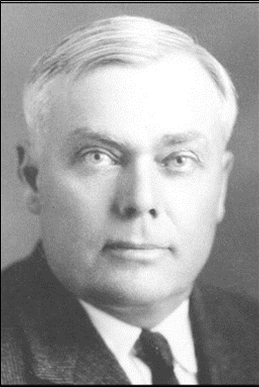
Robert was the third Montana State Forester, appointed by Governor Joseph M. Dixon in 1921. He had received his training in forestry at the U.S. Forest Service and served as a Forest Supervisor of the former Blackfoot National Forest which was located in western Montana. He was Chief of Information and Education for Region One, prior to becoming State Forester. He served one term, and is well remembered for drafting several excellent forestry laws, introducing them, and overseeing their passage in the 1925 legislative session. These laws created the State Forests and set aside the forests for future management.
Forestry Pioneer

Bob Meuchel, born January 16, 1942 in Hamilton, Montana; graduated Hamilton High School in 1960. In the same year, he began working for the U.S. Forest Service. Knowing Forestry was his life calling, Bob began college in 1965 and graduated from the University of Montana in 1969 with a degree in Forestry.
Shortly after graduation, he went to work with Kootenai National Forest as a silviculturist and Assistant Ranger. In 1976, Bob transferred to Lolo N.F. as the Forest Timber Planner as part of a collaborative team that created the first national forest plan. This plan set the direction of Forest Management and is still in place today.
In 1980, Bob transferred into his dream job as the Superior District Ranger where he led an outstanding resource program. In the mid 80’s, Bob worked as an incident commander; playing a key role in the implementation of a public participation plan on fire suppression efforts. He rose to Area Commander; one of four commanders in the nation and the longest serving. He loved fighting the fire.
Bob retired from the U.S. Forest Service in 2000. His dedication to Forestry did not end there. He continued to serve on different fire teams as consultant for several years.
Bob Meuchel passed away in 2010 having fulfilled his dream and destination as a Montana forester.
Forestry Pioneer
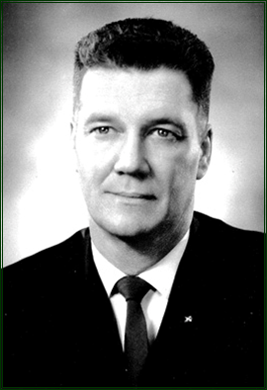 Gareth was raised in eastern South Dakota where he lived through the "Dust Bowl days" of the Great Depression. His younger brother, Delmar, almost lost his life to "dust pneumonia" and this experience set the stage for Mr. Moon's strong feelings about the value of forests in water management. He was a veteran of World War II, serving with the United States Marines in the South Pacific where he was wounded during the battle on Bougainville on Guam and Iwo Jima.
Gareth was raised in eastern South Dakota where he lived through the "Dust Bowl days" of the Great Depression. His younger brother, Delmar, almost lost his life to "dust pneumonia" and this experience set the stage for Mr. Moon's strong feelings about the value of forests in water management. He was a veteran of World War II, serving with the United States Marines in the South Pacific where he was wounded during the battle on Bougainville on Guam and Iwo Jima.
Before the war, he worked in the forests of Idaho on a logging crew. This led to his attending and graduating from the University of Montana's School of Forestry in 1949. During this period, he worked for the U.S. Forest Service primarily on the Lolo National Forest where he cruised timber and fought forest fires.
On March 1, 1954, Governor J. Hugo Aronson appointed Mr. Moon State Forester. He served as State Forester for the next 26 years under six different Governors. He was then appointed State Land Commissioner by Governor Ted Schwinden in 1980 where he served until October 1982 when he retired due to health problems.
Mr. Moon's accomplishments as State Forester are best detailed in his book, "A History of Montana State Forestry." He was proud to be named an "Honored Alum" of the School of Forestry, also as a "Fellow" of the Society of American Foresters, and the Association of State Foresters. He was a member of numerous boards and commissions at the national, state and local level.
Forestry Pioneer
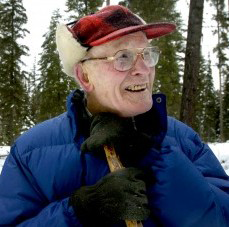
Bud Moore began his career with the Forest Service at the age of 16 working on fire crews, trail crews, and as a fire lookout. He served in the U.S. Marine Corps during WWII, after which he enjoyed a long career with the USFS as Powell District Ranger, positions in Utah and Washington DC, and as Fire Director for the Northern Region.
In June 1974, the University of Montana awarded him an honorary Doctor of Science Degree for his contributions to natural resource conservation. Bud passed away in November, 2010 at the age of 83.
Forestry Pioneer
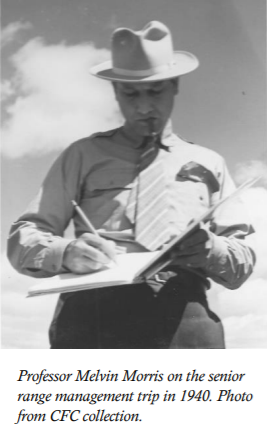 Melvin S. Morris was Professor of Range Management in the School of Forestry at the University of Montana in Missoula. Born July 9, 1907 in Denver, Colorado, he received his B.S. in Forestry in 1930, and his M.S. in Botany in 1932 from Colorado State University. Professor Morris did advanced work in botany at the University of Chicago in 1940-41. He began teaching and research at the University of Montana in the fall of 1936. He conducted research in the fields of grassland ecology, range management, and wildlife nutrition.
Melvin S. Morris was Professor of Range Management in the School of Forestry at the University of Montana in Missoula. Born July 9, 1907 in Denver, Colorado, he received his B.S. in Forestry in 1930, and his M.S. in Botany in 1932 from Colorado State University. Professor Morris did advanced work in botany at the University of Chicago in 1940-41. He began teaching and research at the University of Montana in the fall of 1936. He conducted research in the fields of grassland ecology, range management, and wildlife nutrition.
From 1954-1956, he was project manager for a study of elk nutrition in the Blackfoot Valley for the Montana Cooperative Wildlife Research Unit. Professor Morris wrote numerous articles which were published by the Montana Forestry and Conservation Experiment Station, and by professional journals.
Mr. Morris was president (1966-1967) of the American Society for Range Management and was affiliated with several other professional organizations. He was president of the Montana Academy of Science in 1946. He was also affiliated with numerous academic and honorary fraternities. He was a Fellow of the American Association for the Advancement of Science, and an Honored Alumnus of the College of Forestry, Colorado State University.
For more than 36 years, Mel Morris ran the range program at the School of Forestry, from 1936 to 1972. Range management, as noted, was a program included in the Ranger School curriculum and was originally taught by Prof. Tom Spaulding (another Forestry Pioneer) before he became Dean. Introductory courses in range management were first taught in the School of Forestry at Montana State University (now the University of Montana) in the 1916-1917 academic year. These were the first range courses offered at any college or university in the U.S. Mel Morris’s dedication to the students is evidenced in many ways, but especially by his taking students year after year on month-long spring range trips to the southwest, an invaluable experience for them. Before WWII and throughout the 1950’s to the early 1970’s, range management students went on extended field trips throughout the desert southwest, led by Mel Morris.
In 1940, there was a huge jump in range management students enrolled in the School. There were 41 range management graduates, and only 22 forest management graduates with similar results the next year– a trend which would be reversed following the end of WWII. When the school acquired Lubrecht in 1937, as its experimental forest, one of the first areas of concern was its range management. The jump in graduates may have been due to the availability of School land on which to actually conduct research. Range management was initially a big component of Lubrecht Forest activities. In 1938, incorporating all the surrounding lands (intermingled University Experiment Station land, school trust land, and adjacent private lands) which were utilized for grazing purposes, the total acreage available was considerable. It was divided into three grazing units—one for cattle and two for sheep, or 3,341 cattle AUMs, and 6,737 sheep AUMs. This land was described as transition range created by heavy forest cutting. According to Hank Goetz, who managed Lubrecht from 1969 to 2005, today there are still three allotments on Lubrecht “basically the same that Mel established.”
Professor Morris retired on June 30th, 1972. In the mid-1970’s, he served on the Navajo Environmental Protection Commission. He died at his home in Missoula on November 9, 1986, while shoveling snow.
Forestry Pioneer
 Randy Mosely received bachelor's degrees in Forestry and Business Administration from the University of Montana, and a masters from the Naval War College.
Randy Mosely received bachelor's degrees in Forestry and Business Administration from the University of Montana, and a masters from the Naval War College.
Randy worked for the Department of State Lands as Field Operations Division Administrator prior to becoming the Adjutant General for the State of Montana, Commander of the Joint Forces Headquarters -- Montana, and the Director of the Department of Military Affairs.
Forestry Pioneer
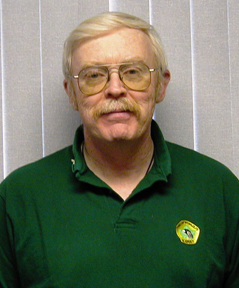 Anyone's who's been in the fire business - at any level in Montana, knows Tim Murphy. Tim retired several years ago as the Fire & Aviation Management Bureau Chief, having worked through the ranks as a firefighter. Under Tim's leadership, the Aviation portion of the Fire Bureau grew substantially, as did the County Cooperative Fire Program.
Anyone's who's been in the fire business - at any level in Montana, knows Tim Murphy. Tim retired several years ago as the Fire & Aviation Management Bureau Chief, having worked through the ranks as a firefighter. Under Tim's leadership, the Aviation portion of the Fire Bureau grew substantially, as did the County Cooperative Fire Program.
Tim retired from the state and went to work on the federal side for the Forest Service, specializing in contract resources for fire suppression. He is a respected resource for fire managers, contractors, and just about anyone else with a question or need related to fire and/or all-risk response.
Forestry Pioneer
 Helen Murray was born in Stockett Montana an undisclosed number of years ago. Out of necessity she went to work a a Nurse's Aide at St. John's Hospital in Helena at age 12. By the time she was 16 she was an operator for the telephone company.
Helen Murray was born in Stockett Montana an undisclosed number of years ago. Out of necessity she went to work a a Nurse's Aide at St. John's Hospital in Helena at age 12. By the time she was 16 she was an operator for the telephone company.
After coming to Missoula she was hired by State Forestry. Helen was promoted to the Supervisor of the Secretarial Section in 1969 and became Administrative Assistant in 1980 (in combination with heading up the steno section).
In 1984 she received a Certificate for Outstanding and Dedicated Service. During this period she and her husband Roger raised three children through their college years. State Forester Moon regarded her as the most efficient, dedicated and tireless employee he ever hired. Her pleasant personality was greatly appreciated. Helen passed away June 1, 2010.
Forestry Pioneer
 The name George Neff appears again and again as a tireless supporter of good forestry practices in Montana. He first worked for the U.S. Forest Service in 1930 and graduated in Montana with the degree in Forestry in 1938.
The name George Neff appears again and again as a tireless supporter of good forestry practices in Montana. He first worked for the U.S. Forest Service in 1930 and graduated in Montana with the degree in Forestry in 1938.
He was a foreman with the CCC and went to work for the Anaconda company as a timber cruiser and logging engineer in 1942. Through the years he worked his way up to Production Manager of Anaconda Forest Products and upon retirement was the Montana Lumber Operations Manager for Anaconda Company's successor, Champion International.
George served for many years on the State Board of Forestry as a trustee of The Western Forestry and Conservation Association, as a director of the NMFA, as a director and President of the BFPA, as a director of the Western Pine Association, and as a director of the National Forest Products Association.
In retirement he continues an active role in many of these organizations, in particular the NMFA, where he has been a strong supporter of Forestry School scholarships. Although he never worked directly for the State of Montana, State Forestry today owes much of its viability and effectiveness to George Neff.
Forestry Pioneer
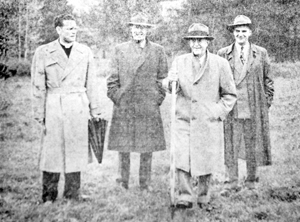 George Neils was logging manager for the J. Neils Lumber company at Libby from the 1920's until he retired in 1957. Neils developed the sustained yield program for company timberlands and authorized and funded the Libby Operations Forestry Program. He introduced many new ideas for the logging and forestry industry in Montana. He was a Civil Engineer and a member of the Society of American Foresters.
George Neils was logging manager for the J. Neils Lumber company at Libby from the 1920's until he retired in 1957. Neils developed the sustained yield program for company timberlands and authorized and funded the Libby Operations Forestry Program. He introduced many new ideas for the logging and forestry industry in Montana. He was a Civil Engineer and a member of the Society of American Foresters.
Forestry Pioneer
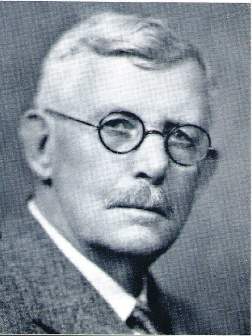 The J. Neils Lumber Company was incorporated on March 23, 1895 in Sauk Rapids, Minnesota with a capital investment of $30,000 (of which Thomas Shevlin and Hovey C. Clarke provided 60% and Julius Neils 40%.) In 1899 Julius Neils started a new mill at Cass Lake, Minnesota. In those years the universal forestry practice was clearcutting, and so as the timber availability was being exhausted near Cass Lake, Julius Neils went looking westward for viable timberland.
The J. Neils Lumber Company was incorporated on March 23, 1895 in Sauk Rapids, Minnesota with a capital investment of $30,000 (of which Thomas Shevlin and Hovey C. Clarke provided 60% and Julius Neils 40%.) In 1899 Julius Neils started a new mill at Cass Lake, Minnesota. In those years the universal forestry practice was clearcutting, and so as the timber availability was being exhausted near Cass Lake, Julius Neils went looking westward for viable timberland.
In 1906, the J. Neils Lumber Company began acquiring timberlands in Flathead County, Montana. Julius’s strategy was to buy even numbered sections held largely by Anaconda Copper Mining Company. Purchases were made at $1 per thousand feet, and by the end of 1907, a full million dollars had been invested in timberlands in Flathead County. It is hard to tell how many total acres J. Neils Lumber Company eventually acquired in Montana because they bought timber by the board foot, and the land was usually included in the selling price, and so their records are primarily in board feet of timber.
In 1910, J. Neils purchased the Dawson Lumber Company in Libby, Montana that included 70,367 acres of timber land. Early operations were not successful, so in 1912 Julius sent his son Paul to run the Libby operations. When Julius went to Libby three months later, Paul handed him a check for $10,000, the first returns from the new venture. Earnings grew to $100,000 by 1913.

In 1913 business partner Thomas Shevlin died suddenly from Pneumonia. His son Tom took over as president of J. Neils Lumber Company. Over disagreements with the new president, Julius divided the assets with Tom and by 1915, Tom Shevlin received the Libby mill and part of the Montana properties, and the Neils family retained the Sauk and Cass Lake Mills and some timberland in Montana. Due to a struggling business J. Neils was approached in 1918 to repurchase the Libby mill and holdings, and on January 13, 1919 the re-acquisition was complete. After returning from military service, Walter Neils was appointed as the general manager at Libby, a post he held until 1957; and George Neils became assistant to the logging superintendent, Ed Woodworth. Several years later George became the logging manager.
On June 1, 1922 J. Neils Lumber Company took possession of property and a mill at Klickitat, Washington. Due primarily to a lack of timber and the recession, the Cass Lake Minnesota operation ran its last load of logs November 10, 1923.
From 1930-1932, the Depression resulted in several challenges for the J. Neils Lumber Company. As the demand for lumber declined, the company looked for other revenue opportunities. They found a need for shipping boxes for fruit in Washington, primarily apples and pears. In 1931 they installed a small box plant and success was almost immediate. The company produced more than 1.6 million feet of box lumber. The other challenges centered on the collection of debt and utilization of bank credit. During the Depression, many payments were required in gold, and bank credit was limited to $25,000 on 90-day notes.
Julius Neils passed away on July 26, 1933.
In 1944, J. Neils Lumber Company acquired 5,000 shares— the entire outstanding stock—of the Montana Light & Power Company which included a power plant in Troy, Montana. This plant provided power to both the Libby and Troy Lumber mills and helped the company realize the importance of protecting this resource.
On January 1, 1957 J. Neils Lumber Company merged with St. Regis Paper Company. Paul Neils resigned as president of J. Neils Lumber Company to become chairman of the board, and was succeeded by Walter Rathert. George retired as logging manager at Libby and was replaced by Mark Schoknecht (Julia Neils’ son). Walter continued as manager at Libby until the end of the year. At that time, Allo Agather (Martha Neils’ son) was appointed as the general manager at Libby. Julius saved a significant portion of his earnings and expected the same from the company and his family. This practice allowed them to weather fires, floods, wars, a recession, and the Depression. It allowed them to acquire new land, timber, equipment, and mills when others were having to sell their companies and resources. The J. Neils Lumber company continually took every opportunity to acquire land, invest in equipment upgrades, and look for new products to meet market demands. Julius Neils worked long hard hours and expected the same from his family and employees. But by the same token, the company supported their loyal employees, as many had followed them from Minnesota to Montana. Julius Neils watched the lumber supply in Minnesota diminish, whereas in Montana, the company was one of the first to institute selective logging designed to perpetuate forest. Their studies began in 1936, were put into practice in 1939, and to the best of our knowledge, no other company in the northwest had undertaken this practice at that time. They partnered with institutions of higher education, including the University of Washington and Yale University Forestry Schools. They had senior students conducting studies on their land, and they consistently employed graduate students in their forestry operations as interns. They maintained their own nursery at the Libby plant and supported an aggressive reforestation program.
The J. Neils Lumber Company and family were civic and community leaders and made donations of their time and money to ensure that communities would grow. Julius Neils had a marvelous memory and the patience and ability to impart knowledge to others, which in his later life was reflected in his business leadership. In addition to his dedication to his business, he was extremely devoted to his church and firmly grounded in his faith. To quote Paul Neils: “As we look back on the growth of the company, on the continuing accomplishments, we should not forget how hard was the work, and how slender were the immediate rewards. Profits were not diluted by generous dividends; rather, they were spent for more timber and more efficient equipment. With such a policy the company continued to grow and prosper.” Julius and Mary Neils had 13 children, Julia, Martha, Anna, Ida, Paul, Walter, George, Martin, Marie, Henry, Gerhard, Marcus, and Victor.
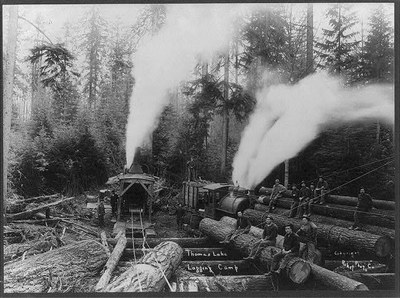
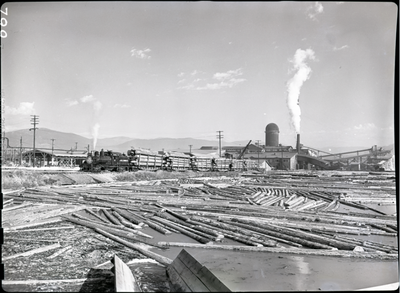
Forestry Pioneer
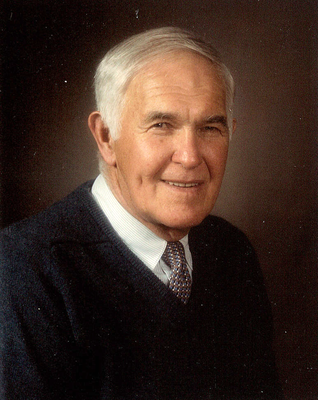 Shorty was born on June 21, 1920 in Helena, MT, raised and educated there graduating from Helena High School in 1938.
Shorty was born on June 21, 1920 in Helena, MT, raised and educated there graduating from Helena High School in 1938.
He attended the University of Montana School of Forestry graduating in 1943, with a degree in Logging Engineering. This was followed by serving in the US Army as a weapons instructor at Ft. Benning, GA until 1945.
During his college years he was employed by the U.S Forest Service and again after his military discharge Shorty worked on the clearing of the Hungry Horse Dam Reservoir, as a forest lookout and fire guard on the Fisher River/Wolf Creek drainages of the Kootenai National Forest and a field forester for the Ribes/White Blister Rust eradication program in Keeler/Callahan/Yaak drainages on the Kootenai National Forest Troy Ranger District. In 1947, Shorty began his forestry and engineering career for J Neils Lumber Company at Libby, as a Woods Scaler, and Road and Logging Engineer. He worked at the Rexford, Warland, and Dunn Creek logging camps in the Kootenai River drainage for JNeils. Shorty's knack for forest road engineering, layout and development was uncanny. He could look at a drainage, the topography and his access destination, and find a way to get there. Co-workers were always amazed at his natural ability and perseverance as to forest road engineering and road construction. It was amazing. He taught many a forest engineer about their profession.
Shorty was a prime leader in designing and locating the truck roads on the ground to haul the Engelmann Spruce bark beetle salvage harvest, in the early 1950's, on the Kootenai, Flathead, Kaniksu National Forests, as well as the State and industrial timberlands in northwest Montana and North Idaho. This massive Spruce bark beetle epidemic was created by large areas of high elevation spruce, which were blown down in the early 1950's, and covered thousands of timberland acres. These large Spruce blow down areas throughout the region promoted epidemic bark beetle populations. The bark beetle attacks exploded both in the blow down and the standing green Spruce timber stands. Large geographic areas and large stream drainages were affected throughout northwest Montana and north Idaho.
Shorty worked on JNeil's fee timberlands; in the North Fork of the Flathead, the Fisher River/Wolf Creek drainages, and many Troy area drainages west of Libby. He worked cooperatively, with the USFS and State DNRC foresters, establishing network road systems in the north-end of the Kootenai River drainage, in Eureka/Rexford areas of Big Creek, Boulder Creek, Dodge/Sullivan Divide, the WigWam, Pinkham and Skid Creeks where large areas were affected by the Spruce blow down and subsequent Spruce bark beetle infestations. In addition, Shorty worked in the Cabinet Mountain's east face drainages of; Deep, Libby, Bear, Poorman and Cable Creek drainages, all the Yaak River drainages, and the Keeler/Benning/Callahan Creek drainages at Troy. He helped develop a quick, expedient and effective designed road layout plan for a salvage harvesting plan, which entailed the economic recovery of these massive salvage timber volumes of Engelmann Spruce and White pine sawlogs that was the paramount focus of timberland owners and the sawmills, in northwest Montana, during this early 1950's time period. Shorty use to comment about his road location work during this time period, with the following comment; "My feet never touched the ground for a whole year, in the Yaak and Keeler/Callahan Creek drainages, as every step he took was on a blow down Spruce tree or log. In many cases, it was a long fall to the ground below."
Lumber and housing demand was very high in the 1950's since the end of World War II. In addition, this was an opportunity to get permanent haul road systems constructed and established into many non-roaded timberland acres of western Montana, and have the initial road development costs paid for by the salvaged Spruce and other sawlogs species harvested for lumber.
The J Neils Lumber Company operations, at Libby, had established a large and viable Spruce board market and expanded the mill manufacturing capacity to consume this large volume of Spruce sawlogs for a demanding US consumer population. They had a short time line to complete these large salvage operations on multiple timberland ownerships in northwestern Montana. The planned salvage operational objectives were met; permanent road systems were established, salvage harvesting completed, jobs provided, timber values preserved, mature high risk Spruce stands identified for management, fire fuel and risk reduced, finished wood products furnished to US consumers, for housing and naval ship construction. In addition, the initial investments in roads systems, forest management and fire protection for Montana's valuable timberlands and their future sustainability began. Shorty, and other professional foresters, landowners, and stakeholders played a huge role in creating this successful story of forestry in western Montana. It was a massive and cooperative endeavor, with a very successful outcome for Montana timberlands then, and was the beginning of forest management of our Montana timberlands, which provides a multitude of valuable and sustainable resource assets we enjoy and try to protect today. Shorty always took great pride in being part of that mission, and being a part of a team of professional foresters and land managers that accomplished a tremendous resource salvage effort. Shorty helped emphasize the need for investment in Montana forests, forest roads, forest infrastructure and good forest management. He played and key part in providing that permanent road access for the future, as a key component of sustainable forest management and forest protection. Road access helps to enhance and maintain healthy ecosystems and provide for sustainable forest outputs into the future. We still use these roads today for our forest resource management and resource protection of all our Montana forests.
Shorty continued to work for the J Neils and their successors companies; St. Regis Paper Company and Champion International at Libby. Shorty retired after 37 years of continuous service with J Neils and the various successor companies named above, and all on the same geographic landscape of federal, state or industrial timberlands in the Libby/Troy, Eureka/Rexford, Yaak and extreme north Idaho. Shorty was an icon in Forest Engineering and Montana forestry.
In 1988, Shorty was named Fellow in the Society of American Foresters and was recognized as a fifty (50) year member of the SAF. That same year, he was named Montana Forester of the Year, by the Montana SAF, for his many years of dedication to the profession of forestry and SAF. He received the Distinguished Alumni Award from the University of Montana in 1991. Shorty was an honorary member of the UofM Forestry School's Druid Society.
As a civic minded person, Shorty served as a Libby city councilman for 18 years. He was involved in the formation of the David Thompson Search and Rescue. He helped build the Cabinet View Golf Course and the Turner Mountain Ski Area at Libby. He coached Little League Baseball. He was a Libby Lions Club member, for 67 years, and a past club president. He was a member of the Libby Elks Club and Libby Rod and Gun Club. He was the designer of the Libby community Flower Creek Cross Country Ski Course. Later years saw Shorty active in the Libby Senior Citizen Center, and named Senior Citizen of the Year in 1993.
Shorty, or "Mr. 5'19" was known for his long legs that supported his tall 6 foot 7 inch frame, his twinkling blue eyes and his big smile, his love for hunting ducks and geese with his old trusty "Long Tom" - 52 inch Winchester 97 12 gauge pump shotgun, and his big tall Schwinn bicycle that he rode around Libby for so many years. You were never a stranger when Shorty was around.
Shorty died at 86 years of age, in September 2006. He is survived by his wife Jenny and four children. We think Shorty is still shooting ducks and hanging center line ribbons in heaven. Shorty was a big man, with a big heart to match, who left quite a legacy in Montana forestry. Shorty was a true Montana Forestry Pioneer.
Forestry Pioneer
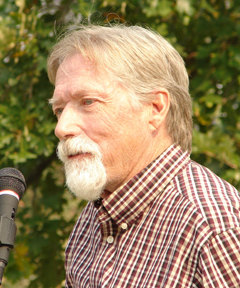 Bill is an Illinois native who received his BS in Forestry and Range Management from the University of Montana. After graduation, Bill attended Officer Candidate School then served as Lt. in the US Army Corps of Engineers 37th Eng. Group in Frankfort, Germany.
Bill is an Illinois native who received his BS in Forestry and Range Management from the University of Montana. After graduation, Bill attended Officer Candidate School then served as Lt. in the US Army Corps of Engineers 37th Eng. Group in Frankfort, Germany.
Bill held various positions with Montana DSL/DNRC, including Fire Program Manager at Northwestern Land Office, Range Forester with Forest Management Bureau, and Area Manager for Northwestern Land Office from 1992 until his retirement in 1996.
He continues to serve Montana DNRC as a FEMA Reservist, assisting the Forestry Division on cost recovery for large FEMA-assisted fires. He is married to Beverly (the Forester in the family) and has two sons, Mat and Tim.
Forestry Pioneer
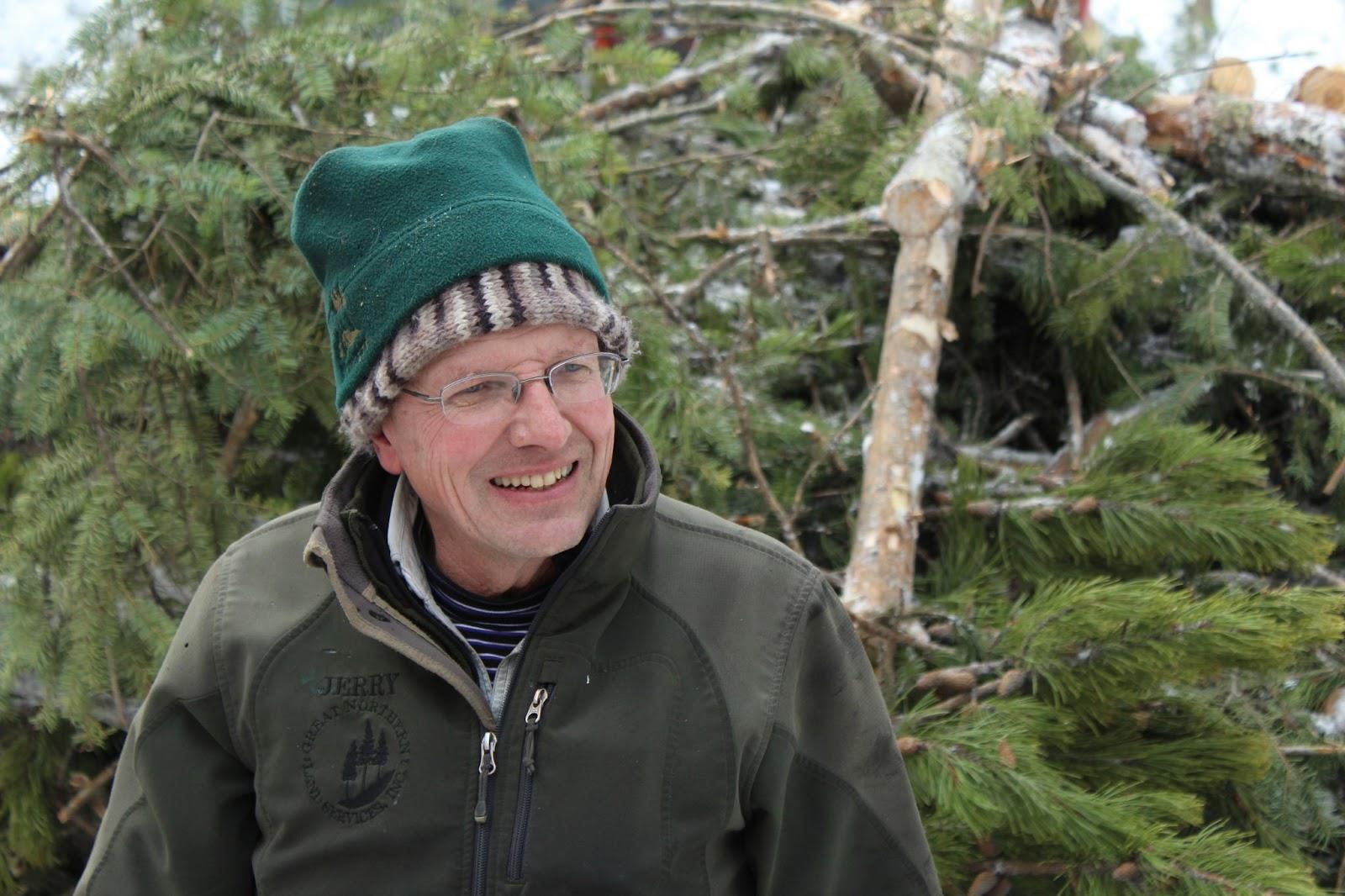 "Since early high school I wrote letters of inquiry on ‘making forestry my life’s work’. Fifty three years later, counting formal education less three years for military service it has been 50 years working and participating in many facets of forestry—creating international and U.S. businesses, conducting forest operations, various analyses, consulting projects and many others—truly my life’s work.” -Jerry Okonski, 2017.
"Since early high school I wrote letters of inquiry on ‘making forestry my life’s work’. Fifty three years later, counting formal education less three years for military service it has been 50 years working and participating in many facets of forestry—creating international and U.S. businesses, conducting forest operations, various analyses, consulting projects and many others—truly my life’s work.” -Jerry Okonski, 2017.
At age 15, Jerry Okonski, born in Chicago Illinois, traveled through Montana enroute to the 1962 World’s Fair in Seattle Washington. When he reached Columbia Falls, he was enamored with the area and wrote in his journal that he would come back to Montana. Jerry returned two years later and enrolled as a freshman at the University of Montana to pursue a degree in forestry. This was the beginning of a lifetime love of forestry, forest engineering, logging, and his colleagues. Through this, he found his purposed in combining faith, family, and forestry.
Jerry was tenacious in his efforts to understand and contribute to the forest industry of Montana. From logging the steep slopes of Yaak Montana with skyline yarding equipment, laying out road systems on foot in the Swan mountains with one of his three daughters in tow, spending hours researching and writing proposals and plans, to educating individual landowners on which specific trees to cut and how to create a habitat for their beloved songbirds, Jerry was involved with all of it. He mentored younger people coming up in the industry and he had a personal commitment to each of his employees, not only working in the brush alongside them, but also helping them in their individual lives and struggles.
When presented with opportunities, Jerry expanded his work into Canada, Chile, and Virginia. He shared the expertise he gained working in northwest Montana, positively impacting forestry practices in these areas. He continued to learn and gather valuable information that he then brought back home and applied to his continued work in the forests of Montana. Jerry had an analytical mind that allowed him to recognized potential problems and create unique solutions.
Jerry always had a smile on his face, something his family continues to hear from people who knew and worked with him. No matter the struggle, he was committed to the forest industry and its impact on all of our lives. He made profound contributions to his profession, industry, to local communities, and to all who had the opportunity to work with him.
In May 2020, his life ended abruptly, unexpectedly, and far too early due to an unknown cardiac issue at his home in Creston Montana. His work in the forest industry has enduring contributions and his positive impact will be evident in tree rings for many decades.
Industry Leadership & Community Involvement
2009 – 2015 and continuing to 2020 Echo Lake Jumpstart I & Jumpstart II Fuel Reduction and Forest Health Projects, in collaboration with Montana DNRC – A patchwork of private and state lands that aligned 26 landowners, state trust lands, contractors, consultants, and local sawmills. Jerry not only applied his forestry expertise to the land but also provided education to all of those involved.
“The lands that were thinned were mostly contiguous to one another, which will provide you as well as your cooperating neighbor a reduced risk of wildfire and increased tree growth,” he [Jerry Okonski] wrote. “With your cooperation, we have accomplished something unique in forest stewardship.” DNRC forester Roger Ziesak concurred, noting that tackling so many small connecting tracts presented a real test. Charged with doing state inspections, Ziesak added, “Jerry did a great job here, and I would put this project up against any project in the country. This is the way stimulus money is supposed to work.” Excerpts from “Celebrating Forest Management and Cooperation” Timber West Magazine, August 2011, Barbara Coyner.
• Montana Logging Association - Board of Directors, Kootenai Chapter Director
• 1987-2001 Communities for a Great Northwest - Charter member and Board of Directors
• 1990 & 1992 State of Montana Best Management Practices Audit team member
• 1988-1992 Participant in the development of the Montana Forest Stewardship program, created to educate and certify forest workers within the State of Montana.
• 1988 Co-founder of “Sally’s Heart”, a successful fundraising effort by the forestry community and local residents of Libby, Montana that raised $50,000 to pay for a heart transplant for the daughter of a local St. Regis/Champion logging superintendent.
• 1987 Co-organizer of the Great Northwest Log Haul, Darby, MT
• 1978 Soil Conservation District, Lincoln County, Montana - Board of Supervisors
• 1967 University of Montana, 51st Chief Push, Foresters Ball
• Several publications, presentations, training seminars in skyline yarding, wood utilization, GIS, innovative harvesting methods.
Other Recognitions
• 1993 Runner-up, State of Montana Businessperson of the Year
• 1992 Logger of the Year, Montana Wood Products Association
• 1988 Kootenai Knute - An award given to an individual to recognize their contributions and involvement in the logging community of Libby and Lincoln county, MT.
· 1962 Eagle Scout Award
Employment
Owner of Great Northern Land Services, Inc. – Land management and engineering services consultancy, 2007 – 2020 Montana
Owner of Skyline Systems, Inc. – Skyline operations based in Wise, Virginia, 2002 – 2005
Owner of Logging Systems / Timber Tech. Inc. Founder, co-owner (with his wife of 52 years, Mary Ann Okonski) & president 1980 – 2007 Montana/International
St. Regis Paper Company - Forest Engineer, 1975-1980 Libby, Montana
United States Army, Specialist 5, US Army, HQ, US Army Alaska (HHC-USARAL) Fort Richardson, Alaska 1969 –1972 (Honorably discharged)
Education
University of British Columbia, Master of Forestry (specializing in Forest Engineering), 1975
University of Montana, Bachelor of Science in Forestry (Wood Utilization), 1968
Professional Certifications
Intermountain Forest Council
Accredited Logging Professional (ALP)
Council on Forest Engineering - Lifetime member
Forestry Pioneer
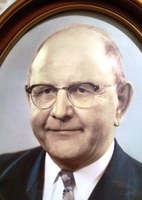 Arthur Olson was employed by White Pine Sash Company in Spokane, Washington in 1916. In 1920 he moved to Missoula to found and run the Missoula Organization of White Pine Sash Company. In 1942 he became president of White Pine Sash Company, and retired from the company in 1964.
Arthur Olson was employed by White Pine Sash Company in Spokane, Washington in 1916. In 1920 he moved to Missoula to found and run the Missoula Organization of White Pine Sash Company. In 1942 he became president of White Pine Sash Company, and retired from the company in 1964.
Throughout his career, Arthur Olson was also very active in trade and civic affairs in Missoula. He served as president of the National Woodwork Manufacturers Association, and was a charter member of Intermountain Logging Congress. He served as director of the Timber Products Manufacturers Association, the Northwest Woods Products Clinic, Ponderosa Pine Woodwork, as well as director of the Blackfoot Protective Association. Arthur also served as past president of the Missoula Chamber of Commerce & Rotary Club. Additionally, he was a past master of Harmony Lodge 49 AF & AM. He was also an elder of the First Presbyterian Church.
Forestry Pioneer
 Keith Olson recently retired as executive director of the Montana Logging Association, a position he held for 38 years. Mr. Olson was born in Grand Rapids, Minnesota, where he lived a grand total of 3 days.
Keith Olson recently retired as executive director of the Montana Logging Association, a position he held for 38 years. Mr. Olson was born in Grand Rapids, Minnesota, where he lived a grand total of 3 days.
Oregon would become his home for most of his early years. He graduated from Roseburg High School in 1965 and received a degree in forest management from Oregon State University in 1969.
Early in his career, Keith was employed as a corporate forester for 5 years in northwest Oregon, two years as a log buyer in north Idaho, and 5 years as a consulting forester—a title he co-opted because “he had no job and didn’t qualify for unemployment benefits.”
His professional career took a meaningful turn in 1980 when, as the story goes:
“Three nefarious loggers cornered him in a bar in Thompson Falls and—through the skillful manipulation of fast talk and cold beer—convinced him to become the executive director of the Montana Logging Association.”
What happened in the intervening years is a subject of great conjecture and debate.
Some of his professional affiliations include:
Forty-eight year member of the Society of American Foresters;
Past participant on the University of Montana’s Business Advisory Council;
Past-president of the National Council of Forestry Association Executives; and
Founding member of the American Loggers Council and serving as its administrative director during its formative years.
He is most appreciative of the acknowledgements he has receive from organizations such as the Northwest Montana Hoo Hoo Club, the Intermountain Logging Conference, the American Loggers Council, the Montana Forest Council and the Montana Wood Products Association.
But he is most proud of the fact that the Montana Logging Association allowed him the great privilege of representing the logging profession for nearly four decades.
Keith continues to reside in the Flathead Valley with his wife of 50 years, Vicki. They are the proud parents of 3 daughters, 5 grandsons and one great grand-daughter.
Forestry Pioneer
 Charles O’Neil came to the Flathead Valley in the late 1890’s. He purchased timberland and had interest in several sawmills and lumber mills. He also wrote several articles and books about his experiences. Charles was the manager of DuBach Lumber Company in Monarch MT, as well as the manager of the retail yard of the Butte & Montana Commercial Company. In 1896 he purchased the lumber yard and changed the name to O’Neil Lumber Company with co-owners James Byrne & brother Clinton O’Neil. He was president of the Northwestern Lumber Company, and also organized the Northern Montana Forestry Association. In the mid 1940’s, Charles founded the Forest Products Company with his family as shareholders. His sons Larry, Chuck, (and John, killed in action in Italy, 1944) continued the sawmill and timberland business.
Charles O’Neil came to the Flathead Valley in the late 1890’s. He purchased timberland and had interest in several sawmills and lumber mills. He also wrote several articles and books about his experiences. Charles was the manager of DuBach Lumber Company in Monarch MT, as well as the manager of the retail yard of the Butte & Montana Commercial Company. In 1896 he purchased the lumber yard and changed the name to O’Neil Lumber Company with co-owners James Byrne & brother Clinton O’Neil. He was president of the Northwestern Lumber Company, and also organized the Northern Montana Forestry Association. In the mid 1940’s, Charles founded the Forest Products Company with his family as shareholders. His sons Larry, Chuck, (and John, killed in action in Italy, 1944) continued the sawmill and timberland business.
Chuck and his brother Larry ran the sawmill and continued to acquire lands that became available, eventually buying out the shares of the other family members.
In the mid 1960’s, the two brothers purchased the Kal-Mont Lumber Co. and ran it as a sister mill to Forest Products Co. The mills continued to run until the death of Larry after which they were closed in 1981. The timberlands were divided between the two families. In 1982 Chuck and his wife Wynona, and their four children formed Montana Forest Products, which today still owns approximately 6,000 acres of forested land in Northwest Montana.
The four children of Chuck and Wynona have continued to sustainably harvest their lands and have a long-term commitment to continuing the family business. They have gifted units in the partnership to all their children and grandchildren over the years and have sought professional forestry advice from Ron Buentemeier, the retired general manager of FH Stoltze Land and Lumber Co.
The O’Neil Family Tree Farm is one of the earliest Tree Farm members in the national system and has been under the Montana Tree Farm Program since 1944. The Charles O’Neil family intends to continue to manage their lands for wildlife habitat, improved water quality, aesthetic areas, and family revenue.
Forestry Pioneer
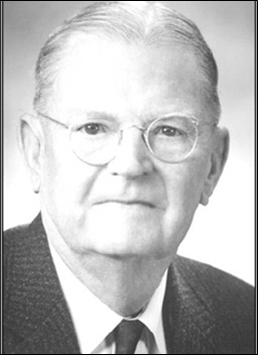 Rutledge was born on September 19, 1877 in South Carolina. His family lineage went back to the earliest days of Colonial America. His given name "Rutledge" was handed down from John Rutledge, Governor of South Carolina during the American Revolution and a signer of the U.S. Constitution. His maternal grandmother was a sister of General George Gordon Meade, West Point 1855, who commanded the Union Army at the Battle of Gettysburg.
Rutledge was born on September 19, 1877 in South Carolina. His family lineage went back to the earliest days of Colonial America. His given name "Rutledge" was handed down from John Rutledge, Governor of South Carolina during the American Revolution and a signer of the U.S. Constitution. His maternal grandmother was a sister of General George Gordon Meade, West Point 1855, who commanded the Union Army at the Battle of Gettysburg.
He received his early education from tutors, and received his high school education at Porter's Military Academy in Charleston South Carolina. In 1900 he was a timberland surveyor for the Atlantic Coast Lumber Company at Charleston. He entered Yale in 1905 and received a Masters Degree in Forestry in 1908. In July of 1908 he came to the Northwest working in Wallace Idaho and Libby Montana. In 1910 Parker was named a First Lieutenant in the Montana National Guard and by 1940 he was a Colonel in the Ordinance Department of the Guard.
From 1911 to 1924 he served as Deputy and Forest Supervisor on the former Missoula National Forest. He then spent two years working on his apple orchard along Rattlesnake Creek near Missoula. During the Great Depression, Rutledge and his wife Albertina Brown Parker were very active collecting food, clothing and other items for destitute people.
He was appointed State Forester by Governor John E. Erickson on March 1, 1926. He remained State Forester for a total of seven, four year appointments and served under six Governors.
Forestry Pioneer
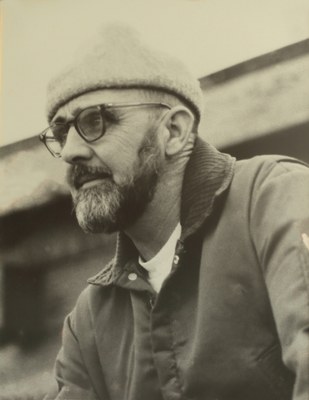 Jack B. Parrish, was a retired forester and mayor of Rexford when he died at age 66 on January 3, 1990 in the Kalispell Regional Medical Center.
Jack B. Parrish, was a retired forester and mayor of Rexford when he died at age 66 on January 3, 1990 in the Kalispell Regional Medical Center.
He was born May 3, 1923 in Martin, Tennessee to Otis and Maggie Parrish. He grew up in Martin where he graduated from Martin High School in 1941. He enlisted in the US Army Air Corps during World War II and served as a B-24 radio gunnery sergeant in the European theatre. He flew more than 50 missions and was missing in action for about 9 days after his plane was shot down over Yugoslavia. The entire crew was rescued by Tito’s partisan troops. After Jack recuperated from his wounds, he returned to active duty and finished his missions with the same crew. Parrish earned the Silver Star, Purple Heart and Distinguished Flying Cross with Oak Leaf Cluster.
After the war, Parrish returned to Tennessee and on March 8, 1945, married Martha Higgs in Martin. They moved to Missoula, where Parrish earned a Bachelor’s Degree in Forestry, with emphasis in Range and Wildlife Management from the University of Montana.
When he graduated from college in 1950, he went to work full-time for J. Neil’s Lumber Company. He was eventually promoted to the superintendent of the Rexford logging district. When St. Regis Paper Company brought out J. Neil’s, he continued as superintendent for Rexford district until the districts consolidated and moved to Libby. He retired in 1980 as a St. Regis Paper Company Land Agent.
During the construction of the Libby Dam, Parrish was instrumental in selecting the present site for the re-located town of Rexford. He was the town’s first and only mayor up to his death in 1990.
Parish belonged to the Society of American Foresters and was active in the Druid Society at the University of Montana. He was an avid outdoorsman and conservationist. He served on the board of the Lincoln County High School at Eureka as well as other school boards. He was honored by the Tobacco Valley Improvement Association with the annual president’s award in 1972.
Jack’s peers nominated him for this award because Jack was a strong advocate and voice of good forest management and all resource protection. He worked tirelessly throughout his life for pro-active forest management and forest fire protection, on all forest lands; federal, state, private and small private lands in Montana and the Inland Region. Jack was member of the Rexford Fire Department. He was actively involved in major fires suppression efforts in the Yaak, East and Westside of the Kootenai River drainage, such as Boulder Creek, Caribou, Koo-Boyd, Edna Creek, Stone Hill and many other fire projects. He was a very key resource for initial attack and fire suppression in north Lincoln County, and worked cooperatively with all area fire protection agencies in NW Montana and southern BC.
Jack is very deserving of induction into the MT Forestry Pioneers. Jack was a quiet man, but at times a very strong “vocal voice” in his support for good forest management, good fire protection and his communities and fellow residents of Lincoln County, Montana.
Forestry Pioneer
 Jack is a native Montanan, born on Blue Water Creek just outside of the community of Fromberg. He graduated from Bridger H.S. and joined the U.S. Army, completing basic and advance basic training in Fort Ord, CA. Jack was honorably discharged after three years of active service and spent a few years in North Carolina where he received an AA degree from Sandhills Community College. He received a BS in Forestry from the University of Montana in 1971 and began his career with Montana DSL on the Southwestern Land Office in 1972. Jack spent his entire career working for DSL/DNRC out of the Missoula offices. For 25 years, he served as the state wildland fire coordinator. Jack was also a Logistics Chief on an Incident Management Team. He was instrumental in developing and maintaining agreements between state, federal and international partners in the fire management arena. Jack retired from the DNRC at the end of 2001.
Jack is a native Montanan, born on Blue Water Creek just outside of the community of Fromberg. He graduated from Bridger H.S. and joined the U.S. Army, completing basic and advance basic training in Fort Ord, CA. Jack was honorably discharged after three years of active service and spent a few years in North Carolina where he received an AA degree from Sandhills Community College. He received a BS in Forestry from the University of Montana in 1971 and began his career with Montana DSL on the Southwestern Land Office in 1972. Jack spent his entire career working for DSL/DNRC out of the Missoula offices. For 25 years, he served as the state wildland fire coordinator. Jack was also a Logistics Chief on an Incident Management Team. He was instrumental in developing and maintaining agreements between state, federal and international partners in the fire management arena. Jack retired from the DNRC at the end of 2001.
Forestry Pioneer
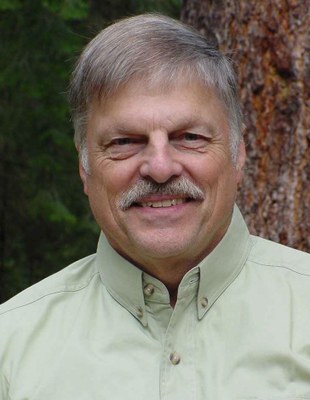 Robert D. Pfister has been a significant contributor to Montana Forestry in many ways since he moved to Montana in1967 as a Project Leader with Forest Service Research and as an active member in the State Chapter of the Society of American Foresters. In 1968, he helped train Forest Service people in Western Montana to use Dr. Rexford Daubenmire’s Northern Idaho forest habitat type classification for use in Montana, with some difficulties with the extrapolation. When Pfister became Leader of the Forest Ecosystem Research Unit in 1970 the top research priority was to extend Daubenmire’s classification to the Forest Service Northern Rocky Mountain and Intermountain Regions as an ecological foundation for site classification for forest research and management.
Robert D. Pfister has been a significant contributor to Montana Forestry in many ways since he moved to Montana in1967 as a Project Leader with Forest Service Research and as an active member in the State Chapter of the Society of American Foresters. In 1968, he helped train Forest Service people in Western Montana to use Dr. Rexford Daubenmire’s Northern Idaho forest habitat type classification for use in Montana, with some difficulties with the extrapolation. When Pfister became Leader of the Forest Ecosystem Research Unit in 1970 the top research priority was to extend Daubenmire’s classification to the Forest Service Northern Rocky Mountain and Intermountain Regions as an ecological foundation for site classification for forest research and management.
Based on his PhD research experience in Utah subalpine forests, the stage was set to define Forest Habitat Types for most of Montana with the financial backing and formal cooperation of the Forest Service Northern Region.
By 1975, a draft publication of Habitat Types of Montana was presented in a major training session that was used until the final publication of “Forest Habitat Types of Montana” was formally published in 1977.
Pfister continued to provide annual training sessions to help field users accurately identify and apply the classification. Use and popularity of the classification by many disciplines continued to grow and most field people and numerous researchers have discovered many applications beyond the preliminary management implications originally provided in the classification. Pfister has continued to provide annual training sessions for professionals new to Montana almost every year through 2019.
In 1980, R. Pfister and S. Arno published “Classifying Potential Natural Vegetation based on Potential Climax Vegetation” in Forest Science as a methodology paper using the Montana example. Pfister also was a co-author on similar classification publications for Central Idaho and Eastern Idaho/Western Wyoming and a consultant for Utah, Arizona, New Mexico, and a revision for Northern Idaho, all using the same methodology and philosophy. By 1980, Most of the Rocky Mountains had comparable Forest Habitat Type classifications.
In 2018, Pfister was honored by the International Association for Vegetation Science, for his outstanding contributions to vegetation science in the Northern Rocky Mountains. Dr. David Roberts, Montana State University, presented the award with the following comments: 1. The classification projects also "led Bob to consider the greater potential of vegetation science in natural resource management.", and 2. Pfister took what had been considered an academic classification system and turned it into the widely used tool that's still in use today.
Other Significant Contributions include: Leadership of the Inland Northwest Growth and Yield Cooperative helped facilitate better understanding of applications of Growth and Yield Models for understanding and predicting stand development and Leadership of the cooperative Montana Riparian Program led to publishing a comprehensive Monograph for understanding and managing Riparian and Wetland Vegetation and sites in Montana. Most of his research was documented in over 50 published articles and symposium proceeding contributions.
ROBERT D. PFISTER holds a B.S. degree in forest management from Iowa State University (1960), a M.S. degree in silviculture from Oregon State University (1964), and a Ph.D. in botany (plant ecology and soils) from Washington State University (1972). His dissertation for the Ph.D degree under Rexford Daubenmire was “ Vegetation and Soils of the Subalpine Forests of Utah”.
Pfister joined the USDA, Forest Service, Intermountain Experiment Station staff in 1961 as a Research Forester in Western White Pine Silviculture in northern Idaho. In 1967 he moved to Missoula as Leader of the Western Larch and Engelmann Spruce Silviculture Research Work Unit. From 1970 to 1981 he served as Leader of the Forest Ecosystem Research Work Unit.
Following this career with USFS Research, Pfister was hired at The University of Montana in 1981 to direct the newly, state-funded Mission-Oriented Research Program (MORP) as part of the Montana Forest and Conservation Experiment Station (MFCES) within what is today the W.A. Franke College of Forestry and Conservation. Under MORP emphasis on multiple resource second-growth management, many Forestry Faculty, Staff, and Graduate Students conducted a wide range of studies at Lubrecht Experimental Forest. Pfister also became the first Director of a still-running Inland Northwest Growth and Yield Cooperative (INGY) and Director of the Montana Riparian Cooperative which produced a major MFCES Monograph, “Classification and Management of Montana’s Riparian and Wetland Sites” in 1995. Pfister also was an active partner in the cooperative Bitterroot Ecosystem Management Research Program from 1995 to 2005 on Landscape Ecology Analyses. He also served as the Associate Director of the Montana Forest and Conservation Experiment Station for several years until formal retirement in 2000.
During his sojourn at the University, Pfister also taught at least one Graduate Course a year on Forest Ecology and/or on Landscape Ecology Design and Management, which were also offered as Summer Short Courses through UM Continuing Education for graduate natural resource professionals.
He worked full time for The University of Montana from 1981 until formal retirement on the last day of 2000, although he continued in a part-time capacity for several more years.
Pfister first joined the Society of American Foresters as a student in 1960, served as State Society president for two years, was elected as a Fellow in 2003, received a Golden Award in 2010, and is still active in the Society. He also has been an active member of the Ecological Society of America since 1966.
Pfister still teaches a short course on Forest Vegetation of Montana almost every June (since 1972).
Forestry Pioneer
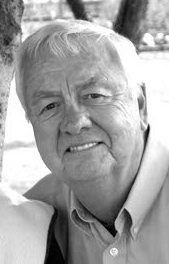 Dave Poncin began life on a small farm in the Midwest. Upon graduating from high school, he came West to work in the mountains. In the fall of 1955, he enrolled at the University of Montana School of Forestry, and graduated in 1960. Working his way through college, Dave spent his summers working in the woods: working as a lookout, smokejumper, timber cruiser and forester. He worked for the Forest Service in Montana and Idaho for 39 years, working on Incident Management Teams throughout that time, rising to the position of Type 1 Incident commander.
Dave Poncin began life on a small farm in the Midwest. Upon graduating from high school, he came West to work in the mountains. In the fall of 1955, he enrolled at the University of Montana School of Forestry, and graduated in 1960. Working his way through college, Dave spent his summers working in the woods: working as a lookout, smokejumper, timber cruiser and forester. He worked for the Forest Service in Montana and Idaho for 39 years, working on Incident Management Teams throughout that time, rising to the position of Type 1 Incident commander.
In 1997, Dave retired as Fire Staff on the Clearwater/Nez Perce National Forest. He has since done consulting in emergency management, preparedness and FEMA cost recovery.
In learning of his selection as a Forestry Pioneer, Dave expressed gratitude, but humbly added, "We (he and wife Emily) feel perhaps our greatest contribution to the State is our two sons, both of whom have worked for the DNRC."
Dave's son, Greg, is the Area Operations Manager for DNRC's Northwestern Land Office and Incident Commander of one of the Type 1 Incident Management Teams in the Northern Rockies.
Forestry Pioneer
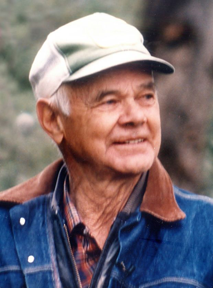 Bill was a true pioneer for land conservation in the Blackfoot Valley. An accomplished horseman, packer, skier, snowmobiler and Mission Mountains Wilderness hiker, Bill may be most remembered for his efforts in developing techniques and equipment for logging with modified farm equipment. working with the University of Montana's Lubrecht Forest, local saw and pulp mills, the U.S. Forest Service, Bureau of Land Management, state of Montana and others, he initiated efforts in the early 1970's to utilize small pine trees killed by the mountain pine beetle for pulp logs, pulp chips and hog fuel.
Bill was a true pioneer for land conservation in the Blackfoot Valley. An accomplished horseman, packer, skier, snowmobiler and Mission Mountains Wilderness hiker, Bill may be most remembered for his efforts in developing techniques and equipment for logging with modified farm equipment. working with the University of Montana's Lubrecht Forest, local saw and pulp mills, the U.S. Forest Service, Bureau of Land Management, state of Montana and others, he initiated efforts in the early 1970's to utilize small pine trees killed by the mountain pine beetle for pulp logs, pulp chips and hog fuel.
Bill also played a major role in cooperative conservation projects in the valley. He and adjacent landowners and public agencies established the first walk-in hunting areas in western Montana in the mid-1970's, a precursor to the Block Management Program now administered by the Montana Department of Fish, Wildlife and Parks. Many of the same landowners and public agencies created the Blackfoot River Recreation Corridor, which allowed for public access across private lands along a 30 - mile stretch of the Blackfoot River - a precursor to the state's Stream Access Law. In 1998, Bill and other family members donated a conservation easement on their 4,000-acre ranch to the Nature Conservancy of Montana - the first one in Montana that required proactive and sustainable forest management.
Over the years, Bill and his wife Betty have received numerous awards from private and public entities for their contribution to land stewardship, for encouraging collaboration between private and public landowners, and for working with various recreational communities in the Blackfoot Valley.
Forestry Pioneer
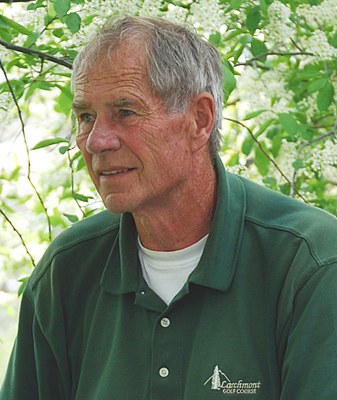 John Pritchard (Pritch) was born and raised in Salt Lake City, where he was an All-State basketball player. He went to Utah State University on a basketball scholarship and graduated with a degree in Forestry in 1962. He married Peggy Shartzer in Flagstaff, Ariz., in 1961, and they raised three children. Pritch spent two years as an Infantry Officer at Forts Benning and Ord and was the Company Commander of a training company. Following military service, he worked for the Utah Dept. of Forestry and Fire control as the District Forester in Cedar City, Utah, and then in the state office as the Assistant State Forester for Fire Control.
John Pritchard (Pritch) was born and raised in Salt Lake City, where he was an All-State basketball player. He went to Utah State University on a basketball scholarship and graduated with a degree in Forestry in 1962. He married Peggy Shartzer in Flagstaff, Ariz., in 1961, and they raised three children. Pritch spent two years as an Infantry Officer at Forts Benning and Ord and was the Company Commander of a training company. Following military service, he worked for the Utah Dept. of Forestry and Fire control as the District Forester in Cedar City, Utah, and then in the state office as the Assistant State Forester for Fire Control.
In 1967 Pritch was hired by the USFS as a forester, and subsequently worked on the Bitterroot, Helena, Clearwater and Kootenai National Forests, and was District Ranger on the Fortine District at Murphy Lake.
He became the Cooperative Fire Specialist in the Regional Office in 1983 and remained in that job until his retirement in 1999. He was responsible for the cooperative fire programs between the USFS and other federal agencies, as well as the states of Montana, Idaho and North Dakota. Pritch helped the Northern Rockies Coordinating Group (NRCG) to implement the National Interagency Management System in all fire agencies in the three states, and served as the advisor to the Federal Emergency Management Agency (FEMA) to determine which state fires qualified for FEMA assistance. Pritch worked with the states to determine which of their budget proposals would be federally funded and distributed the money between the states. He helped Montana and Idaho correct their fire protection imbalance, and obtain federal excess fire equipment. Together with Montana, and other agencies, he helped develop Montana’s first set of interagency fire restrictions. He was a member of the “Keep Montana Green” committee, as well as a committee that determined which county proposals for fire related projects the State of Montana would fund.
Pritch and his wife Peggy have three children: Kathleen, Christine and John. John Pritchard passed away on September 4th, 2022.
Forestry Pioneer
Pyramid Mountain Lumber, Early 1950's
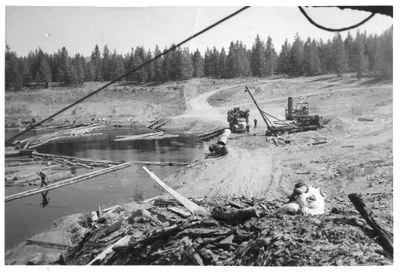 The J&M Lumber Company, which later became Pyramid Mountain Lumber Company Inc, has been in continuous operation since 1949. Originally founded by Oscar Mood and Fred Johnson, it is the oldest surviving family owned and operated lumber mill in Montana. For the last 56 years, Roger Johnson and the Johnson family have been part of the navigation team. Charlie Parke family has been involved in Pyramid since 2000.
The J&M Lumber Company, which later became Pyramid Mountain Lumber Company Inc, has been in continuous operation since 1949. Originally founded by Oscar Mood and Fred Johnson, it is the oldest surviving family owned and operated lumber mill in Montana. For the last 56 years, Roger Johnson and the Johnson family have been part of the navigation team. Charlie Parke family has been involved in Pyramid since 2000.
Since its small beginnings in 1949, Pyramid Mountain Lumber Inc has grown to become the largest employer in the Seeley Lake area. Conquering obstacles has always been a part of the timber business. Pyramid has provided steady employment for local residents in a region where seasonal, part-time
employment is often the norm. According to Roger Johnson, son of founder Fred Johnson, the people are what have made Pyramid a success. “I think that Oscar Mood and Fred found two main ingredients to success here in Seeley Lake. They found some of the finest resources in America, along with the finest work force. The people have meant everything to the success of this business.”
Dr. Perry Brown, Dean of the School of Forestry at the University of Montana, summarizes the heart and soul of Pyramid Mountain Lumber: “Pyramid is a progressive company interested in long-term sustainability of the land and its stewardship.” As the company continues to maintain its respected position in the timber industry, all eyes are on the future as the owners and staff work with landowners, loggers, policy-makers, and other leaders to create active management plans to develop healthy forests.
Pyramid Mountain Lumber, Log Truck
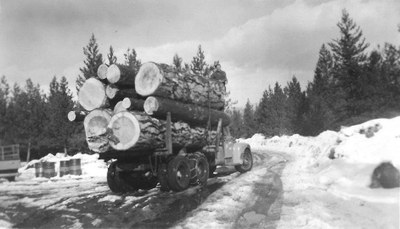 Pyramid Mountain Lumber ensures healthy forests through its commitment to light-on-the-land harvesting methods. While the proper use of technology and engineering is heralded, it is truly the logging professionals, talented sawyers and equipment operators well-trained in stewardship principles who set the foundation for the future. Their abilities include expertise in identifying forest health concerns, streamside management zones, and Best Management Practices.
Pyramid Mountain Lumber ensures healthy forests through its commitment to light-on-the-land harvesting methods. While the proper use of technology and engineering is heralded, it is truly the logging professionals, talented sawyers and equipment operators well-trained in stewardship principles who set the foundation for the future. Their abilities include expertise in identifying forest health concerns, streamside management zones, and Best Management Practices.
Partnerships are the lifeblood of Pyramid. Whether it is leading timber organizations or collaborating with conservation groups, Pyramid is proud of the role is has played in Montana’s timber landscape. Building such partnerships are vital to forest health while also providing the resources necessary to meet the future timber needs of the American people.
Forestry Pioneer
 Stanley Ring was born in Missoula, MT on September 18, 1924. He was raised on ranches in the Helmville, MT area; graduating from Powell County High School in Deer Lodge in 1942. Stanley moved to Missoula shortly after graduation and began an apprenticeship in auto mechanics. In the 1950’s he opened Ring’s Auto Repair which he operated until 1969 when he went to work as a mechanic and equipment development shop foreman for the State of Montana Forestry Division.
Stanley Ring was born in Missoula, MT on September 18, 1924. He was raised on ranches in the Helmville, MT area; graduating from Powell County High School in Deer Lodge in 1942. Stanley moved to Missoula shortly after graduation and began an apprenticeship in auto mechanics. In the 1950’s he opened Ring’s Auto Repair which he operated until 1969 when he went to work as a mechanic and equipment development shop foreman for the State of Montana Forestry Division.
Stanley was employed as an experimental equipment development specialist in Missoula, responsible for maintaining the Forestry Division’s fleet of vehicles and equipment. His primary task was to convert excess military property acquired by the Forestry Division for use in fire fighting and forest management. He was an innovator that knew how to fabricate, repair, and reuse equipment used in rough field conditions.
Stanley was instrumental in the operation of the excess equipment program. He made frequent trips to military bases in the area including Malmstrom AFB in Great Falls; Ft Lewis, WA; Mt. Home, ID; and Hill AFB, Utah to screen and pick up excess military equipment for use in the Montana State Forestry fire fighting and forest management programs. He designed and constructed many wild land fire engines used throughout the State of Montana. Stanley saved the State Forestry Division thousands of dollars in equipment costs over his years of employment.
Stanley retired in 1989 after 20 years of service. He passed away of natural causes December 19, 2010.
Forestry Pioneer
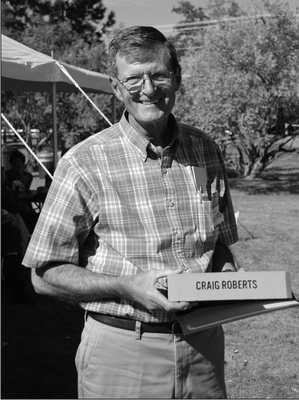 Craig's formal forestry education began at Paul Smiths 'College where he received a degree in Forestry. He then went to the University of Montana earning a B.S. in Forest Management in 1965. He spent the summer after graduation working in Kalispell as a timber management forester and by October he moved into a Cooperative Forest Management Forester position in Kalispell. In June, 1966 he transferred to Missoula and continued working in the Cooperative Forest Management Program, then moved to Plains to open an office in the newly constructed USDA Building. He paneled the basement of the USDA Building with larch paneling provided by the Office of State Forester in exchange for the first years rent. In 1968 he transferred to Hamilton to fill the RC&D Forester position and the following year moved to Helena as the Cooperative Forest management Forester working with all counties east of the Continental Divide.
Craig's formal forestry education began at Paul Smiths 'College where he received a degree in Forestry. He then went to the University of Montana earning a B.S. in Forest Management in 1965. He spent the summer after graduation working in Kalispell as a timber management forester and by October he moved into a Cooperative Forest Management Forester position in Kalispell. In June, 1966 he transferred to Missoula and continued working in the Cooperative Forest Management Program, then moved to Plains to open an office in the newly constructed USDA Building. He paneled the basement of the USDA Building with larch paneling provided by the Office of State Forester in exchange for the first years rent. In 1968 he transferred to Hamilton to fill the RC&D Forester position and the following year moved to Helena as the Cooperative Forest management Forester working with all counties east of the Continental Divide.
In December 1970 he was transferred to Lewistown to open an office out of his home, which eventually became the headquarters of the Northeastern Land Office. Craig began as the Area Forester and retired as the Area Manager in December 2001 after over 36 years of employment.
In 1996 Craig traveled to Valley City, North Dakota and acquired over 400,000 brown-legged spurge flea beetles (Aphthona lacertose) from North Dakota State University and released the beetles on numerous sites throughout central and northeastern Montana. Some release sites developed into extraordinary insectaries from which millions of beetles have been collected and distributed throughout the sttae of Montana. This was the beginning of an alliance by many natural resource agencies working together to control leafy spurge in Montana.
Craig has kept busy in retirement serving several community organizations and state committees. Craig and his wife, Cathy, have two children, both graduates of the University of Montana Forestry School and both working in natural resource fields.
Forestry Pioneer
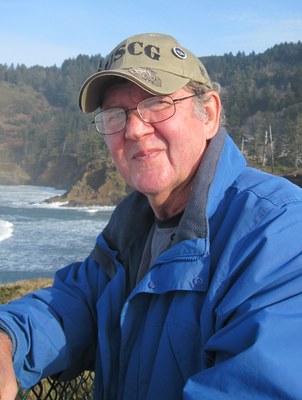 Mark spent 28 of his 33-year career as a professional Forester in Montana. After returning from four years of military service he left his home in Buffalo, NY and enrolled in the University of Montana where he earned a B.S. in Forest Management. While attending UM, Mark worked seasonally as a forestry technician. He was a smokejumper out of the Missoula base for several years before he was converted to a professional Forester at Spotted Bear R.S. Flathead N.F.
Mark spent 28 of his 33-year career as a professional Forester in Montana. After returning from four years of military service he left his home in Buffalo, NY and enrolled in the University of Montana where he earned a B.S. in Forest Management. While attending UM, Mark worked seasonally as a forestry technician. He was a smokejumper out of the Missoula base for several years before he was converted to a professional Forester at Spotted Bear R.S. Flathead N.F.
Mark had many high points during his career. One, was working as district silviculturist on three districts during the Mountain Pine Beetle infestation. Another high point was becoming the District Fire Management Officer at West Yellowstone, during the big fires of 1988. After the fires Mark represented the Gallatin on the Interagency Fire Restoration Team. He was also a member of the West Yellowstone Volunteer Fire Department.
Mark left Montana to become the Forest Fire Management Officer on the Huron - Manistee N.F. in Michigan. During his tenure there Mark got a real feeling for the importance of collaboration between State Forests, the Forest Service and volunteer fire departments. Mark helped the State instruct Fire Operations in the Wildland/ Urban Interface to over fifty volunteer departments. He was instrumental in helping the state develop the Michigan Interagency Wildland Fire Protection Association (MIWFPA). After five years Mark transferred back to the Kootenai N.F. as the Operations Staff Officer and was responsible for the forest’s timber and fire programs.
Mark brought his interagency experiences with him and became the chair of the Northern Region Coordinating Group (NRCG) Operations Committee for three years. There he worked with the regional Incident Command Teams (ICT’s) and quickly found out how lucky the region was having dedicated and committed Incident Commanders. The operations committee was there to provide direction and further interagency cooperation, communication and coordination.
Mark was appointed to be on a unique three-person Regional Fire Safety Oversight team, unique for the region. The team focused on the ICT teams, helping them where needed, including helping to solve and expedite logistical, political (interagency) hang ups. They were successful in working in the region and were requested by Regions 2 and 3 also.
After Mark’s retirement, he came back several fire seasons to be part of the oversight team. He also became a Fire Risk Assessor for Lincoln County. Mark is a supervisor on the Lincoln Conservation District and member of the Lincoln County Planning Board.
Foresty Pioneer
 Dick Rothermel received his B.S. in aeronautical engineering at the University of Washington in 1953. He served in the U.S. Air Force as a special weapons aircraft development officer from 1953 to 1955. Upon his discharge, he was employed by Douglas Aircraft as a designer and troubleshooter in the armament group.
Dick Rothermel received his B.S. in aeronautical engineering at the University of Washington in 1953. He served in the U.S. Air Force as a special weapons aircraft development officer from 1953 to 1955. Upon his discharge, he was employed by Douglas Aircraft as a designer and troubleshooter in the armament group.
From 1957 to 1961, Dick worked for General Electric Co. in the Aircraft Nuclear Propulsion Department of the National Reactor Testing Station in Idaho (now the Idaho National Laboratory). In 1961, Rothermel joined the Intermountain Forest Fire Laboratory where he was engaged in research on the behavior of fire. He received his M.S. in mechanical engineering at Colorado State University in 1971. He was the project leader of the Fire Fundamentals Research Work Unit from 1966 to 1979, and was project leader of the Fire Behavior Research Work Unit from 1979 to 1992. He retired from the Forest Service in 1994 after a thirty-three year career studying fire behavior.
Dick Rothermel is an aeronautical engineer by training. He worked for the Idaho National Engineering Laboratory on building a nuclear powered airplane. In the early 60’s, he was recruited and hired to work at the Missoula Fire Sciences Laboratory. In the early part of his career Dick contributed to development of fundamental understanding of the physics underlying wildland fire spread and intensity. Working with Hal Anderson and Bill Frandsen they developed fuel arrays and instrumentation tailored for the study of fire over a wide range of fuel and atmospheric conditions. Building on the work of his colleagues, in 1972 Dick published a paper outlining a new fire behavior model. This paper is possibly one of the most cited documents in forest fire literature in the world. Following the engineering approach and model in the work, Dick and his colleagues developed guidelines, and models into forms that were useful in the field to operational fire management.
In 1983, Dick was the primary author of the “BEHAVE” fire prediction system and his model is a core calculator in the National Fire Danger Rating System. His model forms the foundation for many modern computer tools such as FARSITE, Flammap, and other primary fire decision support systems. Together the 1972 and 1983 publications are likely the most influential contributions to wildland fire management developed by any single person or group in the world. These works and others developed under Dick’s leadership provided a common language and basic understanding of fundamentals of fire behavior and its relevant factors. In spite of its limitations and of the many announced attempts to produce a replacement to it, the BEHAVE model is still the basis of many fire behavior prediction systems that exist and are being used in the entire world.
Rothermel also contributed to fire science through several other works and publications, and worked in collaboration with scientists from various countries that recognized the value of his contribution and vision for the progress of their investigation. He was requested as an invited lecturer by institutions from several countries.
Rothermel’s work was instrumental in training operational personnel on the fundamentals of forest fire behavior given the logic and simple way he was able to describe the processes and the role of the various parameters involved. Through this better knowledge, he certainly contributed to more efficient and safer fire management and suppression. Dick gave a life-long contribution to forest fire science and management that deserves recognition by the entire community.
In 2013, Dick received the prestigious “Ember Award” for life achievement in wildland fire from the International Association of Wildland Fire.
Forestry Pioneer
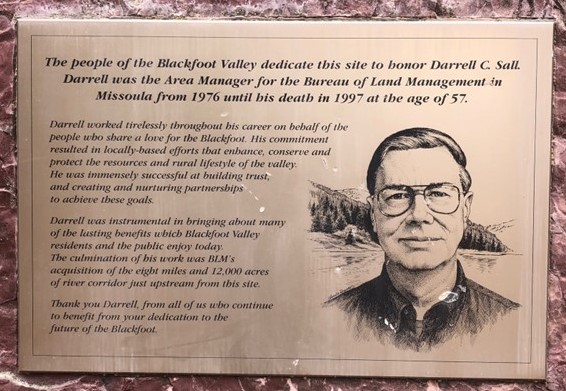 Darrell Sall served as the Area Manager of BLM’s Garnet Resource Area (now the Missoula Field Office) for 21 years. He was a true multiple use thinker and doer. Quick to see opportunities that would benefit both public and private interests, he took the initiative to work with all parties interested in the management and use of BLM land.
Darrell Sall served as the Area Manager of BLM’s Garnet Resource Area (now the Missoula Field Office) for 21 years. He was a true multiple use thinker and doer. Quick to see opportunities that would benefit both public and private interests, he took the initiative to work with all parties interested in the management and use of BLM land.
Two early efforts set the stage for future success. Determined to foster ‘cooperative conservation’ projects, Darrell worked with private landowners to bring about the first walk-in Block Management Area (BMA) in Montana. Then, at a time when Garnet Ghost Town was mostly abandoned and deteriorating, he began talks with former residents and their descendants to stabilize and preserve the old town as an authentic example of Montana’s disappearing past. Today, the Blackfoot BMA and Garnet Ghost Town are heavily used and enjoyed by a wide-cross section of the public.
Always a strong advocate for active management of BLM’s forests and rangelands, Darrell also nurtured support for innovative ideas and management with local interests; BLM’s upper level managers and those with an eye toward the commercial use of public resources. Some examples of this include:
Pioneered early efforts to improve recreation management in the Blackfoot River corridor. This work resulted in a first of its kind agreement among federal and state agencies and corporate and private landowners to implement a cooperative Blackfoot River Corridor Management Plan. This at a time when public access to Montana waterways was being hotly contested by other private landowners. This agreement remains in place today and provides public access in key areas to the river while addressing concerns by private owners.
Darrell worked relentlessly to acquire and protect Blackfoot River corridor lands. Eventually, Plum Creek Timber agreed to exchange with BLM almost 12,000 acres of their lands in the corridor upstream from McNamara’s Landing and Johnsrud Park. BLM’s acquisition of these key lands in 1998 served as a catalyst for future acquisitions in the Blackfoot by The Nature Conservancy, and the eventual transfer of most of that land into public ownership.
Darrell, along with three other ‘old timers’ in the Blackfoot watershed, were the godfathers of the Blackfoot Challenge. He recognized the need for the Challenge because of a lack of communication between landowners and other people in the area. He initiated the establishment of a core group of individuals that shared a common vision for the Blackfoot Watershed. Darrell persevered in these efforts to convince private individuals of the need to work together and stay involved to achieve their shared goals. Long before the Challenge was formally organized and named, these individuals understood that a private-public partnership could be the key to long term conservation and management of natural resources and serve as an important vehicle in sustaining rural communities. Today the Blackfoot Challenge is looked to by other groups across the country as a model for forming these kinds of partnerships.
Long before the Challenge was formally organized and named, these individuals understood that a private-public partnership could be the key to long term conservation and management of natural resources and serve as an important vehicle in sustaining rural communities. Today the Blackfoot Challenge is looked to by other groups across the country as a model for forming these kinds of partnerships.
For his many accomplishments, Darrell was selected by the Public Lands Foundation as the 1996 Outstanding Public Lands Professional of the year.
Darrell died in 1997 while still serving as BLM’s Area Manager in Missoula. He is remembered by his friends and colleagues today as someone who was quiet, thoughtful, and very effective in “doing what is right” for the land.
Since 1998 his legacy is honored by the Blackfoot Challenge annually with presentation of “The Darrell Sall Conservation Award” to individuals and organizations for significant contributions to natural resource management and rural community values in the Blackfoot Watershed.
Forestry Pioneer
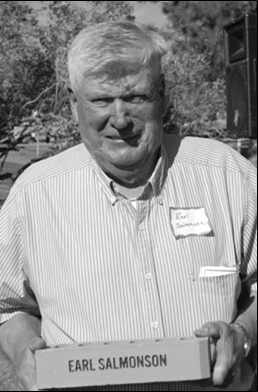 Earl is a 1956 graduate of the University of Montana Forestry School. He's worked for the J. Neils Lumber Company, Northern Pacific Railway, and McCue Construction.
Earl is a 1956 graduate of the University of Montana Forestry School. He's worked for the J. Neils Lumber Company, Northern Pacific Railway, and McCue Construction.
Earl worked in the Office of the State Forester from 1958-1988. He served as the Assistant District Forester in Kalispell, the District Forester in Eastern Montana, Branch and Bureau Chief of Forest Management and Governor Schwinden's Wilderness Committee. He was the Assistant Scout Commissioner for the Mullan Trail District.
In his retirement he has volunteered with Habitat for Humanity, St. Anthony's Parish and the Poverello Center.
Forestry Pioneer
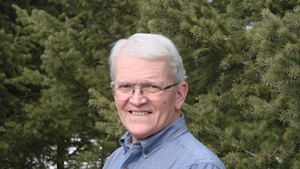 Gordy Sanders has demonstrated exemplary actions for the past 50 years that have influenced local, state and national policy. Gordy received his B.S. in Forest and Range Management from the University of Minnesota in 1971. From 1972 to 1993, he worked as the Procurement Manager, District Land Manager, and Forester for Champion International Corporation. While working for Champion, Gordy obtained his Masters in Forest and Range Management from Washington State University in 1986. After Champion sold in 1993, he worked for Plum Creek Timber Company where he served as the Senior Forester and Manager of Log Planning and Procurement. Gordy has been the Resource Manager for Pyramid Mountain Lumber Inc. in Seeley Lake since 1996, and recently retired.
Gordy Sanders has demonstrated exemplary actions for the past 50 years that have influenced local, state and national policy. Gordy received his B.S. in Forest and Range Management from the University of Minnesota in 1971. From 1972 to 1993, he worked as the Procurement Manager, District Land Manager, and Forester for Champion International Corporation. While working for Champion, Gordy obtained his Masters in Forest and Range Management from Washington State University in 1986. After Champion sold in 1993, he worked for Plum Creek Timber Company where he served as the Senior Forester and Manager of Log Planning and Procurement. Gordy has been the Resource Manager for Pyramid Mountain Lumber Inc. in Seeley Lake since 1996, and recently retired.
Gordy has left an indelible mark in so many numerous ways. In the early 1980’s, with increase in Skyline harvest and challenges in prescribed fire, Gordy pursued strategies and implementation of Heli-torch burning on complex burns. His professional action and approach developed into presentations which he gave as an instructor at the National Wildfire Coordination Group interagency training session at the USFS Fire Lab. Attendees were from State, Private, USFS, BLM and Tribal organizations from across the Western U.S.
In the early 1980’s, he led a task force to design and develop the SAF Forestry Interpretive Area at Fort Missoula. This area has become a world-class museum that is experienced by thousands of people.
As a professional and person of action, Gordy recognized the need and benefit of educating private landowners on active forest management, harvest practices, ecological sustainability and the possibility of a restrictive Forest Practices Act being passed in Montana. He was instrumental in working collaboratively with various interests from Industry, Logging community, Forest Service, State of Montana, Department of Environmental Quality, EPA, and Environmental Community and developed Montana’s Voluntary Forestry Best Management Practices (BMP) in 1987. As a Steering Committee member, he helped develop the educational materials and delivery strategy to Industry Foresters and Loggers across Montana. The BMP workbook developed for training purposes has been adopted and used by other states in the United States, and other countries such as Chile and Mexico. Gordy discussed and shared at length Montana’s voluntary approach through a joint effort by State of Montana and Forest Service International Forestry program led by Sally Collins. Gordy participated in this effort titled “Rethinking Forest Regulation” which included foresters and Forest Ministers from China, India, Brazil, Mexico, Peru, New Zealand, and Asian rim countries.
In 1987, Gordy co-authored House Joint Resolution 49 which directed Montana Environmental Quality Council to study application and effectiveness of Montana’s Voluntary Forestry Best Management Practices. He also co-authored Montana’s Streamside Management Zone (SMZ) Act in 1991 with the Audubon Society, Trout Unlimited, and Montana Logging Association. He also co-authored implementing rules and regulations for the new SMZ Act, and drafted original training materials for industry and agency practitioners. His contributions have had a lasting impact on forest policy.
In 1991, Gordy participated on the Montana State University Extension Forester Advisory Committee which developed Montana’s Forest Stewardship Workshops for Private Landowners. These workshops have been attended by thousands of resident and non-resident landowners to learn more about their own forested land and to write their own forest management plans.
Gordy also co-founded the Forest Stewardship Foundation 501-(c)3 to promote education for landowners, and the Montana Forest Owners Association 501-(c)6 designed to lobby, when necessary, in the state legislature. Their collective efforts have been replicated elsewhere around the United States where Forest Practices Acts are absent.
In 2002, Gordy recognized the need for well prepared Line Officers within the USFS that may not have a forestry background. Gordy initiated a collaborative discussion with an environmental consultant, and the Dean of the University of Montana College of Forestry and Conservation (UM CFC) and to develop a Leadership Training program for District Rangers and Staff Officers. By 2003, the first Middle Leader Training program was conducted as a consortium with UM CFC, UM Business School, University of Idaho College of Forestry & Business School, for 30 attendees who competitively applied for attendance and were selected by the USFS. The following years, representatives from USFS Regions 1, 2, 3, 4, 5, and 10, and BLM attended. The leadership training has influenced well over 300 attendees– many of which are now District Rangers, Staff Officers, and Forest Supervisors. Several years ago, what started with Gordy’s idea in Region 1 titled “Being a Leader in the Forest Service”, has now become the model for the USFS national “Middle Leader Training Program”. Gordy broke new ground, and was involved as a presenter, serving on the steering committee for over ten years.
Because of Gordy’s outstanding innovation and reputation, in 2006 he was approached by a facilitator who wanted to get a small group of individuals with different interests together to discuss developing “common ground” on active forest management on our National Forest Lands. The goal was to increase level of management activity on the ground for all interests, and reduce appeals and litigation. This group of nine steering committee members convened a group of 34 diverse stakeholders on January 30th, 2007 to discuss issues. Through Gordy’s leadership as co-chair, they completed “Restoring Montana’s National Forest Lands, Guiding Principles and Recommended Implementation” on August 1st, 2007. These 13 Principles streamlined the process and information for Forest Service decisionmakers through collaborative discussions with individual Restoration Committees. This model created the momentum, interest, and incentive for Senator Bingaman’s Collaborative Forest Land Restoration Act (CFLRA) in 2009.
Gordy’s influence through collaboration has seen increasingly more efficient and effective planning which helped increase the pace and scale of stewardship and restoration activities. Over a ten year period, there have been no lawsuits on the Bitterroot National Forest, and one on the Lolo National Forest. The Restoration Principles edition have been utilized across the country as a reference or model to follow. Gordy has shared this perspective to numerous groups that “collaboration in the key to managing our national Forest Lands in the future.”
In 2001, the first Stewardship Pilot projects on USFS lands were authorized which allowed for “Goods for Services” and “Best Value Award” to purchasers. Gordy and Pyramid Mountain Lumber are considered one of the Stewardship leaders from private industry, and he has given numerous presentations on this topic to the BLM from Montana and Dakotas, Intermountain Logging Conference, USFS Washington Office, Western Forest Economists Symposium, Pacific Logging Congress, and the Western Governors Association. He has also presented to university students from the University of Montana, Iowa State University, Oregon State University, University of Washington, Washington State, University of Nebraska, as well as to student groups from various countries through International Exchange coordinated by Environmental Studies Dept at UM.
Gordy has taught implementation of Tribal Forest Land Protection Act, and the Stewardship Contracting provisions included in the congressional legislation for seven different Aboriginal Tribes from Montana, Idaho, and Washington.
In 2006, Gordy initiated a collaborative effort eventually titled “Blackfoot Clearwater Stewardship Pilot” which became a piece of Senator Tester’s Forest Jobs & Recreation Act (FJRA). The Blackfoot Clearwater piece created the common thinking and support for FJRA, but more significantly, national interest in “place based” legislative initiatives are commonplace today. The long-term relationships that are created in these efforts become hugely beneficial moving forward to other efforts which are mutually beneficial for the greater good.
As Chair of the Montana Forest Restoration Committee in 2016, Gordy led its transition into a broader more statewide effort: “Montana Forest Collaboration Network” (MFCN) which he also chairs. MFCN’s mission is “Assisting collaboration in forest and grassland restoration, conservation, and resource utilization for the benefit of all.” Currently, there are 23 Collaboratives participating in MFCN.
In 2019, Gordy was appointed to the Montana Forest Action Advisory Council by Montana Governor Steve Bullock. The panel was charged with assessing the condition of the state’s forested land and crafting a plan by the fall of 2020 that includes areas in need of restoration or management through activities like logging. It’s also meant to develop ways to accomplish “landscape-style forest restoration” that was included in the governor’s “Forest in Focus 2.0 Initiative”. In 2021, this council evolved into the Montana Forest Action Council, which Gordy co-chairs with the Montana State Forester.
Gordy has served as a sounding board and has provided advice and legislative language to numerous congressional staff, Congressmen, Governors, Directors of SAF National Forest policy for many years. He also served on the MT SAF and National SAF Committee on Forest Policy.
Forestry Pioneer
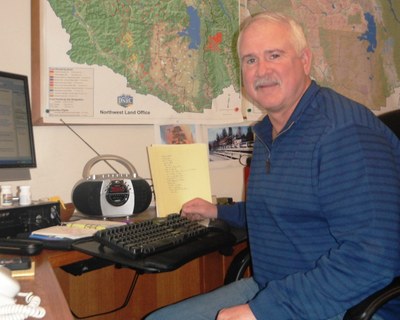 Bob is a second generation Department of Natural Resources & Conservation (DNRC) employee, whose father, Richard, was the Fire and Aviation Management Bureau Chief for many years, and is himself a Forestry Pioneer.
Bob is a second generation Department of Natural Resources & Conservation (DNRC) employee, whose father, Richard, was the Fire and Aviation Management Bureau Chief for many years, and is himself a Forestry Pioneer.
Bob received a Bachelor of Science in Forest Resources Management from the University of Montana. He began his firefighting career as a seasonal with the Department of State Lands (DSL) the night of his 18th birthday in the 1977 on the Pattee Canyon Fire in Missoula. In 1984, Bob was hired permanently by the DSL as the first Libby Unit Fire Technician when the State completed a block exchange of fire protection with the United State Forest Service. In 1985, he transferred to the Stillwater Unit as their Fire Forester. In 1993, his job was changed to include the Lands Program. While living at Olney, Bob also served on the Olney Fire Department and eventually served as Assistant Fire Chief.
From 1996 until 2005 he served as the Stillwater Unit Manager and concurrently managed the Swan Unit from 1998 to 2002. In 2006 he was hired as the Northwestern Land Office Area Manager and held that position until his retirement at the end of 2011.
Bob fought wildland fires for 34 years. He became qualified as a National (Type I) Incident Commander and Type I Operations Section Chief, and served on Interagency Incident Management Teams for 14 years. He is believed to be the first DNRC employee to pass the Advanced Incident Management Course as an Incident Commander. Bob championed efforts to improve relations between local governments and large fire organizations throughout Montana. He encouraged and supported State employees becoming involved with interagency fire operations, including employees in other agencies. He managed numerous difficult wildland fires in Montana and across the west. Perhaps his most challenging assignment was managing an evacuation center in San Antonio, Texas during the Hurricane Katrina and Rita Response in 2005 that housed approximately 16,000 evacuees. Bob was also one of few DNRC employees to become qualified as a Type I Burn Boss, including the use of aerial ignition and he widely promoted the use of prescribed burning on State lands. He was the principle developer of Montana’s initial-attack engine squad training that included the use of a Department-developed Vision Tape and live fire exercises. He was the principle developer of the DNRC’s Critical Incident Management Policy and was DNRC’s first Critical Incident-Management-Team Incident Commander.
During his career, Bob was a Project Leader and Decisionmaker for unique and complex agency projects, including the Whitefish Neighborhood Plan, the Goguen Land Exchange, the Salish & Kootenai Tribal Land Exchange, rapid large-fire salvage efforts, and multiple residential and commercial land use activities including the transformation of Section 36 in Kalispell. The Section 36 effort included a new DNRC Land Office, Flathead National Forest Headquarters, Kids Sports recreational fields, and extensive commercial, residential, and office developments. He pushed DNRC to develop environmental analysis documents that were easily understood by any reader, yet still defendable to scientific/legal review. He wrote dozens of Positions Descriptions for positions around the State to improve employee classification relative to other State-agency employees, and he continually pushed the agency to improve personnel management, career development and succession planning. He sat on the agency Career Development Task Force, and he was the inaugural Chairman of the Leadership DNRC Steering Committee. He was an Agency Representative on the Flathead Basin Commission, the Crown of the Continent Committee, the North Fork Interlocal Group, and the Swift Creek Coalition Board. He was an Agency Representative for multiple projects on State Trust Lands with Montana Department of Transportation and Montana Fish, Wildlife, and Parks. He developed the first Agency field-level Strategic Plan and Business Plan; and, he was the Agency Representative for construction of the first LEED certified office complex by the State of Montana.
Bob served 8 years on the Leadership Flathead Board of Directors. He currently serves as the ALERT Advisory Board Chairman (local emergency response aircraft). He sits on the Kalispell Regional Medical Center Foundation Board and the Flathead Lake Cherry Growers Association Board. He is Secretary/Treasurer of his Home Owner’s Association, President of St. Peter Lutheran Church in Whitefish, Montana, and directs the Church Choir.
During his career, Bob received 6 Certificates of Appreciation. He was awarded the Richard J. Sandman Wildland Fire Trainer of the Year in 1994. He received the 2002 Area Manager’s Award, the Governor’s Excellence in Performance Award in 2005, and the Trust Lands Division Administrator’s Award in 2007.
Bob and his wife Paula have 4 grown children, Stacia Fisher, Brandan Rohrer, Ashley Rohrer-Smith, and Logan Sandman; and, 2 grandchildren, Hamish and Liam Fisher.
Forestry Pioneer
 Dick Sandman was born in Minot, North Dakota in 1934, went to grade school in South Dakota and graduated from the University of Montana with a Bachelor's degree in Forestry in 1956. He then worked a time for the United States Forest Service and then went to work for State Forestry in the fall of 1957.
Dick Sandman was born in Minot, North Dakota in 1934, went to grade school in South Dakota and graduated from the University of Montana with a Bachelor's degree in Forestry in 1956. He then worked a time for the United States Forest Service and then went to work for State Forestry in the fall of 1957.
He worked for State Forestry for over 27 years starting in the Stillwater State Forest, where he established a system for marking roads and areas. The signs were handmade, and later when they opened the Youth Camp in the Swan they had a wood shop there to make all the signs used by the State. From the Stillwater he was transferred to Helena to open the New Helena Unit office. When Rod Krout retired, he was transferred to Missoula, where he took over as Chief of the Fire Management Bureau. He remained as Chief until he passed away unexpectedly in 1985.
Dick was primarily responsible for evolving the program of acquiring excess military equipment from various military bases and received one of two National Fire Awards for this program. He was active in the Intermountain Fire Council and served several years as the secretary/treasurer. During that time he established a scholarship program by investing the funds and then at each yearly meeting awarded a few scholarships to deserving forestry school students.
Dick was principally responsible for the County Cooperative Fire Program, with the last few counties entering the program in 1985 (making it Statewide). He received a letter of recognition from Governor Schwinden, a posthumous award for his efforts from the Montana Association of Counties, and his second National Fire Award. He also received a Distinguished Alumni Award from the U of M Forestry Alumni Association.
Dick was an active member of the Intermountain Fire Council, Western Forestry, First Lutheran Church in Missoula, where he taught confirmation for seventeen years, and the Board of Control-Concordia College in Portland Oregon.
Forestry Pioneer
Royce Satterlee served as Vice President and General Manager of Stoltze Land & Lumber a major forest products industry employer in Northwest Montana.
Forestry Pioneer
 Mark J. Schoknecht moved to Montana as an infant with his family in 1912 after his grandfather Julius Neils purchased the lumber mill at Libby.
Mark J. Schoknecht moved to Montana as an infant with his family in 1912 after his grandfather Julius Neils purchased the lumber mill at Libby.
After studies at Flathead High School, Valparaiso University and the University of Washington, Mark spent 44 years working in the timber industry. During his career, he served with distinction as the Chairman of the National Forest Products Association committee on Forestry Affairs and guided efforts with Congress and federal agencies. His model for weight scaling was adopted by the Forest Service in 1965.
He served as a member of various local, state, regional and national forestry and industry groups. Mark passed away in 2005.
Forestry Pioneer
Bill Schultz graduated from the University of Montana and began his career with DNRC in 1979 as a forest hydrologist. For the next 25 years, he helped develop the hydrology and watershed modeling programs and processes for the Trust Lands Forest Management Division (TLMD), which has been emulated by several other states. He was critical in establishing best management practices (BMP) for TLMD timber sales, ensuring that naturally-occurring water quality and quantity issues were separated from management-induced impacts, and helped ensure the viability of both watersheds and the forest management program. He was methodical and detailed in his hydrology/watershed analyses for individual timber sale projects throughout his tenure as hydrologist.
Bill was also instrumental in the development of forestry BMPs for the adoption of formal BMPs and development of a monitoring process for the state of Montana in 1989, and passage of the BMP notification law that same year. He was also integral in the passage of and development of administrative rules for the Streamside Management Zone (SMZ) law passed in 1991, and helped with audit teams for several years after.
Bill was ultimately promoted to the Supervisor of the Forest Management Section, and worked in that capacity for several years prior to moving to Water Resources Division to manage the Missoula Regional Office for five years. He then moved on to become the administrator of the Reserved Water Rights Compact Commission, and was instrumental in bringing the CSKT compact before the 2013 legislature. Although it failed in that attempt, the groundwork and dialogue with legislators and the administration helped facilitate its ultimate success during the 2015 legislative session.
Bill retired in 2013, and enjoys cycling, hiking, hunting, skiing, volunteer trail work and trail access advocacy, and spending time with his kids and new grandson.
Forestry Pioneer
Early in his career, state forester Gary Moon reorganized the Department of State Lands into three divisions: Timber Management, Fire Protection and Hazard Reduction. Herman Schultz was the first head of the Hazard Reduction Division. He also served as a Slash Inspector and District Forester in the Kalispell Area.
During his tenure in Kalispell, he helped select the location and design of the Northwestern Land Office.
Forestry Pioneer
 Ray was born in Anaheim, California to Howard and Louise Shearer. He graduated from Utah State University with degrees in Timber Management (BS), and Forest Silviculture (MS) from Utah State University, and later a Ph.D. from the University of Montana.
Ray was born in Anaheim, California to Howard and Louise Shearer. He graduated from Utah State University with degrees in Timber Management (BS), and Forest Silviculture (MS) from Utah State University, and later a Ph.D. from the University of Montana.
In 1958, Ray and his wife Barbara moved to Missoula, Montana where Ray began his work as research silviculturist. Upon completion of construction, he moved into the USFS Forestry Sciences Lab, on the University of Montana Campus. Ray did research on Forest and Woodland Ecosystems in western Montana and northern Idaho.
Ray worked in this field for approximately 46 years. He was very dedicated and passionate about his research, focusing on his favorite seral tree species, the Western Larch. His life as a researcher was dedicated to this wonderful and unique conifer tree species. He, along with his many fellow science researchers, did massive amounts of research and published countless professional papers and data on Western Larch and its ecosystems in the western United States. He studies fire effects on forest ecosystems, silviculture practices, site preparation, forest regeneration and spacing control to promote health and grown of the Western Larch.
Ray was instrumental in creating and overseeing key forest management research at the Miller Creek Demonstration Forest located on the Lolo National Forest near Missoula, Montana, and the Coram Experimental Forest in the Flathead National Forest near Coram, Montana and Glacier National Park. He spent the greater part of his professional career doing research work on the Coram Experimental Forest. Ray, with his good friend and colleague Wyman Schmidt, developed the award-winning “Walk with Larch” educational and discovery area at Coram Experimental Forest. This research discovery area is still open to the public, college academia, forest practitioners and area school classes.
Growing vigorous and healthy trees and managing those forest stands for future generations, while maintaining and improving healthy ecosystems today and into the future, was his life’s professional passion. He had a tremendous amount of personal energy and passion for his and his fellow scientists’ research. Be it in the woods with fellow foresters, in the college classroom, or presenting scientific data and project results at professional conferences, or in discussion with the general public, this was where Ray showed his dedicated passion to enhance and promote good forest management and healthy ecosystems.
Ray’s energy and knowledge were infectious! He gave us a great deal of valuable scientific information, research and data support, and lots of great food for thought over his many years of professional service. With his recent passing, his work will be of great benefit to all resource managers and fellow scientists, and especially for those who follow in his footsteps.
Ray was always there to talk, show, and help foresters in their forest management decision process. He could show his research in the field at the Coram Experimental Forest and yet talk in understandable layman terms. He was a tremendous informational asset to foresters and to our federal and state forest industry. Ray will be missed, but we were fortunate to know him, to have him as a fellow forester and an advocate for good forest management in promoting healthy and productive forests—both now and into the future. He made huge contributions to Montana’s forestry profession and timberlands.
Ray and Barbara raised their 10 children in Missoula. He loved God, his family, and the beauty and grandeur of Western Montana. Ray was a longtime member of the Society of American Foresters and an SAF Fellow. As a youth he earned the Eagle Scout award. As an adult he served for decades as a scout leader, receiving the prestigious Silver Beaver National BSA ward.
He was broadly known for his consistent warm and welcoming smile and was fondly referred to as “Smiling Ray” by many who knew him—both in and out of his forestry circles. He was also known as “Mr. Western Larch” by those professionally associated with him.
His love of nature was apparent to any who were fortunate to spend time with him. He often remarked to his children that he “couldn’t believe he got paid to do his job because he loved it so much!” While he was a wealth of knowledge about the natural world, his fondness of the Western Larch was easy to discern. He involved his family in outdoor activities—camping trips to Glacier National Park, day trips to local trails, picnics up Pattee Canyon, visits to the Coram Experimental Forest and Miller Creek Research Area. Highly anticipated by his children was their eighth birthday, when they were able to join in his annual family backpacking trip into the Rumble Creek Lakes in the Swan Mountain Range.
Sadly, Ray passed away in Missoula on February 5th, 2019, at the age of 83 years. Ray was preceded in death by his wife Barbara. Ray’s legacy and dedicated research contributions to Inland Region Forest timberland management still guides foresters today in their ecosystem and timber management decisions to promote healthy and productive forests.
Forestry Pioneer
 A native Montanan, Ellen was born, raised and educated in Butte. A strong background in the development and use of natural resources came from her hard rock miner dad and Red Lodge farm raised mother. In 1981, Ellen started down the Montana State Legislature path as committee staff, first during the session and then with the Montana Environmental Quality Council for 14 years. Ellen left the EQC to strike out on her own as an independent contractor working as a lobbyist and association executive for numerous clients. Ellen spent 10 years as the Executive Vice President of the Montana Wood Products Association, a trade association of forest industry businesses. She ended her career as a principal in Simpson & Associates, a consulting firm specializing in energy development and government affairs. Ellen passed away March 23, 2012.
A native Montanan, Ellen was born, raised and educated in Butte. A strong background in the development and use of natural resources came from her hard rock miner dad and Red Lodge farm raised mother. In 1981, Ellen started down the Montana State Legislature path as committee staff, first during the session and then with the Montana Environmental Quality Council for 14 years. Ellen left the EQC to strike out on her own as an independent contractor working as a lobbyist and association executive for numerous clients. Ellen spent 10 years as the Executive Vice President of the Montana Wood Products Association, a trade association of forest industry businesses. She ended her career as a principal in Simpson & Associates, a consulting firm specializing in energy development and government affairs. Ellen passed away March 23, 2012.
Forestry Pioneer
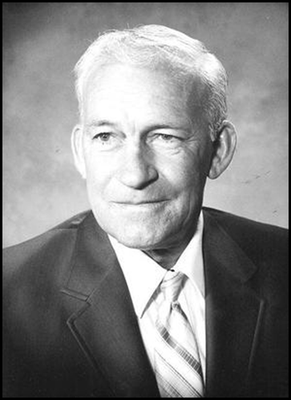 Clyde was born in 1926 in Littlefork, Minnesota. He graduated from Littlefork High School in 1944, and enlisted in the US Navy, where he worked in aviation ordnance. Clyde attended diesel school in Memphis, Tennessee in 1948. He married Bonnie Briggs in 1951, and in 1953 they moved to Montana. He became a logger in 1948 and founded the Smith Logging Company in 1964. He worked as a logger until his retirement from the profession in 1989.
Clyde was born in 1926 in Littlefork, Minnesota. He graduated from Littlefork High School in 1944, and enlisted in the US Navy, where he worked in aviation ordnance. Clyde attended diesel school in Memphis, Tennessee in 1948. He married Bonnie Briggs in 1951, and in 1953 they moved to Montana. He became a logger in 1948 and founded the Smith Logging Company in 1964. He worked as a logger until his retirement from the profession in 1989.
Clyde was elected to the Montana House of Representatives in 1983 and served until 1990. He was appointed to the Governor’s Natural Resources Advisory Council, Governor’s Workers’ Compensation Advisory Council and was on the Board of Directors of the State Compensation Mutual Insurance Fund. He was very instrumental in getting workman’s compensation insurance changes made.
Clyde was the co-founder of the Montana Logging Association and was named the Logger of the Year in 1980. He was co-founder of the ALERT Foundation, a helicopter rescue program.
Clyde provided $2,500 in seed money for the Flathead Chapter of Society of American Foresters scholarship fund, which today is a $12,000+ fund, and provides two scholarships to Flathead Valley Community College and Salish Kootenai College.
In 1981 he was named as the family-owned Business Advocate of the Year and won the Great Chief’s Award from the Kalispell Chamber of Commerce and was given an honorary membership in the Society of American Foresters, the first and only logger to achieve such recognition.
Clyde is survived by four children, Rick, Barry, Wendy and Pam, 15 grandchildren and 15 great-grandchildren.
Forestry Pioneer
 Thomas C. Spaulding obtained his undergraduate degree in biology at Montana State University in 1906, and returned to Missoula after obtaining a Master of Forestry at Michigan, to teach at the new School of Forestry in 1916. He served as Dean of the Montana School of Forestry from 1924 through 1945.
Thomas C. Spaulding obtained his undergraduate degree in biology at Montana State University in 1906, and returned to Missoula after obtaining a Master of Forestry at Michigan, to teach at the new School of Forestry in 1916. He served as Dean of the Montana School of Forestry from 1924 through 1945.
During World War I he took a leave of absence from this academic post to serve in the US Army in France. Spaulding became part of the famed Forestry Engineer Regiment. The troops of the 10th and 20th Engineers, along with several other engineering regiments and battalions, were eventually combined in October of 1918 into the 20th Engineers (Forestry), the largest regiment in the entire American Army. The Engineers operated in various areas of France’s forestlands, managing forest growth, felling and logging timber, and operating sawmills. The men of these regiments produced wood that was then transported to American forces throughout Europe. The wood was used for building roads and railroads, constructing barracks, erecting telephone poles, supporting trenches, and various other building and construction projects. The already highly experienced men making up the regiments, recruited from the entire US, were able to streamline the lumber manufacturing process almost immediately. The forestry units would greatly exceed all expectations of production. The mills they operated produced over three times their rated capacity.
Following the war, Thomas Spaulding returned to Missoula and resumed teaching at the University. During the summers he also served as a Forestry Fire Warden for the Blackfoot Forest Protective Association from 1921 to 1932. He was appointed Dean of the School of Forestry on September 25, 1924. Once he became Dean he realized that the School had only a limited ability to do research and no place to do it. The School, in cooperation with the US Forest Service, did utilize their Priest River Experiment Station, which had been established in Idaho in 1911, but it was a long way from Missoula. In 1927 he began long, patient negotiations with the Anaconda Company, and W.C. Lubrecht, the General Manager of the Anaconda Copper Mining Company’s Lumber Division.
Ten years later, in 1937 Spaulding’s patience bore fruit. To quote Lubrecht, another Forestry Pioneer, “A conference was arranged between officials of the Anaconda Copper Mining Company and the Montana State University at which time an area of eight to nine thousand acres was discussed and encouragement was given to the end that in due time grant of this territory would probably be given. When the time arrived to reconsider this grant for definite conclusion, Dean Spaulding displayed an increase in his ambition and raised the request to an increased area of about seventeen thousand acres and, through his persistence, a deed was recently given to the Montana State University covering practically all the timber lands in the Elk Creek Drainage.” This is the origin of the Lubrecht Experimental Forest.
Spaulding remained Dean until 1945. He served as Dean for some 22 years. Under his tenure, he was finally able to secure the School a forest (Lubrecht) and establish the Montana Forest and Conservation Experiment Station to enable research. His concerns about research and the academic direction of the School illustrate a tireless effort for improvement. He worked with students to establish the Forestry Club and the Druids. He encouraged the expansion of the tree nursery on Campus. The Forestry Alumni Association established a scholarship to honor him in 1979.
Forestry Pioneer
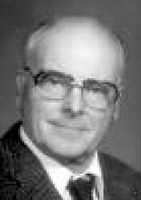 Bob Steele received a BS in Forestry from Colorado State University, a MS in forestry from the University of Michigan, and a PhD in Forest Fire Science from Colorado State University. He served in the U.S. Navy during WWII, then worked as a research forester for the Forest Service in Washington for 10 years, and as a forester for SDS Lumber in Bingen, WA for one year.
Bob Steele received a BS in Forestry from Colorado State University, a MS in forestry from the University of Michigan, and a PhD in Forest Fire Science from Colorado State University. He served in the U.S. Navy during WWII, then worked as a research forester for the Forest Service in Washington for 10 years, and as a forester for SDS Lumber in Bingen, WA for one year.
In 1955 he joined the faculty at the University of Montana School of Forestry, where he taught with distinction and served as principal professor at Lubrecht Experimental Forest until his retirement in 1982. He ranched in Corvallis and spent time fishing and canoeing at Georgetown Lake. Bob passed away in 2008.
Forestry Pioneer
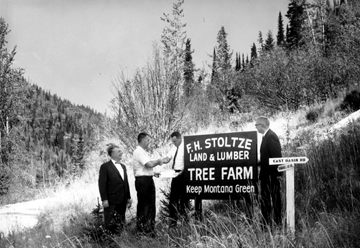 F.H. Stoltze of St. Paul, MN, came to the Flathead Valley in the late 1890's through association with James Hill and the Great Northern Railroad. Stoltze was involved in a number of business opportunities, forming lumber companies, and acquiring mills and timberlands.
F.H. Stoltze of St. Paul, MN, came to the Flathead Valley in the late 1890's through association with James Hill and the Great Northern Railroad. Stoltze was involved in a number of business opportunities, forming lumber companies, and acquiring mills and timberlands.
F.H. Stoltze Land Company was formed on August 31, 1912. In 2012, they celebrated the centennial of the company's leadership in forestry throughout the Flathead region. Stoltze Land & Lumber is widely respected for innovation in the forest industry in Montana.
Forestry Pioneer
 Craig is a veteran forester of western Montana. Graduating from the University of Montana in 1971 he immediately became involved with many different production aspects of the major timber players of the area. From a start of cat skinning, cruising, scaling, and timber marking, he collected his stride in logging production and manufacturing at the Bonner site. First with Anaconda and US Plywood, then staying with Champion through the years of high production plywood and lumber operations at the Bonner operation, Craig oversaw maximum production rates of 443 loads/day by truck and rail.
Craig is a veteran forester of western Montana. Graduating from the University of Montana in 1971 he immediately became involved with many different production aspects of the major timber players of the area. From a start of cat skinning, cruising, scaling, and timber marking, he collected his stride in logging production and manufacturing at the Bonner site. First with Anaconda and US Plywood, then staying with Champion through the years of high production plywood and lumber operations at the Bonner operation, Craig oversaw maximum production rates of 443 loads/day by truck and rail.
During the construction of the facility at Bonner he conceived of and developed a log quality system that was copied by all major industry players west of the Mississippi. He implemented and successfully guided the Rocky Mountain operations of Champion International through the integration of log manufacture, sort, and delivery to sixteen conversion centers scattered over a 400 x 600 mile area. Log lengths were maintained at a 98% tolerance at all locations during this period. Most of the log quality standards that persist to this day were developed during Craig's management and remodeling of the processing core at the Bonner facility.
Craig's post-Champion adventures include the building and operation of a successful sort yard in the Bitterroot Valley with logs delivered to various mills in Western states by rail. Many of the timber products were delivered through his consulting operation. A small custom-built sawmill at this site provided large local mills with cedar cants and side lumber from oversized material shipped in by rail and out by truck. During this period Craig also managed a logging operation that specialized in remote grinding operations. During this period Craig helped perfect both the Bandit 3680 and the Vermeer 6000 large grinders, and was a partner at All Woody a division of Cky-Ber Enterprises that developed a roll-off system for chips, biomass, and log handling.
Craig has been honored by many professional organizations for his innovation and industry leadership. In 2009 the University of Montana awarded Craig with a Distinguished Alumnus Award In recognition of Outstanding Contributions. Craig is co-founder of Cky-Ber Enterprises Inc., (est. 1989) and as VP, is leading the company through the development and implementation of a biomass platform for Integrated Biomass Technologies with promise to reduce particulate and greenhouse gas emissions from a variety of thermal plants on a global scale.
For a full appreciation of Craig's exploits and accomplishments, see his first book, Regurgitations of a Montana Woodsman and website ckyber.com.
Forestry Pioneer
 Paul Uken aka; “Uke” or “Tall Paul” began his logging safety career in 1986 by heading up the Sawyer Safety Program through Flathead Valley Community College. Prior to that he had been a professional timber faller from 1972 to 1986. His career as a faller occurred on the Thompson River Drainage west of Kalispell, Montana where he became very adept at falling large diameter old growth timber. He ended his felling career as the saw boss for a six man felling crew.
Paul Uken aka; “Uke” or “Tall Paul” began his logging safety career in 1986 by heading up the Sawyer Safety Program through Flathead Valley Community College. Prior to that he had been a professional timber faller from 1972 to 1986. His career as a faller occurred on the Thompson River Drainage west of Kalispell, Montana where he became very adept at falling large diameter old growth timber. He ended his felling career as the saw boss for a six man felling crew.
He was approached to apply for the directorship of the Sawyer Safety Program the summer of 1986 which ran until 1991. He was hired by the Montana Logging Association in the fall of 1991 to be one of two Field Safety Representatives. Since then the duties of Field Safety Representative have expanded to include member services in a number of professional capacities. In 2011 Paul was the winner of Wood Pecker Award presented by the Northwestern Montana Hoo Hoo Club. This award is given to an individual who has demonstrated a commitment to the people and communities that comprise the logging profession.
Paul retired from the MLA in 2012, and then spent several fire seasons helping DNRC as a Heavy Equipment Specialist. Currently, Paul and his wife Fran live and play in Columbia Falls.
Forestry Pioneer
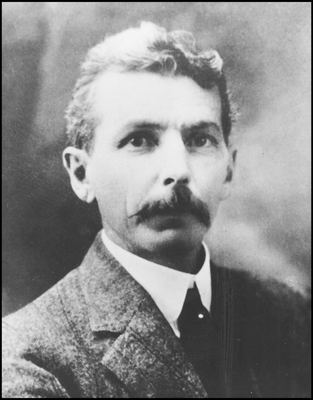 Governor S.V. Stewart appointed John Van Hook as Montana's second State Forester. He was born in Maryland in September 1860. He attended the country school system, and through self-study and practical training, he became a very efficient surveyor. He spent considerable time in the U.S. Geological Survey and the General Land Office. In 1895 he was moved from Washington D.C. to Helena by the U.S. Surveyor General's Office.
Governor S.V. Stewart appointed John Van Hook as Montana's second State Forester. He was born in Maryland in September 1860. He attended the country school system, and through self-study and practical training, he became a very efficient surveyor. He spent considerable time in the U.S. Geological Survey and the General Land Office. In 1895 he was moved from Washington D.C. to Helena by the U.S. Surveyor General's Office.
Van Hook was trained in engineering, and had no formal or practical knowledge of forestry. He had spent several seasons in the field as an examiner for the State Land Office and had been an official in charge of the U.S. Government's exhibit in Paris in 1900 for which he received a medal from the French government. He was in charge of the government's fish, game and forestry exhibit at the St. Louis Exposition of 1903, for which he received another medal from the U.S. Government.
He was one of the best liked men in Helena. On the termination of his second term as State Forester, he was elected as a Commissioner of the City of Helena. John died in Long Beach, CA in 1942 at the age of 82.
Forestry Pioneer
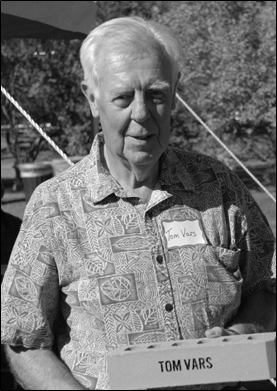 Tom graduated from the University of Idaho with a Bachelor's degree in Forest Management, then started work with the Office of the State Forester in 1955 which became the Department of State Lands and later morphed into DNRC. He was classified as a scaler and at that time the scaler administered timber sales as they scaled the logs in the field. The day started and ended with the logging crew. Extra time was considered "just part of the job." In 1957 he was one of the first Service Foresters in the State involved with the development of the Cooperative Forest Management "CFM" program. His areas of responsibility were Flathead Lake, Lincoln, as well as all the highline counties from Great Falls to Glasgow.
Tom graduated from the University of Idaho with a Bachelor's degree in Forest Management, then started work with the Office of the State Forester in 1955 which became the Department of State Lands and later morphed into DNRC. He was classified as a scaler and at that time the scaler administered timber sales as they scaled the logs in the field. The day started and ended with the logging crew. Extra time was considered "just part of the job." In 1957 he was one of the first Service Foresters in the State involved with the development of the Cooperative Forest Management "CFM" program. His areas of responsibility were Flathead Lake, Lincoln, as well as all the highline counties from Great Falls to Glasgow.
In the early 60's he worked in Missoula in the Fire Program that was to expand fire suppression responsibilities on additional lands in Eastern and Western Montana. Upon Governor Nutter's untimely death, the program went into a state of limbo so he requested a transfer back into forest management.
In 1963 he was involved in the construction of the Swan Forest Headquarters. They were there 10 days then had 4 days off. Nate Hays would be up at 6 a.m., build a fire and roust them out, "So you can get in a decent days work." In the mid 60's through '69 he was in charge of a timber sale preparation crew. They set up administrated sales in the Libby, Eureka, Stillwater, North Fork, Swan, Kalispell, Lincoln and Sula state forests. During this time and in the following years, they located over 400 miles of primary and secondary road systems on State land. The largest single sale he remembers had about 25 miles of new and existing road improvement and 11 million board feet of timber.
From 1969 to 1996 he was assigned to the Stillwater unit. He retired in 1996 after 41 years with State Forestry enjoying every one of them. He says, "I do miss the interaction of a fire team."
In his retirement, taking care of two places, one on Flathead Lake and one near Whitefish tends to keep him busy.
Forestry Pioneer
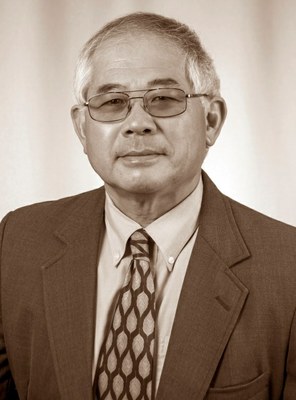 Dr. Ronald H. Wakimoto was a professor of forestry at the University of Montana. He received his bachelor’s degree in forestry and master’s and doctoral degrees in Wildland Resource Science from the University of California at Berkeley. He began his faculty career at UC Berkeley in 1976 and has taught and conducted research in wildland fire management at the University of Montana since 1982.
Dr. Ronald H. Wakimoto was a professor of forestry at the University of Montana. He received his bachelor’s degree in forestry and master’s and doctoral degrees in Wildland Resource Science from the University of California at Berkeley. He began his faculty career at UC Berkeley in 1976 and has taught and conducted research in wildland fire management at the University of Montana since 1982.
Throughout his time at UM, Dr. Wakimoto has worked to support, mentor and advise students of color. He teaches academic courses in Wildland Fire Management, Fuel Management, Fire Ecology and Urban Forestry.
He has conducted research on diverse topics including the effectiveness of fuel management treatments, smoke quantity and quality from smoldering combustion, and crown fire spread.
In 1988 and 1989, Dr. Wakimoto was one of two academics to serve as a technical adviser to the National Fire Policy Review Team following the Yellowstone fire events. He has given testimony to the U.S. House of Representatives concerning wildfire policy three times in his career.
In 2004, Dr. Wakimoto was elected a fellow by the Society of American Foresters. At the national level of SAF, he served four years as the chair for student affairs, and served the past six years on the committee on accreditation. In 1990, he was Montana SAF’s “Forester of the Year.” From 2005 to 2010 he served as the chair of the Department of Ecosystem and Conservation Sciences at UM.
From 2006 to the present Dr. Wakimoto has taught short-courses on fire ecology, prescribed burning, disaster preparedness, fire management strategy development, and fire suppression training in the Kingdom of Bhutan, high in the Himalayas. At the end of 2010, he resigned as department chair and returned to Bhutan for a five-month sabbatical leave from the University. In January 2014, he returned to conduct more fire training in Bhutan. Dr. Wakimoto has given fire training to more than 200 Bhutanese foresters, 40 government administrators, and 120 fire volunteers who represent every fire-prone dzongkhag in the country. In May 2014, he was awarded the H.H. Biswell Lifetime Achievement Award by the Association for Fire Ecology.
Since his retirement in 2015, Ron has been rafting, fishing and hunting in Montana.
Forestry Pioneer
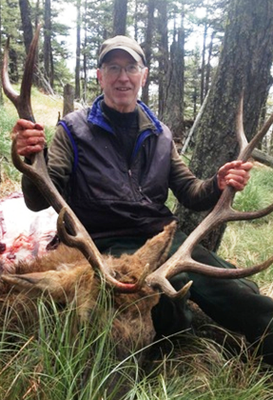 Steve Wallace was born in the midwest, and graduated from Flushing High School in 1967. Before graduation, he joined the U.S. Navy and did two West Pac Cruises to Vietnam on board the USS Ranger CVA 61. After naval service, Steve enrolled at the University of Montana, graduating from the School of Forestry in 1975.
Steve Wallace was born in the midwest, and graduated from Flushing High School in 1967. Before graduation, he joined the U.S. Navy and did two West Pac Cruises to Vietnam on board the USS Ranger CVA 61. After naval service, Steve enrolled at the University of Montana, graduating from the School of Forestry in 1975.
One year later, he was hired by the Montana Department of State Lands (now DNRC) as an inventory forester. Steve worked at Clearwater Unit for the bulk of his career, including as the Clearwater Unit Manager from 1981 until his retirement in 2008.
Forestry Pioneer
Virgil Weaver started with Montana State Forestry in 1948, following a 4 year assignment as a medic with the U.S. Air Force stationed in Las Vegas. His first assignment with the state was at McGregor Lake west of Kalispell where he assisted with the timber management program. For the next 14 years he assisted with management of state forest lands on the Northwestern Land Office. One particular duty he completed annually in the late 1950s and early 1960s was to work with Tom Vars to harvest all of the Christmas trees used by state forestry and government offices in Missoula and Helena.
In 1962 he became the supervisor of the Swan River State Forest and with Jack Dolan oversaw the construction of the new SRSF Headwaters at Goat Creek in 1963. When needed Virgil also played an essential role in fire suppression activities as did virtually all state forestry employees at that time. He moved to the land office in Kalispell where he eventually became the Chief Scaler for the North Western Land Office. He was instrumental in development of the weight based check scaling system which was much more efficient than the previous practice of scaling 100% of all timber cut from state trust lands.
Forestry Pioneer
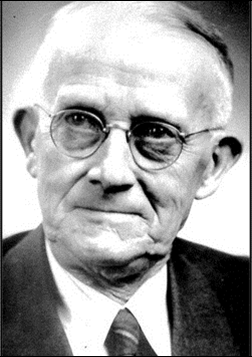 L.L. White was born in 1881 on a farm outside Oskaloosa Iowa. He received his education in a country school and his high school education at the Preparatory Department of Penn College at Oskaloosa. He then attended Penn College and Cornell University in Ithaca New York for a short time in 1903. He received a Masters Degree in Forestry from Yale in 1906. He worked for the U.S. Forest Service for about five years, primarily at the nursery in Halsey Nebraska. He joined the Lumber Department of the Anaconda Company in 1921 as a timber cruiser.
L.L. White was born in 1881 on a farm outside Oskaloosa Iowa. He received his education in a country school and his high school education at the Preparatory Department of Penn College at Oskaloosa. He then attended Penn College and Cornell University in Ithaca New York for a short time in 1903. He received a Masters Degree in Forestry from Yale in 1906. He worked for the U.S. Forest Service for about five years, primarily at the nursery in Halsey Nebraska. He joined the Lumber Department of the Anaconda Company in 1921 as a timber cruiser.
He married Hilda Rittue in 1908 and they had two children. The State Board of Forestry passed a resolution commending him as Assistant State Forester, for his years of "wise, efficient, and loyal service" which was signed by Governor J. Hugo Aronson as Chairman. He died at the age of 75 in December 1956. The presiding minister at L.L. White's funeral commented that he must have been a "man among men." Although the room was crowded, only a few women were in attendance.
Forestry Pioneer
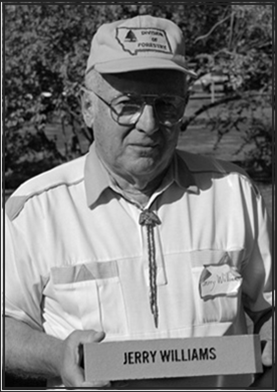 Originally from Des Moines, Iowa, Jerry Williams attended Colorado State University receiving a B.S. in Forestry in 1957. While in school, he worked seasonally for the National Park Service. From 1957-1968 Jerry worked for the South Dakota Department of Game, Fish and Parks as a District Forester Planner and Fire Management Officer. He came to DNRC in 1968 as a Rural Fire Coordinator, and held positions as the Forestry Information Supervisor and a Fire Training Supervisor.
Originally from Des Moines, Iowa, Jerry Williams attended Colorado State University receiving a B.S. in Forestry in 1957. While in school, he worked seasonally for the National Park Service. From 1957-1968 Jerry worked for the South Dakota Department of Game, Fish and Parks as a District Forester Planner and Fire Management Officer. He came to DNRC in 1968 as a Rural Fire Coordinator, and held positions as the Forestry Information Supervisor and a Fire Training Supervisor.
During his career, Jerry organized the Montana/Idaho Interagency Wildfire Training Council, a model used nationally to form other training councils. He introduced the concept of a fire cache on wheels and refurnishing on the fire. He also introduced organized overhead teams and training to the Office of the State Forester. Jerry was the Fire Boss on the first interagency overhead team in Montana Region 1. He was also a charter member of the Training Team of the National Wildfire Coordinating Group representing the western states and developing the national wildland fire training program. Jerry facilitated and managed numerous regional, national and international conferences and meetings for information exchange, problem solving, conflict resolution, teamwork building and course development.
In addition to serving the State of Montana, Jerry served the country in the Army National Guard Reserves from 1957-1995, was enlisted for six years, and was an Officer Helicopter pilot for 32 years. He spent fourteen years as Training Advisor for the Office of U.S. Foreign Disaster Assistance, helping to design and implement a Disaster Management Team program for developing countries of the world. Jerry also advised the United Nations in the development of their Disaster/Risk Management Training Program.
Jerry was a Training Officer for the Montana Department of State Lands from 1982-2003, and now spends much time as President and Manager of the Sonoran Wings Flight Training Center. Jerry says of retirement, "I currently have the State of Montana, State of Arizona, and U.S. Department of Defense paying me to not work for them anymore. Not working is for old people with nothing to do." His longest period of "retirement" has been 21 days.
Forestry Pioneer
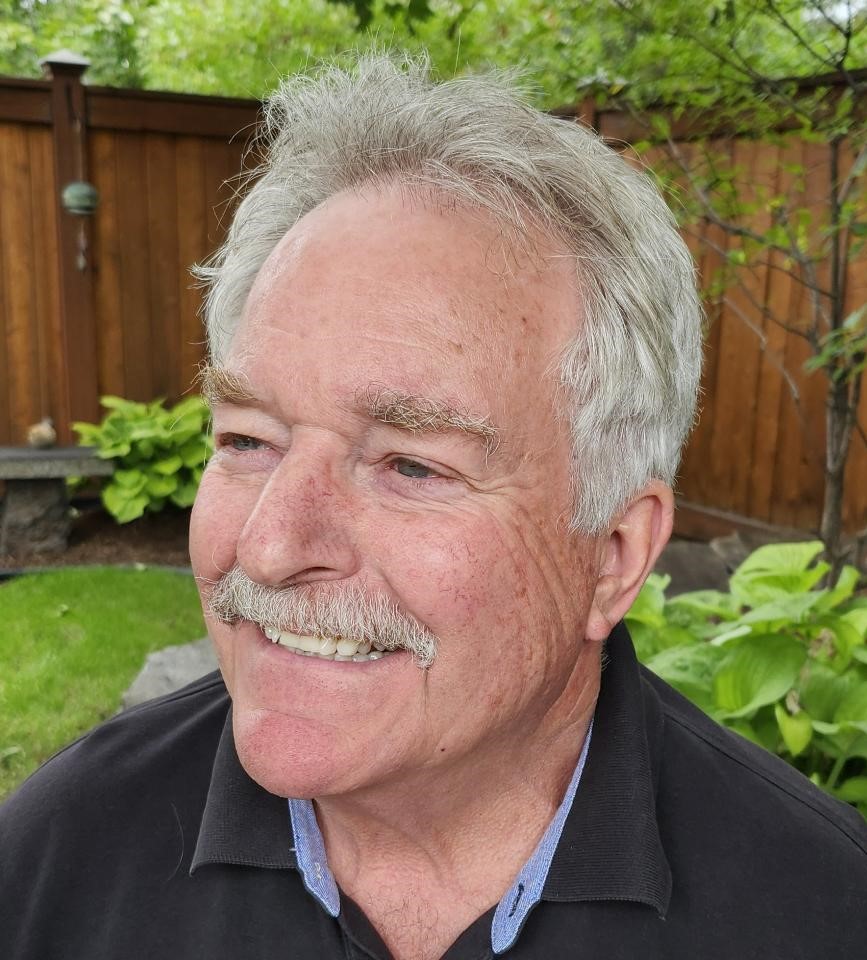 Throughout the course of his career, Jerry actively led, supervised, managed, and administered programs across the full spectrum of wildland fire management. He had direct experience in dealing with federal emergency response efforts on high-profile wildfires and other national significant all-risk disasters, such as the avian bird flu epidemic, the Columbia space shuttle accident, extreme weather events, and the terrorists attacks of 9/11/2001. Jerry’s experience includes crisis management support and oversight with other federal, state, and local government agencies, as well as military units and university programs.
Throughout the course of his career, Jerry actively led, supervised, managed, and administered programs across the full spectrum of wildland fire management. He had direct experience in dealing with federal emergency response efforts on high-profile wildfires and other national significant all-risk disasters, such as the avian bird flu epidemic, the Columbia space shuttle accident, extreme weather events, and the terrorists attacks of 9/11/2001. Jerry’s experience includes crisis management support and oversight with other federal, state, and local government agencies, as well as military units and university programs.
Throughout his career, Jerry was recognized for leading efforts towards a balanced wildland fire management program with prevention, fuels mitigation, and suppression response. And for helping to bring an ecological basis to wildland fire management. He led or co-led several internal USDA Forest Service staffing papers that exemplify this work:
- “Fire-Related Considerations and Strategies in Support of Ecosystem Management” (1993)
- “Fire and Aviation Management Goals and Actions in Support of Ecosystem Management” ( 1994)
- “Course to the Future: Positioning Fire and Aviation Management” (1995)
- “Land Management Considerations in Fire-Adapted Ecosystems: Conceptual Guidelines” (1996)
- “USDA Forest Service Firefighters Code of Safe Practices” (1996)
- “Protecting People and Sustaining Resources: A Cohesive Strategy to Restore Fire-Adapted Ecosystems” (2000)
These documents helped lay the foundation for a substantial increase in hazard mitigation funding, the National Fire Plan (2002) and the Healthy Forest Restoration Act (2004).
FORMAL EDUCATION:
Bachelor of Arts, Lewis & Clark Co1lege, Portland, OR (1973)
Master of Science (Forest Fire Sciences, College of Forestry), University of Washington (1978)
KEY JOB-RELATED TRAINING:
Fire Behavior Analyst (S-590), National Advanced Resource Technology Center, Marana, AZ (1979)Advanced Incident Management (S-520), National Advanced Resource Technology Center, AZ (1988)
Management Policy Seminar, Grey Towers, PA (1994)
Executive Leadership, Charlottesville, VA (1995)
Area Command (S-620), National Advanced Resource Technology Center, Marana, AZ, (1998)
Senior Executive Fellows Program, Kennedy School of Government, Cambridge, MA (2001)
SUMMARY of WORK EXPERIENCE:
2008-Present: Independent Consultant, Heatwave Consulting, Missoula, MT
2005-2008: Senior Advisor (under contract), The Brookings Institution, Washington, DC
2001-2005: National Director of Fire & Aviation Management (Senior Executive Service), USDA Forest Service, Washington, DC
1996-2001: Regional Director of Fire & Aviation Management, USDA Forest Service, Missoula, MT
1994-1996: National Assistant Director of Fire & Aviation Management for Operations (GS-15), USDA Forest Service, Washington, DC
1992-1994: National Branch Chief for Fuel Management and Fire Use (GS- 13/14), USDA Forest Service, Washington, DC
1988-1992: Lolo National Forest Fire Management Officer (GS-12), USDA Forest Service, Missoula, MT
1985-1988: Lolo National Forest Fuel Management/Fire Use Specialist (GS-11), USDA Forest Service, Missoula, MT
1981-1985: Ranger District Fire Management Officer (GS-9), USDA Forest Service, Seeley Lake, MT
1979-1981: Ranger District Assistant Fire Management Officer (GS-7/9), USDA Forest Service, Bend, OR
1976-1979: Smokejumper Supervisor, (GS-7), USDA Forest Service, Redmond, OR
1972-1976: Smokejumper (GS-5/6), USDA Forest Service, Redmond and La Grande, OR
1969-1972: Wildland Firefighter (GS-3/4), USDA Forest Service, McKenzie Bridge, OR
SPECIALIZED EXPERIENCE:
International Team Leader for a global assessment of mega-fires (2010/2011). Commissioned by the Food and Agriculture Organization, United Nations. Rome, Italy
Expert Witness, Blue Ribbon Commission for Black Saturday bushfires (2009/2010), Melbourne, Victoria (Australia)
Board Member, National Interagency Wildfire Coordinating Group (2001-2005), Boise, ID
Commission Member, California Governor's Commission for state-wide wildfire disaster review (2003)
Chairman, Regional Multi-Agency Coordinating Group for Northern Region wildfire emergency (2000
Board Member, Board of Inquiry for Cerro Grande wildfire disaster (2001). Los Alamos, NM
Board Member for Bureau of Land Management smokejumper fatality investigation (2000). Fairbanks, AK
SUMMARY of RECENT KEY SPEECHES and SEMINARS:
"Between a Rock and a Hard Place: Growing Wildfire Threats and the Urgency to Adapt Protection Strategies." Invited opening paper, presented at the International Large Wildland Fires Conference, Missoula, MT (May 2014)
"Growing Wildfire Threats, Protection Objectives at Risk and Some Thoughts About a Strategic Framework Going Forward " Invited opening plenary session paper, presented at the Australasian Fire Authorities Council and Bushfire Cooperative Research Centre Conference, Perth, Australia (Aug 2012)
"High-Impact Wildfires and the Implications for Government." Invited seminar presentation for the School of Forestry, University of Melbourne. Creswick, Victoria (August 2012)
"The Mega-fire Phenomenon in the Western United States: Ecological Perspectives and Factors that Will Likely Influence Future Wildfire Protection. " Invited presentation at the 21st Century Fire Management Seminar, Oregon State University, Corvallis, OR (November, 2012)
"The Onset of Global Mega-fires, Common Characteristics and Their Significance to Policy-Makers. " Keynote Address to Ist International Conference on Mega-fires. Sponsored by Elsevier Publishing. Florida State University, Tallahassee, FL (November 2011)
"The Mega-fire Phenomenon in North America." Keynote presentation at the Annual Forest Industry Lecture Series. Department of Renewable Resources. University of Alberta. Edmonton, Alberta (March, 2010).
"1910 Fires a Century Later, Could it Happen Again?" Invited paper presented at the Inland Empire Society of American Foresters Annual Meeting, Wallace, ID (May 2010)
"Findings and Implications from a Coarse-Scale Global Assessment of Recent Selected Mega-Fires." Invited plenary session paper presented at the 5th International Wildland Fire Conference, Sun City, South Africa (May 2011)
SUMMARY of KEY PUBLICATIONS:
Between a Rock and a Hard Place: Growing Wildfire Threats and the Urgency to Adapt Protection Strategies (in press, Rocky Mountain Research Lab, USDA Forest Service General Technical Report). Proceedings from Large Wildland Fires: Social, Political and Ecological Effects Conference (May 2014), Missoula, MT
Exploring the Onset of High-impact Mega-fires Through a Forest Land Management Prism, by Jerry T. Williams, 2013. Forest Ecology and Management 294 (4-10). Elsevier Publishing
The Mega-fire Phenomenon: Observations from a Coarse-Scale Assessment with Implications for Foresters, Land Managers and Policy-Makers, by Jerry 'f. Williams and Albert C. Hyde, 2009. Proceedings from the 90th Annual Society of American Foresters National Convention, Orlando, FL (October 2009)
The Forest Service and Transitional Fires, by Herman B. Leonard and Jerry T. Williams, 2004. Case Program (CR16-04-l 770.0), Kennedy School of Government. Harvard University, Cambridge, MA
Fire Dynamics in Northern Rocky Mountain Stand Types, by Jerry T. Williams and Richard C. Rothermel. USDA Forest Service Research Note INT-405. June 1992
Forestry Pioneer
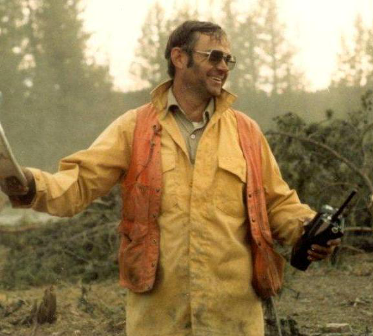
Bill Wright retired from the Northwestern Land Office as the Kalispell Unit Manager.
Forestry Pioneer
Charles Everett "Chuck" Wright, after two years in the Army and four years at the Montana School of Forestry, joined State Forestry in 1959 at the Swan Unit as an Assistant Forest Supervisor to Virgil Weaver. From there he was transferred to Bozeman as a Cooperative Forest Management Forester, from there to Thompson Falls as a Cooperative Forest Management Forester, and from there to Missoula as a Cooperative Forest Management Forester.
By that time he knew enough to be named Cooperative Forest Management Bureau Chief, which included supervising the nursery and the shelterbelt tours. After a steady diet of Cooperative Forest Management work Chuck transferred to Utilization and Marketing and was sent to a special school on the subject held in Wisconsin.
From there he was made Cooperative Forest Management Supervisor, then District Forester, and then Southwest Area Land Manager before retiring.
Forestry Pioneer
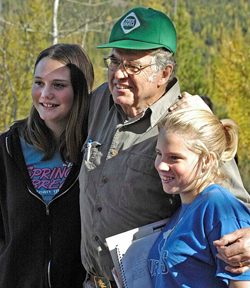 Gene Yahvah earned a BS in Forestry from Colorado State University. He got his start with J. Neils Lumber Company in 1950 and was transferred to Libby in 1961, when St. Regis Paper Company bought J. Neils Lumber.
Gene Yahvah earned a BS in Forestry from Colorado State University. He got his start with J. Neils Lumber Company in 1950 and was transferred to Libby in 1961, when St. Regis Paper Company bought J. Neils Lumber.
Gene worked from 1961-1988 as Area Forest Manager for the St. Regis Paper Company, and later Champion International. He managed 70,000 acres, located primarily in the Middle Fisher River Area under St. Regis, then gained an additional 30,000 acres in the Troy Area under Champion management.
He taught silviculture and associated courses at Selkirk College in Castlegar, British Columbia. He is a Tree Farm Member and active in the Society of American Foresters.
Forestry Pioneer
 Jim Yule pioneered the revolutionary use of aerial photography early in the twentieth century to make maps of the newly established national forests, and thereby led the way to the production of maps of an accuracy, efficiency, detail and caliber never seen before. Moreover, his vision provided access to valuable topographic details never before available, thus providing critical data for not only forest management and conservation, but also for fire detection and suppression, transportation planning, planting, water studies, flood control, erosion practices, range management, timber surveys, mining, agriculture, and beyond. He wrote, “Space does not permit detailed description of aerial photography to all our local industries. But generally, the engineer who is building roads, dams, transmission lines, topographic maps, and other activities of a construction nature is as far behind the times if he isn’t utilizing aerial photography methods as a Chinaman who is still plowing with a crooked stick.” (Yule, 1933)
Jim Yule pioneered the revolutionary use of aerial photography early in the twentieth century to make maps of the newly established national forests, and thereby led the way to the production of maps of an accuracy, efficiency, detail and caliber never seen before. Moreover, his vision provided access to valuable topographic details never before available, thus providing critical data for not only forest management and conservation, but also for fire detection and suppression, transportation planning, planting, water studies, flood control, erosion practices, range management, timber surveys, mining, agriculture, and beyond. He wrote, “Space does not permit detailed description of aerial photography to all our local industries. But generally, the engineer who is building roads, dams, transmission lines, topographic maps, and other activities of a construction nature is as far behind the times if he isn’t utilizing aerial photography methods as a Chinaman who is still plowing with a crooked stick.” (Yule, 1933)
Jim was born in 1884 at Summit Station, Montana Territory, and was raised on a ranch on the Rocky Mountain Front of Montana. His formal education was in a one-room elementary school, the Teton County High School, and three years at the newly established University of Montana in Missoula. He entered the U.S. Forest Service in 1911, just six years after President Teddy Roosevelt had created the agency, and one year after the Great Burn Fire of 1910. His job, along with other new recruits, was to determine the boundaries and topographical details of the new national forests, and to produce maps of them. Surveying with crews, pack animals, mobile field offices and primitive instruments in the wilderness was brutally hard work in demanding conditions, but it was the modus operandi. Jim was convinced there had to be a better way.
By the early 1920’s, Jim understood that aeronautics provided a unique, efficient, and forward-looking way of seeing the earth and articulating that vision into maps that would serve not only the Forest Service but the entire country. Unsupported by his USFS bosses for his impractical idea that had “no future”, he persevered by himself to test his hypothesis that aerial photographs could be used to produce maps of far greater precision and exactitude and at a fraction of the cost of traditional methods. Supported by his peers in Region One and other regions, but dismissed by his superiors, he wrote, talked, and demonstrated his vision to anyone who would listen. Ultimately his development of and leadership in the field prevailed and culminated in the First Maps and Surveys Conference of the USFS in Missoula Montana, May 5th-12th, 1936. Jim’s counterparts from the other nine Regions were present, as were Forest Service leaders from Washington D.C. At that conference, the USFS and the United States Coastal and Geodetic Survey officially accepted Jim’s method of making maps from aerial photographs as the basis for all future cartography, thereby changing history.
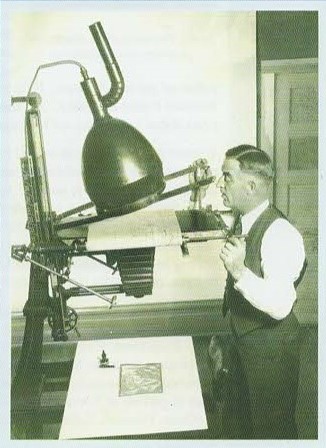 In 2019, the National Museum of Forest Service History (NMFSH) built and dedicated an amphitheater in recognition of the magnitude of Jim Yule’s contributions to the Forest Service and beyond. At that time, Tom Thompson, president of the NMFSH wrote: “Even though he was only able to complete three years at the University of Montana, his career accomplishments and work are widely recognized as unparalleled and truly significant for the City of Missoula, the State of Montana, the U.S. Forest Service, and many other entities who were able to benefit from his contributions, thinking and willingness to step forward with progressive ideas in the early part of the last century. Our Museum has recently recognized the significance of his life’s work by establishing a pavilion and amphitheater on our campus named in his honor. He was a true pioneer.”
In 2019, the National Museum of Forest Service History (NMFSH) built and dedicated an amphitheater in recognition of the magnitude of Jim Yule’s contributions to the Forest Service and beyond. At that time, Tom Thompson, president of the NMFSH wrote: “Even though he was only able to complete three years at the University of Montana, his career accomplishments and work are widely recognized as unparalleled and truly significant for the City of Missoula, the State of Montana, the U.S. Forest Service, and many other entities who were able to benefit from his contributions, thinking and willingness to step forward with progressive ideas in the early part of the last century. Our Museum has recently recognized the significance of his life’s work by establishing a pavilion and amphitheater on our campus named in his honor. He was a true pioneer.”
Looking back on Jim Yule’s work in 2019, 52 years after his death, Dale Bosworth, Chief Emeritus of the U.S. Forest Service wrote, “I believe that the aerial photography pioneered by Yule was as significant at that point in time as satellite imagery is today.”

